Resources | Storytelling | Strategy
50 powerful quotes to start your presentation.

Written by Kai Xin Koh
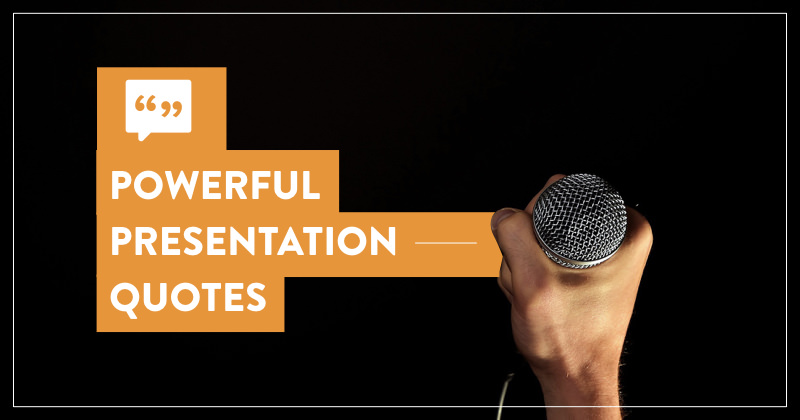
When was the last time you attended a conference where the speaker didn’t just say: “Oh hi, my name is XYZ and today, I’ll be speaking to you about Topic X”?
Great stories possess riveting narrative arcs that begin strong and end strong. We’ve written at length about some of the best ways to end your presentation , but how does one design a presentation to start without sounding too cliche?
One of the most powerful ways to begin a presentation is to start by sharing a powerful and memorable quote that relates to the message of your talk.
Powerful quotes have so much power on your presentation. Not only does it help reinforce your message, it also helps boost your credibility since it implied the quote is ‘agreeing’ with your statement.
Take this TED talk by Andrew Solomon for example. Notice how he skilfully uses a quote from a book by Emily Dickinson to set the stage for his numerous anecdotes regarding the topic on Depression in his presentation:
Hence, if you’re looking to follow suit and start your next presentation strong with a powerful quote, we’ve got you covered. Here, we compiled a list of 50 quotes that you can use to boost your next presentation.
50 Powerful Quotes To Start Your Presentation:
1) “ The secret of getting ahead is getting started.” – Mark Twain
2) “Yesterday’s home runs don’t win today’s games.” – Babe Ruth
3) “ If you can’t explain it simply, you don’t understand it well enough.” – Albert Einstein
4) “ If you’re too comfortable, it’s time to move on. Terrified of what’s next? You’re on the right track.” – Susan Fales Hill
5) “ Your most unhappy customers are your greatest source of learning.” – Bill Gates
6) “ You can’t look at the competition and say you’re going to do it better. You have to look at the competition and say you’re going to do it differently.” – Steve Jobs
7) “ Make every detail perfect and limit the number of details to perfect.” – Jack Dorsey
8) “ Do the one thing you think you cannot do. Fail at it. Try again. Do better the second time. The only people who never tumble are those who never mount the high wire. This is your moment. Own it.” – Oprah Winfrey
9) “ Your smile is your logo, your personality is your business card, how you leave others feeling after an experience with you becomes your trademark.” – Jay Danzie
10) “It takes 20 years to build a reputation and five minutes to ruin it. If you think about that, you’ll do things differently.” – Warren Buffett
11) “Some entrepreneurs think how can I make a lot of money? But a better way is to think how can I make people’s lives a lot better? If you get it right, the money will come.” – Richard Branson
12) “When Henry Ford made cheap, reliable cars people said, ‘Nah, what’s wrong with a horse? ’ That was a huge bet he made, and it worked.” – Elon Musk
13) “There are two types of people who will tell you that you cannot make a difference in this world: those who are afraid to try and those who are afraid you will succeed.” – Ray Goforth
14) “Keep on going, and the chances are that you will stumble on something, perhaps when you are least expecting it. I never heard of anyone ever stumbling on something sitting down.” – Charles F. Kettering
15) “People rarely buy what they need. They buy what they want.” – Seth Godin
16) “Please think about your legacy, because you’re writing it every day.” – Gary Vaynerchuck
17) “The golden rule for every business man is this: Put yourself in your customer’s place.” – Orison Swett Marden
18) “A successful man is one who can lay a firm foundation with the bricks others have thrown at him.” – David Brinkley
19) “Everyone is a genius. But if you judge a fish by its ability to climb a tree, it will spend its whole life believing it is stupid.” – Einstein
20) “The problem with the rat race is that even if you win, you’re still a rat.” – Lilly Tomlin
21) “ When you run a part of the relay and pass on the baton, there is no sense of unfinished business in your mind. There is just the sense of having done your part to the best of your ability. That is it. The hope is to pass on the baton to somebody who will run faster and run a better marathon.” – N. R. Narayana Murthy
22) “Whatever you’re thinking, think bigger.” – Tony Hsieh
23) “When you find an idea that you can’t stop thinking about, that’s probably a good one to pursue.” – Josh James
24) “What would you do if you’re not afraid?” – Sheryl Sandberg
25) “Don’t worry about failure, you only have to be right once.” – Drew Houston
26) “When I’m old and dying. I plan to look back on my life and say ‘Wow, an adventure’ not, ‘Wow, I sure felt safe’” – Tom Preston Werner
27) “80% of your sales comes from 20% of your clients.” – Vilfredo Pareto
28) “You just have to pay attention to what people need and what has not been done.” – Russell Simmons
29) “We are really competing against ourselves, we have no control over how other people perform.” – Pete Cashmore
30) “I skate to where the puck is going to be, not where it has been.” – Wayne Gretzy
31) “Always remember, your focus determines your reality.” – George Lucas
32) “If people like you they’ll listen to you, but if they trust you they’ll do business with you.” – Zig Ziglar
33) “Words may inspire but action creates change.” – Simon Sinek
34) “It isn’t what we say or think that denies us, but what we do.” – Jane Austen
35) “Get action. Do things; be sane; don’t fritter away your time; create, act, take a place wherever you are and be someone; get action.” – Theodore Roosevelt
36) “There is only one boss. The customer.” – Sam Walton
37) “Change will not come if we wait for some other person or some other time. We are the ones we’ve been waiting for. We are the change that we seek.” – Barack Obama
38) “You have to go wholeheartedly into anything in order to achieve anything worth having.” – Frank Lloyd Wright
39) “It always seems impossible until it’s done.” – Nelson Mandela
40) “Some people feel the rain. Others just get wet.” – Bob Marley
41) “There is no great genius without some touch of madness.” – Seneca
42) “If you think you are too small to make an impact try going to bed with a mosquito in the room.” – Ekaterina Walter
43) “If you just work on stuff that you like and you’re passionate about, you don’t have to have a master plan with how things will play out.” – Mark Zuckerberg
44) “I have not failed. I’ve just found 10,000 ways that won’t work.” – Thomas Edison
45) “Things may come to those who wait, but only the things left by those who hustle.” – Abraham Lincoln
46) “Don’t build links. Build relationships.” – Rand Fishkin
47) “100 percent of the shots you don’t take, don’t go in.” – Wayne Gretzky, Hockey Legend
48) “If you’ve got an idea, start today. There’s no better time than now to get going. That doesn’t mean quit your job and jump into your idea 100 percent from day one, but there’s always small progress that can be made to start the movement.” – Kevin Systrom, Founder of Instagram
49) “Good business leaders create a vision, articulate the vision, passionately own the vision, and relentlessly drive it to completion.” – Jack Welch, Former CEO of GE
50) “You must be very patient, very persistent. The world isn’t going to shower gold coins on you just because you have a good idea. You’re going to have to work like crazy to bring that idea to the attention of people. They’re not going to buy it unless they know about it.” – Herb Kelleher, Founder of Southwest Airlines.
There you have it!
Phew! – now you have an additional 50 powerful quotes that you can add in your presentation arsenal. Leave an unforgettable impression on your presentation with these quotes starting today!
Comment down your favourite quote. And let us know if you have any that we didn’t add to the list!
Article Written By: Kai Xin Koh
You may also like….

Val Yap: Delivering Success Through Effective Communication
by Kai Xin Koh
Success is not dictated by the hard work of one person alone. A great leader is also a great story-teller because effective communication is the foundation of any successful organisation.

Infographic Template Editor Site Review: Venngage
Introduction If you’re...

How to Compress PowerPoint Presentations in 2023 : Complete Guide For Mac and Windows
by Eugene Cheng
Imagine this - it’s late at night and you’re finishing up your last few slides for your big presentation tomorrow. You’ve done your final check and...
Sign Up for Winning With Stories!
- First Name *
- Phone This field is for validation purposes and should be left unchanged.

Ace the Presentation

55 Powerful and Inspiring Quotes to Start Your Presentation
Have you ever stopped to think about the best strategies to start a presentation and gain the audience’s attention or interlocutor? Did you know that using motivational phrases to create a presentation is a great alternative?
It doesn’t matter if you’re a student and you’re presenting a paper, or if you’re a renowned speaker. Knowing how to speak well in public implies several factors, and at any moment of your speech is a crucial moment to ensure that the presentation is successful.
According to businessman and filmmaker Peter Davies,
“Motivation is like food for the brain; you can’t have enough at a meal. Motivation needs continuous and regular recharges to nurture deep and transform a human being into a winner.”
Among the techniques you can and should use, the citation should undoubtedly be among the main in your list.
A relevant quote, which is aligned with the theme of its presentation, tied to the purpose and objective, creates a strong connection with the audience, often arousing interest and attention.
An unforgettable introduction is the first step in starting a presentation or speech. Often, we are focused only on the content presented, completely forgetting that, for the public to pay attention, it is necessary to arrest them from the beginning.
5 Best Techniques to start a Presentation or Speech
- Quote someone else
Opening your presentation with a relevant quote can help set the whole tone for the rest of your speech. However, when making the quote, you need to remember two essential things: a) Quote the source of the sentence and b) “Tie it” to the central theme of the presentation.
However, an important point to consider when speaking in public: Citations will depend on the style of the audience, and the moment the presenter lives. Do not push too hard or adopt a tone of voice or language that does not suit the public.
- Don’t be afraid to use humor.
A touch of humor is a great way to break the ice with the audience, relieve tension and connect with everyone. As the example given above quote, the key to success is making the joke related to the topic being discussed.
If this tip is not your style, you can address the other information in this article.
During the presentation, telling a story is another very clever way to start a speech. After all, stories compellingly connect people.
But, as in the case of jokes, your story needs to bridge or contain a message that can link the introduction to the presentation
‘s content.
An excellent way to use storytelling is by using an “imaginary” scenario, but that is your life story; this will leave the participants interested and can identify better with you.
- Be bold and use a striking phrase.
This technique consists of giving a brief thought-provoking statement, which will set the tone of the presentation theme, especially if this is said with a strong voice, which draws attention and leaves the group ready to hear what’s next.
Therefore, when you start the speech, you can speak a bold and striking phrase and use the silence technique later, increasing the effect of the phrase.
In this sense, an example of an excellent way to catch the public’s attention is to say the sentence and pause, up to 10 seconds.
This plan will make the audience anxious and attentive.
- Cite notable statistics
Using surprising statistics will show the public an immediate value in their knowledge, leaving them more interested throughout their presentation.
It also helps stimulate the audience’s thoughts; this technique works very well when the facts reported are not common knowledge but are nevertheless relevant and stimulating.
Please make sure to be brief in the opening statement, so your opening won’t get too many easy-to-forget details.
1. “Success is most often achieved by those who don’t know that failure is inevitable.” Coco Chanel
We are often afraid to start a project no matter how much we have ideas that are outside the box, and when compared to other people, we thought that this would not be successful.
This phrase from Coco Chanel helps us understand that to be successful, and we need to subject ourselves to error sometimes.
2. “No one can make you feel inferior without your consent.” Eleanor Roosevelt
We have here a phrase from one of the strong women of history known as the defender of human rights unless we identify ourselves with what people think of us; none has power over what we are and want to be.
3. “Failure is another steppingstone to greatness.” Oprah Winfrey
With the illustrious phrase of another inspiring woman Oprah Winfrey, it became clear how error always has a positive side; getting it right is not always what we need from error comes the improvement of an idea that can continuously be improved.
4. “The whole secret of a successful life is to find out what is one’s destiny to do, and then do it.” Henry Ford
If we discover what makes us happy, we can always succeed because happiness is the path of inspiration that leads us to unimaginable ways.
5. “A belief is only a thought you keep thinking.” Abraham Hicks
Beliefs are socialized since we were born, depending on the socio-cultural context and the people around us. Anything is possible if you think so.
6. If you don’t like something, change it. If you can’t change it, change your attitude. Maya Angelou
Often we can criticize something or behavior when we think we can do better; Angelou encourages us to get up and do it. If we still can’t change, maybe we have to change our attitude towards the situation that bothers us.
7. If you cannot do great things, do small things in a great way. Napoleon Hill
Sometimes we think that success comes from great attitudes, and from thinking so much about an idea that surpasses all the others, we stand by and do nothing. Napoleon Hill encourages us to start step-by-step and what matters here is how we make it small or big.
8. Innovation, as I understand it, is both about doing different things as well as doing things differently.” Kiran Mazumdar-Shaw
Sometimes we need to get out of our comfort zone, and for that, we need not only to experience things we’ve never done before, but the way can also lead us to new paths.
9. “Your time is limited, so don’t waste it living someone else’s life. Don’t be trapped by dogma – which is living with the results of other people’s thinking.” Steve Jobs
When we choose the course we want to take in college, we often choose a course that our parents choose, and that doesn’t make us happy, which we shouldn’t do because we are supposed to live for ourselves and our happiness.
10. “Always remember that you are unique. Just like everyone else.” Margaret Mead
Every human being is unique in its way, and our particular way of being cannot be compared to any other. Hence we need not be afraid when we do something new, even if someone else has already done it.

Have you ever stopped to think about the best strategies to start a presentation and gain the audience’s attention or interlocutor? Did you know that using motivational phrases to create a presentation is a great alternative? It doesn’t matter if you’re a student and you’re presenting a paper, or if you’re a renowned speaker. Knowing…
Click Here to Read More…
5 QUICK TIPS ON HOW TO GIVE AN EFFECTIVE MOTIVATIONAL SPEECH

This post is part 3 of a series of posts that where we will be sharing with you quick tips on how to deliver all types of speech that we mentioned in our most-read post on this blog, 10 Types of Speeches. Instead of just telling you that there is a motivational speech or an…
26 Motivational and Inspirational Quotes on Life, Success, and Positive Thinking to Make Your Day

If you came here looking for short, but powerful motivational and inspirational quotes that will lift you up when you are feeling discouraged, or share a pearl of wisdom and help you achieve success in your endeavors, then you have come to the right place. Motivational and Inspirational Quotes have a great effect on us….
11. “Don’t judge each day by the harvest you reap but by the seeds that you plant.” Robert Louis Stevenson
This means that sometimes we will have bad days and things will be difficult, but this does not mean that we will not have good days, so we must always be kind and cheerful.
12. “Do not go where the path may lead, go instead where there is no path and leave a trail.” Ralph Waldo Emerson
It’s much easier to follow the path that many people have taken may seem safer. Yet, here Emerson suggests that choosing a direction is knowledge, adventure, or whatever it is we decided to learn new things and share with other people that would be the trail.
13. “People do not decide to become extraordinary. They decide to accomplish extraordinary things.” Edmund Hillary
People aren’t born brilliant. They make decisions and make choices that push outside the box and are exceptional.
14. “Always dream and shoot higher than you know you can do. Don’t bother to be better than your contemporaries or predecessors. Try to be better than yourself.” William Faulkner
Faulkner encourages us to be our competence, neither that of descendants or ascenders nor anyone but ourselves. Hold your hand and go hard.
15. “Designing a presentation without an audience in mind is like writing a love letter and addressing it ‘to whom it may concern.” Ken Haemer
You have got to prepare yourself for whichever situations or people you’re going to come across in different environments and conditions so that you don’t do things that don’t make sense.
16. Some people feel the rain. Others get wet.” Bob Marley
We can interpret this Bob Marley phrase as when faced with a chaotic situation, some people will despair, and others will calm down, focus, and look at the problem as an opportunity. Who the hell are you?
17. “When I’m old and dying. I plan to look back on my life and say ‘Wow, an adventure’ not, ‘Wow, I sure felt safe.’” Tom Preston Werner
Werner means to live your life without fears and live your life intensely because you never know how it will be tomorrow.
18. Get action. Do things; be sane; don’t fritter away your time; create, act, take place wherever you are and be someone; get action.” Theodore Roosevelt
Roosevelt encourages us to get better lives by doing something, turning into reality our dreams by consistently taking action.
19. “Change will not come if we wait for some other person or some other time. We are the ones we’ve been waiting for. We are the change that we seek.” Barack Obama
It’s for no one but ourselves that we need to improve or reinvent ourselves.
20. You have to go wholeheartedly into anything to achieve anything worth having.” Frank Lloyd Wright
Wright tells us that following our heart is the best way to reach out to more incredible things in life; anything we put, our real feelings and natural energy will glow.
21. “It always seems impossible until it’s done.” Nelson Mandela
With this simple phrase, Mandela brings us a crucial message to live an extraordinary life; when we start by somewhere and are not there yet, it seems unreachable but never is if we don’t give up trying.
22. “There are only two days of the year when you can do nothing: one is called yesterday and the other tomorrow” Dalai Lama
Don’t leave for tomorrow what you can do today; live each day as if it were your last.
23. “In the end, everything works out, and if it didn’t work, it’s because it hasn’t come to an end” Fernando Sabino
What Sabino means is you have to be patient because someday, our time to shine will come.
24. “The pessimist sees difficulty at every opportunity. The optimist sees opportunity at every difficulty” Winston Churchill
When we sync our minds to positive thinking, anything we face is reachable, and we get things done because everything turns into an opportunity to learn and grow.
26. “You have to be a protagonist. You can’t just listen to the band play, and you have to be part of the band” Sonia Hess
In life, we face many situations that we work and live with people, but we don’t need to be ordinary because we are not; we have to show and give our best in anything we do.
27. Our failures are sometimes more fruitful than our successes” Henry Ford
With mistakes, we learn, we improve, and one day we reach perfection.
28. “Change your mind and change your world” Norman Vincent Peale
If we have an open mind, we will find that our way of thinking is not always the right one, and when we change our review, we will be able to put it into practice in our lives.
29. “One day you must stop dreaming, take the plans out of the drawer and somehow start” Amyr Klink
Klink encourages us to materialize any ideas or dreams we may have and not spend days only daydreaming about them.
30. “The greatest discovery of all time is that a person can change, simply by changing his attitude” Oprah Winfrey
Sometimes the attitude we face in certain realities is the ones that prevent us from enjoying more extraordinary things in life. So you may want to think about some philosophy or way of thinking that you could use a change.
31. “Keep in mind that your desire to achieve success is more important than anything” Abraham Lincoln
What Lincoln means is that we must work hard to achieve our goals and put them as priorities in life if we want to achieve them.
32. “Be content to act. Leave the speech to others” Baltasar Gracián
This means to live your life no matter what other people think; if you are happy with it, be gentle with yourself.
33. “To achieve success, you need to accept all the challenges that lie ahead of you. You can’t just accept the ones you prefer” Mike Gafka
Gafka means that Challenges turn us better if we submit to the lesson they have to teach us.
34. “A successful warrior is an average man, but with a sharp focus like a laser beam” Bruce Lee
Lee means that even though a warrior is seen with prestige, he is a regular man. Still, the difference between them and what he is, is how he put attention to what he wants, and we can compare that analogy with daily situations such us when we see some people more successful than others.
35. “Logic can lead from point A to point B. Imagination can lead anywhere” Albert Einstein
Things go far beyond what they seem to be, don’t focus on the obvious, and also see subtexts.
36. “The task is not so much to see what no one has seen, but to think what no one has thought about what everyone sees.” Arthur Schopenhauer
Schopenhauer gives us a lesson about creativity; most of the time, we look for new ideas that no one ever thought about; however, imagination can recreate helpfully something that already exists.
37. “It is much better to set out in search of great conquests, even exposing oneself to failure, than to align oneself with the poor in spirit, who neither enjoy much nor suffer much, because they live in a grey gloom, where they know neither victory nor defeat.” Theodore Roosevelt
Living adventurously and risky is much more satisfying and rewarding than having a monotonous and safe life.
38. “What we predict rarely occurs; what we least expect usually happens.” Benjamin Disraeli
This means always to expect the unexpected.
39. “Unless we change our way of thinking, we will not be able to solve the problems caused by the way we get used to seeing the world.” Albert Einstein
Einstein encourages us to see situations more dynamically because we socialized in a certain way with ease; our thoughts can become a cycle of ignorance.
40. “Persistence is the least path to success.” Charles Chaplin
Chaplin means that we insist and don’t give up on what we want to do. Indeed, we are going to make it no matter how much time it takes.
7 Steps for Writing an Inspiring Graduation Speech

You were chosen to make the graduation speech of your class, you were pleased by the trust placed by your colleagues, but now you face a problem: the blank page of Word waits to be filled with inspirational words. First thing, breathe out and relax; everyone who has ever made a graduation speech has faced…
3 KEY Things For Delivering a Successful Speech

Have you ever had to give a speech and have no idea how to direct their thoughts or start talking? In this article, we will discuss in a straightforward way how to work the oratory to develop the ability to speak well with different audiences, arousing their attention, respect, and provoking reflections. Speeches are moments…
41. “To discover consists in looking at what everyone is seeing and thinking something different.” Roger von Oech
This means that we have to think like no one ever thought or even imagined to discover something.
42. “Sometimes we feel that what we do is only a drop of water in the sea. But the sea would be smaller if it lacked a drop”. Mother Teresa de Calcuta
We all make a difference in this world; every soul counts, and every opinion counts either. Please don’t give up on sharing what you got because it is critical.
43. “The more our knowledge increases, the more evident is our ignorance.” John F. Kennedy
The more things you learn, the more things you need to learn because no one can know anything about anything.
44. When everything seems to be going against you, remember that the plane takes off against the wind, not in his favor.” Henry Ford
Remember that Henry Ford suggested the car model we use today back in his time, and nobody but him believed it was possible, he had nobody but himself to hold hands. Don’t give up.
45. “No matter how slow you go, as long as you don’t stop.” Confucius
Do things in your time and never give up.
46. “An entrepreneur sees opportunities where others see only problems.” Michael Gerber
Someone who sees a chance to grow in any situation is a winner, and he has nothing to lose because, in any position of life, we can get something that could be what we didn’t expect.
47. Choose a job you like, and you won’t have to work a single day of your life.” Confucius
If you choose a job that you love, you don’t feel like you’re working; you’re doing a leisure activity.
48. “Success is not the key to happiness. Happiness is the key to success. If you love what you do, you will succeed.” Albert Schweitzer
As Nga, a rapper, says, there is no way to happiness because happiness is when we vibrate good feelings, especially do things we love, life becomes more accessible.
49. “Don’t play games you don’t understand, even if you see many other people making money with them.” Tony Hsieh
Don’t do things through other people’s influence to make your life easier.
50. “Nothing great has ever been achieved without enthusiasm.” Ralph Waldo Emerson
When we do things without good energy, they can easily be ruined.
51. “The thoughts we choose to have are the tools we use to paint the picture of our lives.” Louise Hay
Your way of thinking will determine the course of our lives, which means always be open to new forms of thinking so you can live in a more inclusive World.
52. “Success is born of wanting, determination, and persistence in reaching a goal. Even not reaching the target, who seeks and overcomes obstacles, at least will do admirable things.” José de Alencar
What Alencar means is that when we want something, even if we don’t get what we were thinking at first, we always get something.
53. “To act, that is the true intelligence. I will be whatever I want. But I have to want whatever it is. Success lies in being successful, not in being able to succeed. Palace conditions have any wide land, but where will the palace be if they don’t do it there?” Fernando Pessoa
Pessoa says that when we want something, conditions don’t determine if we thrive or not, but our vibration towards it and that will makes us anything we desire.
54. “You can get anything you want in life if you help other people get what they want.” Zig Ziglar
If you are kind to other people, they will give back in the future.
55. I like the impossible because there is less competition.” Walt Disney
Walt means that the unthinkable doesn’t exist; most people can’t perseverance, so he does because few people can.
How you open your presentation determines how interested the public will be in what will be said afterward. So, when thinking about how to start a speech or presentation, evaluate if your introduction is completely bland; this will be the initial message that the audience will get from the speaker and the display itself.
Reference and Further Reading
Ace The Presentation. Amadebai, E. 11 Best Body Language Tips for Engaging Presentations.
Ace The Presentation. Amadebai, E. 120 Persuasive Speech Topics.
Ace The Presentation. Amadebai, E. 8 Awesome Persuasive Speech Techniques.
Ezine Articles. Toney, B (2011). Key Elements of a Persuasive Speech.
Similar Posts

The Purpose of Speech Explained
If you ever find it unnecessary, out of fashion, dull, or even have no idea what speeches are for, this article is undoubtedly for you. With each word of this article, you will understand the real purpose of the speeches, how they arose, and what usefulness they bring to our day-to-day lives. What is a…

The 7 Best Apps For Developing Communication Skills
Whether you’re a verbose social butterfly or a quiet social observer, we can all afford to improve our communication skills. Having the ability to convey a message or meaning directly in a way that will be immediately understood is an underrated talent. Fortunately, there are great tools and apps at your disposal to help improve…

15 Ideas To Make A Speech Unique, Memorable & Inspiring
Are you often called to speak in front of others? If yes, then the art of making your speech unique, memorable, and inspiring is something you should be able to do with little or no effort. This is important because listening to a yawn-inducing and lifeless speech is one of the worst things your audience…

How to Prepare and Deliver a Great Memorized Speech
A memorized speech can be a real nightmare; We easily forget most things even setting schedules and alarms, or asking a friend to remind us about important things to do proves to be a challenge sometimes – now imagine memorizing an entire speech. Today we will learn a bit about how to prepare ourselves and…

How to Outline A Speech – Easy 4-stage Strategy
INTRODUCTION The art of speech outlining is such that anybody trying to make a public presentation should give strict adherence to. If you came here asking ‘how to outline a speech?’, then rest assured, you will learn how to craft an effective speech outline by the time you finish reading this article. When you organize…

Eulogy Guide: How to Write and Give a Heartfelt Funeral Speech (with 4 Eulogy examples)
Eulogy Definition According to the dictionary a eulogy is simply a formal expression of praise for the deceased. It is a way of saying good bye while telling some of the most vivid memories and deeds of the deceased, as well as what he/she meant to the speaker or those in attendance. Death can come…
Blog > Powerful Quotes for your PowerPoint Presentations
Powerful Quotes for your PowerPoint Presentations
07.24.20 • #powerpointtips.
One of the most powerful ways to begin a presentation is to start by sharing a influential and morable quote that relates to the message of your talk. This can loosen up the beginning, consciously encourage important things while speaking or end the presentation with a meaningful conclusion and underline the main topic again.
This will bring liveliness and power to your presentation and create a more pleasant environment for your audience!
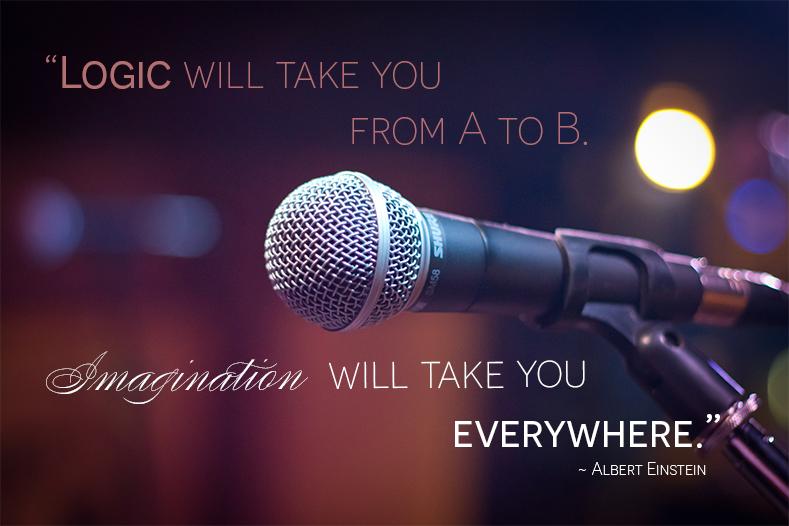
Quotes can be funny, inspirational, profound, successful, motivational, meaningless or basically everything! The most important thing is that they fit the today´s topic, correspond to the situation. This means, that they are appropriate and reinforce the actual theme.
If you are looking for great lines you can use in your PowerPoint or other presentations, you are perfectly right here! Read the following article to get inspired and to find a suitable citation you can use for your speech in school, work, business or anywhere and to leave an unforgettable impression on your presentation.
To save time, we have already created PowerPoint Templates below, which you can download for free!
According to time:
Quotes for Beginning
Quotes while presenting, quotes for ending.
According to category:
In case you need more specific citations, have a look at different sections of quotes:
Inspirational / Motivational
With quotations to open your presentation you can represent yourself in a great authentic and relaxed way. The audience gets an exciting insight into the upcoming topic and in the best case can relate with the citation and thus build a sympathetic bond to you as the presenter. And all this is achieved by just one simple sentence.

Powerful quotes to start your presentation
- "The secret of getting ahead is getting started." - Mark Twain
- "If you can’t explain it simply, you don’t understand it well enough." – Albert Einstein
- "Words may inspire but action creates change." – Simon Sinek
- "Some people feel the rain. Others just get wet." - Bob Marley
- "A successful man is one who can lay a firm foundation with the bricks others have thrown at him." – David Brinkley
- "Yesterday’s home runs don’t win today’s games." - Babe Ruth | Baseball Legend
- "Your most unhappy customers are your greatest source of learning." - Bill Gates
- "It takes 20 years to build a reputation and five minutes to ruin it. If you think about that, you’ll do things differently." - Warren Buffett
- "The golden rule for every business man is this: Put yourself in your customer’s place." - Orison Swett Marden
- "You can't blame gravity for falling in love." - Albert Einstein
Using powerful citations while speaking makes your presentation much more exciting and memorable. A meaningful quotation gives your words much more power and emphasis and can additionally emphasize important things. Furthermore, if a listener hears a mentioned citation of your presentation one more time, he will most likely remember you.

Powerful quotes to reinforce essential topics
- "Some entrepreneurs think how can I make a lot of money? But a better way is to think how can I make people’s lives a lot better? If you get it right, the money will come." - Richard Branson
- "When Henry Ford made cheap, reliable cars people said, ‘Nah, what’s wrong with a horse?’ That was a huge bet he made, and it worked." - Elon Musk
- "Please think about your legacy, because you’re writing it every day." – Gary Vaynerchuck
- "Everyone is a genius. But if you judge a fish by its ability to climb a tree, it will spend its whole life believing it is stupid." - Albert Einstein
- "When you find an idea that you can’t stop thinking about, that’s probably a good one to pursue." – Josh James
- "Don’t worry about failure, you only have to be right once." – Drew Houston
- "You just have to pay attention to what people need and what has not been done." - Russel Simmmons
- "If people like you they’ll listen to you, but if they trust you they’ll do business with you." – Zig Ziglar
- "Don’t build links. Build relationships." – Rand Fishkin
- "There is no great genius without some touch of madness." – Seneca

With citations you have the opportunity to clarify the topic just dealt with in one sentence and it is highly recommended to use this chance. Your audience will remember the end best, as it is the shortest, so it should be well chosen and memorable. It should also match your personality as well as the theme and be catchy.
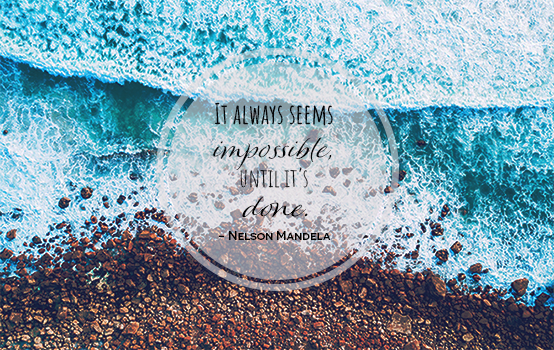
Powerful quotes to close your presentation
- "100 percent of the shots you don’t take, don’t go in." – Wayne Gretzky | Hockey Legend
- "When I’m old and dying. I plan to look back on my life and say ‘Wow, an adventure’ not, ‘Wow, I sure felt safe.’" – Tom Preston Werner
- "I skate to where the puck is going to be, not where it has been." – Wayne Gretzy
- "It isn’t what we say or think that denies us, but what we do." – Jane Austen
- "Get action. Do things; be sane; don’t fritter away your time; create, act, take a place wherever you are and be someone; get action." – Theodore Roosevelt
- "Change will not come if we wait for some other person or some other time. We are the ones we’ve been waiting for. We are the change that we seek." – Barack Obama
- "You have to go wholeheartedly into anything in order to achieve anything worth having." – Frank Lloyd Wright
- "It always seems impossible until it’s done." – Nelson Mandela
- "I have not failed. I’ve just found 10,000 ways that won’t work." – Thomas Edison
- "If you think you are too small to make an impact try going to bed with a mosquito in the room." - Ekaterina Walter
Best citations by category

- "Try not to become a man of success. Rather become a man of value." - Albert Einstein
- "Stop chasing the money and start chasing the passion." - Tony Hsieh
- "The way to get started is to quit talking and begin doing." - Walt Disney
- "Logic will get you from A to B. Imagination will take you everywhere." - Albert Einstein
- "He who only does what he can will always remain what he is." - Henry Ford

- "Success is like being pregnant, everybody congratulates you, but nobody knows how many times you got fucked." - Author unknown
- "If you want your children to listen, try talking softly to someone else." - Ann Landers
- "The difference between stupidity and genius is that genius has its limits." - Albert Einstein
- "Anger is a hot coal that you hold in your hand while waiting to throw it at someone else." - Buddha

- "Either you run the day or the day runs you." - Jim Rohn
- "It's the will not the skill." - Jim Tunney
- "Happiness is the real sense of fulfillment that comes from hard work." - Joseph Barbara
- "I have never done that before so I should definitely be able to do it!" - Pippi Longstocking
- "The only thing that overcomes hard luck is hard work." - Harry Golden

- "Paying attention to simple little things that most men neglect makes a few men rich." - Henry Ford
- "The prize for success is that it unlocks harder challenges with more at stake for next time." - Author unknown
- "The opposite to good design is always bad design. There is no such thing as no design." - Adam Judge

- "A man is a success if he gets up in the morning and gets to bed at night, and in between he does what he wants to do." - Bob Dylan
- "The whole secret of a successful life is to find out what is one’s destiny to do, and then do it." - Henry Ford
- "If you want to be happy, be happy." - Leo Tolstoy
- "So far you have survived 100% of your worst days." - Author unknown
- "Great Lessons are only learned when the stakes are high." - Georgina Hobart
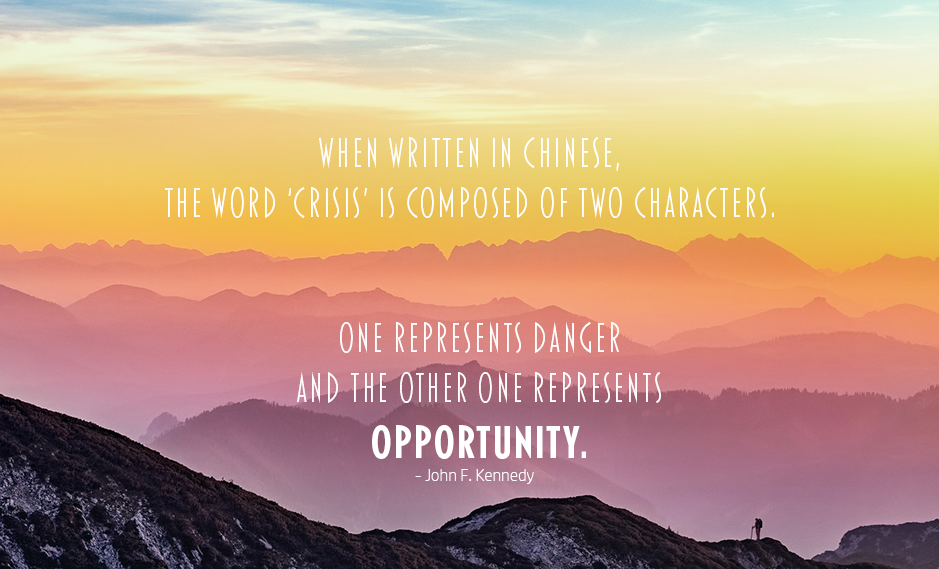
- "When written in Chinese, the word 'crisis' is composed of two characters. One represents danger and the other represents opportunity." - John F. Kennedy
- "When in doubt, don't." - Benjamin Franklin
- "The higher we are placed, the more humbly we should walk." - Marcus Tullius Cicero
- "Easy choises, hard life. Hard choices easy life." - Jerzy Gregorek
- "What you begrudge others will be withheld from yourself." - Author unknown
Now you have 60 quotes you can incorporate into your presentation to stand out from the everyday, all-too-familiar phrases that everyone knows.
But remember: Under no circumstances should they be discriminatory, racist or offensive, so you need to make yourself known in advance through your audience.
Leave your personal impression and convince your audience with simple but incredibly strong lines!
Free PowerPoint Templates
In addition, we have already created some PowerPoint templates for you, which you can download for free. Simply replace the existing quotes or image if you want and adapt the slides to your presentation!
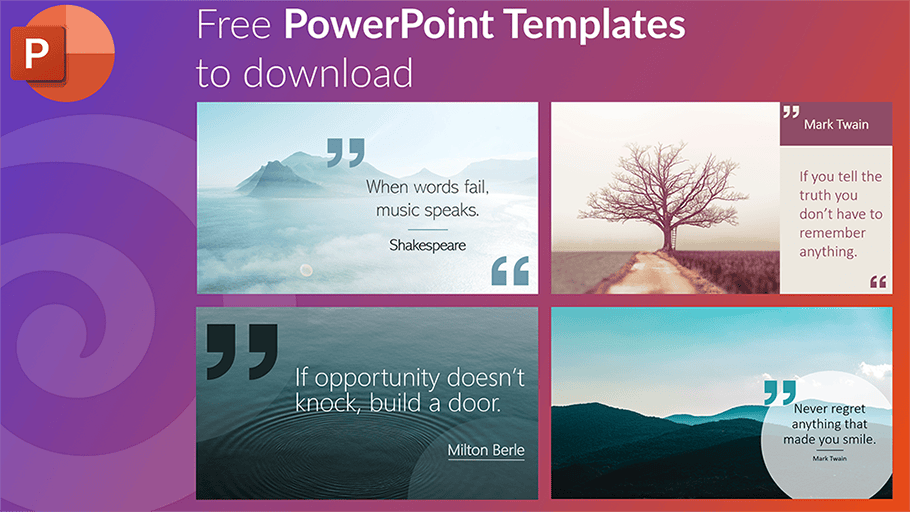
What are good quotes for starting a presentation?
By opening your presentation with a quote you can represent yourself in an authentic way. The audience gets an exciting insight into the upcoming topic and in the best case can relate with the quote and thus build a sympathetic bond to you as the presenter. And all this is achieved by just one simple sentence. Here is a list of good quotes to begin a presentation .
What are good quotes for ending a presentation?
With citations you have the opportunity to clarify the topic just dealt with in one sentence and it is highly recommended to use this chance. Your audience will remember the end best, so it should be well chosen and memorable. It should also match your personality as well as the theme and be catchy. Here is a list of good quotes to finish a presentation .
What are powerful quotes for a PowerPoint presentation?
One of the most powerful ways to begin a presentation is to start by sharing a influential and memorable quote that relates to the message of your talk. This can loosen up the beginning, consciously encourage important things while speaking or end the presentation with a meaningful conclusion and underline the main topic again. We have collected 60 powerful quotes for your PowerPoint presentation .
Related articles
About the author.

Philipp Angerer
Philipp is a creative supporter at SlideLizard in marketing and design. There he uses his imagination and provides creative freshness, also in blog articles.

Get 1 Month for free!
Do you want to make your presentations more interactive.
With SlideLizard you can engage your audience with live polls, questions and feedback . Directly within your PowerPoint Presentation. Learn more

Top blog articles More posts

Create Venn diagram + free PowerPoint template

Corporate Design in Presentations - the Key to Strengthening Corporate Identity

Get started with Live Polls, Q&A and slides
for your PowerPoint Presentations
The big SlideLizard presentation glossary
Virtual audience.
A virtual audience consist of people who join an event / a meeting / a presentation via an electronic device (computer or smartphone) over the Internet. Each member may be located in a different place while an event takes place. Virtual audiences are becoming increasingly important as the amount of events held online is rising.
Vocalized pause
A vocalized pause means the pause when the silence between words is filled by the speaker with vocalizations like "um", "uh" and "er".
External Communication
External communication is the exchange of information between two organisations. For example, it can be an exchange with customers, clients or traders. Feedback from a customer also counts as external communication.
Body language
Body language is communication through movements, hand gestures and body posture.
Be the first to know!
The latest SlideLizard news, articles, and resources, sent straight to your inbox.
- or follow us on -
We use cookies to personalize content and analyze traffic to our website. You can choose to accept only cookies that are necessary for the website to function or to also allow tracking cookies. For more information, please see our privacy policy .
Cookie Settings
Necessary cookies are required for the proper functioning of the website. These cookies ensure basic functionalities and security features of the website.
Analytical cookies are used to understand how visitors interact with the website. These cookies help provide information about the number of visitors, etc.
Click to copy
Email copied!
How to Start a Presentation with Impact + 12 Examples!
December 1, 2023

In the world of snooze-worthy presentations, your opening is your moment of truth. Knowing how to start a presentation—be it a sales presentation, an investor pitch, a conference keynote, or an internal team update—sets the tone for everything that follows. The best way to open your presentation? Forget about overly complicated introductions, because you’ll want to use your initial seconds to pique genuine curiosity and capture attention.
Whether it's through a thought-provoking quote, a stunning visual, a brief yet impactful video, an engaging question, or an interactive poll, the goal is to make your audience sit up and take notice, avoiding the common pitfall of starting with an 'about me' narrative. Remember, in these moments, your story is less about you and more about resonating with your audience. Wondering how you can craft an opening that not only grabs attention but also holds it? Here’s how to make sure your message sticks the landing.
How to Start Your Sales Presentation with Impact
The opening of a sales presentation is crucial in setting the stage for what you're offering. It’s your chance to grab the audience's attention and make them eager to hear more about your product or service. We might specialize in PowerPoint design services, but we’re also suckers for punchy openings and clever wordsmithing. Here are five dynamic ways to start your sales presentation to engage your audience effectively. After all, who’s going to buy from you if your presentation isn’t engaging?
Interesting Statistics
Begin your presentation with a statistic that highlights a problem or opportunity relevant to your audience. For instance, if you’re selling a cybersecurity solution, you might start with, "Did you know that cyber attacks are increasing at an alarming rate of 30% per year?" This kind of opening not only grabs attention but also establishes the importance of your product or service. The more attention-grabbing, the better!
Compelling Questions
Asking a thought-provoking question can immediately engage your audience. It encourages them to think and become active participants. For example, "Have you ever considered how much time we waste on inefficient processes?" This approach works well in highlighting the pain points that your product or service can address.
Presentation Storytelling
Stories are powerful tools for connection, no doubt. Start with a short, relatable story that illustrates the need for your product or service. A narrative about a common challenge and how your product provided a solution can be very effective. For instance, "Let me tell you about a client who was struggling with..."
Visual Impact
Using a striking visual can be a great way to start a sales presentation. A compelling image or a brief video that gets your message across can make a strong impression. This could be as simple as a before-and-after scenario, showcasing the effectiveness of your product.
Bold Statements
Kick off with a bold, intriguing statement that makes the audience sit up and take notice. It should be directly related to the benefits of your product or service. For example, "We're not just changing the game–we're redefining it." This kind of opening sets a confident tone for the rest of your presentation.

How to Start Your Investor Pitch Presentation
Presenting to investors is a unique challenge. You need to quickly establish credibility and capture their interest. Here are five effective strategies for opening your investor presentation to ensure you make a lasting impression.
Visionary Opening
Begin with a powerful vision statement that encapsulates the essence and ambition of your business. This could be a glimpse into the future that your company is striving to create. For example, "At the heart of our company lies a vision to revolutionize sustainable energy for generations to come." This approach instantly sets a high-level tone and shows investors the potential impact of your business.
Compelling Problem Statement
Start with a clear and compelling description of the problem your business aims to solve. This not only highlights the need for your solution but also demonstrates your understanding of the market. For instance, "In a world where over 30% of produced food is wasted, our solution offers an innovative way to reduce this drastically."
Success Story
Share a brief story of a significant milestone or success that your company has achieved. This could be about landing a major client, a breakthrough in your technology, or a notable growth milestone. This kind of opening underlines your company's potential and track record.
Surprising Fact or Stat
Kick off with a surprising fact related to your industry that sets the stage for your presentation. This should be something that highlights the market opportunity or the need for your solution. For instance, "In the $2.2 trillion food industry, a shocking 30% of produce goes to waste. Our solution tackles this inefficiency head-on."
Personal Journey
Starting with a brief narrative about why you founded the company can be a powerful way to connect with investors on a more personal level. It adds a human element to your presentation, allowing investors to understand your passion and commitment. For example, "My journey to founding this company began five years ago when I encountered..."

How to Start a Keynote Presentation
Keynote talks are an opportunity to inspire, influence, and leave a lasting impression on your audience. The opening of your talk is critical in setting the stage for your message. These are our favorite ways to hook your audience from the get-go.
Inspirational Quote
Open with a quote that resonates with the theme of your talk. Choose a saying from a well known person that gets the basic idea of your message across. For instance, "As Nelson Mandela once said, 'It always seems impossible until it’s done.' Today, we explore the 'impossible'." This approach connects your audience to something that feels familiar and sets a reflective tone for the rest of the presentation.
Intriguing Question
Pose an intriguing question to your audience that provokes thought and relates directly to your topic. This could be a rhetorical question or one that challenges common perceptions. For example, "Have you ever wondered what truly drives innovation in our fast-paced world?" This strategy engages your audience’s curiosity right from the start.
Personal Anecdote
Sharing a personal story that relates to your keynote theme can create an immediate emotional connection with your audience. It adds a personal touch and makes your message more relatable. Begin with, "Let me share a personal experience that profoundly changed my perspective on..." Remember to avoid going on about yourself, and instead focus on how the experience relates to the rest of your presentation.
These are all effective ways to make presentation storytelling lots more engaging. You can also use the previous suggestions of beginning the presentation with a visual hook or surprising fact to hook your audience from the start.

How to Start Your Internal Team Meeting Presentation
Nobody wants their internal updates to prompt “couldn’t this be an email?” comments from their colleagues. For internal updates, the approach should be distinctively different, focusing on team engagement, shared goals, and collective progress. Here’s what we suggest for your presentation to ensure your team is attentive and motivated.
Celebratory Kick-Off
Begin with a celebration of a recent achievement or milestone. This could be team-centric, like reaching a project goal, or company-wide, such as a notable business success. For example, "I am thrilled to start today by celebrating our team's achievement in surpassing our quarterly targets."
Progress Highlight
Start by highlighting progress on key projects or initiatives. This could be a brief overview of where things stand or a specific success story. It’s a great way to show the team that their efforts are leading to tangible results. For instance, "Let's kick off by looking at the incredible progress we've made on the X project in the last month."
Team Member Spotlight
Open by spotlighting a team member's contribution or achievement. This not only recognizes individual efforts but also fosters a culture of appreciation and motivation. For example, "I want to begin today's meeting by highlighting James' outstanding contribution to our client project last week."
Industry News or Trends
Start with a brief discussion on relevant industry news or trends that might impact your team or company. This keeps the team informed and can start discussions on how these developments might affect your work. For example, "Let's start with some interesting developments in our industry that could present new opportunities for us."
Each of these approaches is designed to create an engaging and inclusive atmosphere for internal updates. The focus is on building team morale, encouraging participation, and keeping everyone aligned with the company’s goals and achievements.

Recap: 12 Examples for Starting Your Presentation with Impact
To wrap up, let's compile three actionable examples for each type of presentation we've discussed. These examples are designed to be directly applicable, giving you a practical blueprint for engaging your audience right from the beginning of your presentation.
Sales Presentations
Statistic-based .
"Every year, businesses lose approximately $1.7 trillion due to inefficiencies in communication. Today, we introduce a solution that turns this challenge into an opportunity."
Question-Based
"How many of you have experienced frustration due to delayed flights? Our app is here to change your travel experience forever."
"Last year, a small business owner faced a daunting challenge with their supply chain. Our software transformed their process, resulting in a 40% increase in efficiency."
Investor Presentations
Vision statement.
"We envision a future where renewable energy is not a luxury, but a norm for every household. Our technology is the key to this future."
Problem Statement
"In a world where online privacy is constantly under threat, our platform provides an unbreachable shield, safeguarding digital identities."
"Just six months ago, our prototype caught the attention of industry giants, leading to a groundbreaking partnership that sets us on a path to revolutionize our field."
Keynote Talks
"Margaret Mead famously said, 'Never doubt that a small group of thoughtful, committed citizens can change the world.' This idea is at the core of our discussion today."
"What if I told you that the biggest barrier to innovation is not a lack of ideas, but a lack of action? Let’s explore this further."
Visual Display
"This image [showing a powerful photograph] represents the drastic change our industry has undergone in the last decade. Let's dive into what this means for us."
Internal Updates
"I'm excited to announce that thanks to our team's efforts, customer satisfaction has hit an all-time high this quarter!"
Interactive Element
"To get us started, I'd like everyone to share one word that describes their current project experience."
Industry News
"Recent developments in AI technology have opened new avenues for our projects. Let's discuss how we can integrate these into our workflow."

These examples offer a versatile range of strategies to effectively start your presentations, tailored to the specific context and audience of your talk. Whether it’s a sales presentation, an investor pitch, a conference keynote, or an internal team update, using these examples as a guide can help you grab your audience's attention and keep them engaged throughout. Presenting is not easy, but a good opening will give you the confidence boost that can help you throughout your talk. Here’s to less-boring presentations!
Recent articles
View all articles

Our client Delphina raises $7.5M in seed funding
Customer stories

13 Best Free Stock Photo Sites You Need for Your Business [2024 update]
Presentation resources
50 quotes to enhance your presentations
- Written by: Shay O’Donnell
- Categories: Sales presentations , Visual communication
- Comments: 6
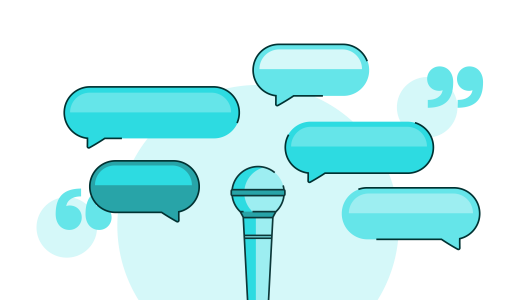
Whether you’re looking to inspire your audience, need a strong presentation starter, or want a concise soundbite to end your presentation with, using a quote in your presentation can be a great way to support your slides’ story and enhance your presentation’s flow. Presentation quotes give you – as the presenter – a moment to breathe, while the audience is reading the slide ( a reminder of why you shouldn’t be reading your quotes aloud is here ). They enable your audience to quickly and concisely understand your presentation’s key message, and give you an extra boost of credibility to boot.
The struggle comes when you have to find presentation quotes that fit your story, come from a reputable source, and have an attribution to get you through legal and compliance checks. But worry not: BrightCarbon have done the hard work for you!
We have compiled 50 presentation quotes and categorized them into 10 themes so that you can easily find a quote that resonates with your message, be it in a sales presentation, keynote speech, or training deck. All the quotes include references and attributions, so that you can sail through compliance and get on with creating a stunning presentation!
Pop this in your bookmarks tab (you’ll thank us later!), then dig in and find the perfect presentation quotes below:
Innovation quotes for presentations
- “Innovation, as I understand it, is both about doing different things as well as doing things differently.” Kiran Mazumdar-Shaw, Biotech Entrepreneur From an interview with Dr. Bhavana Weidman on nature.com (January 04, 2014)
- “Innovation is more than having new ideas: it includes the process of successfully introducing them or making things happen in a new way. It turns ideas into useful, practicable and commercial products or services.” John Adair, Writer on Business Leadership. Effective Innovation (2009), Revised Edition ch. 11
- “Every new thing creates two new questions and two new opportunities.” Jeff Bezos, Founder and CEO of Amazon From ‘The electricity metaphor for the web’s future’, presented at TED2003 (February 2003)
- “Innovation is fostered by information gathered from new connections; from insights gained by journeys into other disciplines or places; from active, collegial networks and fluid, open boundaries. “Innovation arises from ongoing circles of exchange, where information is not just accumulated or stored, but created. Knowledge is generated anew from connections that weren’t there before.” Meg Wheatley, Author and Management Consultant Leadership and the New Science (2001)
- “We are all looking for the magic formula. Well, here you go: Creativity + Iterative Development = Innovation.” James Dyson, Founder of Dyson ‘James Dyson on Innovation’, Ingenia , Issue 24 (September 2005)

Design quotes for presentations
- “Good design begins with honesty, asks tough questions, comes from collaboration and from trusting your intuition.” Freeman Thomas, Automobile and Industrial Designer Reviving Professional Learning Communities: Strength Through Diversity, Conflict, Teamwork, and Structure (2012) p. 63
- “The urge for good design is the same as the urge to go on living. The assumption is that somewhere, hidden, is a better way of doing things.” Harry Bertoia, Artist and Designer As quoted in 1000 Chairs , Carlotte and Peter Fiell (2005) p. 66
- “People think it’s this veneer — that the designers are handed this box and told, ‘Make it look good!’ That’s not what we think design is. It’s not just what it looks like and feels like. Design is how it works.” Steve Jobs, Chairman and CEO of Apple Inc. As quoted in ‘The Guts of a New Machine’, Rob Walker, The New York Times Magazine (November 30, 2003)
- “Design is redesign.” Jan Michl, Professor Emeritus, Phdr. History and Theories of Design ‘On seeing design as redesign’, Scandinavian Journal of Design History , Issue 12 (2002) p. 7-23
- “Design is not about products, design is about relationships.” Hella Jongerius, Industrial Designer ‘Beyond the New: a search for ideals in design’, a manifesto by Hella Jongerius and Louise Schouwenberg (2015)

Education and learning quotes for presentations
- “We are now at a point where we must educate our children in what no one knew yesterday, and prepare our schools for what no one knows yet.” Margaret Mead, Anthropologist and Author As quoted in How They Work In Indiana : Business-Education Partnerships , Andrew L. Zehner (1994)
- “The most important thing any teacher has to learn, not to be learned in any school of education I ever heard of, can be expressed in seven words: Learning is not the product of teaching. Learning is the product of the activity of learners.” John Holt, Author and Educator Growing Without Schooling , Issue 40 (1984)
- “True education means fostering the ability to be interested in something.” Sumio Iijima, Physicist ‘About myself, To the younger generation’, Innovative Engine (September 25, 2007)
- “If you think education is expensive — try ignorance.” ‘Ask Ann Landers’ Syndicated Advice Column (October 4, 1975)
- “The mind is not a vessel to be filled, but a fire to be kindled.” Plutarch, Greek Historian, Biographer, and Essayist On Listening to Lectures

Success quotes for presentations
- “Success is fucking up on your own terms.” Guillermo del Toro, Director and Producer From Portland Mercury Q&A (September 29, 2010)
- “We cannot say what brings us success. We can only pin down what blocks or obliterates success. Eliminate the downside, the thinking errors, and the upside will take care of itself. This is all we need to know.” Rolf Dobelli, Author and Businessman The Art of Thinking Clearly (2013)
- “The secret to success is the willingness to serve without aspiring for rewards.” Cham Joof, Gambian Historian Gambia, Land of our heritage, p IV
- “Failure and success are not episodes, they are trajectories. They are tendencies, directions, pathways. Each decision, each time at bat, each tennis serve, each business quarter, each school year seems like a new event, but the next performance is shaped by what happened last time out, unless something breaks the streak. The meaning of any particular event is shaped by what’s come before.” Rosabeth Moss Kanter, Author and Management Consultant Confidence (2006)
- “Success is more than a good idea. It is timing.” Anita Roddick, Founder of The Body Shop From an interview on bookbrowse.com

Creativity quotes for presentations
- “Relaxed, playful and harmonious moments are the birth place of creativity.” Amit Ray, Author and Spiritual Master Meditation: Insights and Inspiration (2010) p. 58
- “Originality is going back to the origin and finding an empty chair. Would you gladly sit on it? No thank you. It is empty for a reason. That’s where my ass was. Not where my head is now.” Giannina Braschi, Puerto Rican Poet, Novelist, and Essayist World Literature Today (2012)
- “Creativity isn’t about the advantage or disadvantage of a specific time or culture. Creativity is something that comes internally from a human being having a genuine mistrust of rules. And that may be the constant. It’s almost like there’s some rebellion in it.” Paula Scher, Graphic Designer From an interview conducted by Neal Shaffer (2006)
- “Ideas are like rabbits. You get a couple of them and learn how to handle them, and pretty soon you have a dozen.” John Steinbeck, Author Conversations with John Steinbeck , ed. Thomas Fensch (1988)
- “Creativity arises out of the tension between spontaneity and limitations, the latter (like the river banks) forcing the spontaneity into the various forms which are essential to the work of art or poem.” Rollo May, Psychologist and Author The Courage to Create (1975) p. 115

Teamwork and collaboration quotes for presentations
- “In organizations, real power and energy is generated through relationships. The patterns of relationships and the capacities to form them are more important than tasks, functions, roles, and positions.” Margaret Wheatley, Management Consultant As quoted in 100 Ways to Motivate Yourself , Steve Chandler (2004) p. 123
- “Life is not a solo act. It’s a huge collaboration.” Tim Gunn, Fashion Consultant and Author ‘Postings | Recent Entries From Our Blogs’, Tara Parker-Pope, The New York Times (December 21, 2010)
- “Collaboration is important not just because it’s a better way to learn. The spirit of collaboration is penetrating every institution and all of our lives. So learning to collaborate is part of equipping yourself for effectiveness, problem solving, innovation and life-long learning in an ever-changing networked economy.” Don Tapscott, Business Executive and Consultant ‘The spirit of collaboration is touching all of our lives’, The Globe and Mail (June 7, 2013)
- “As you navigate through the rest of your life, be open to collaboration. Other people and other people’s ideas are often better than your own. Find a group of people who challenge and inspire you, spend a lot of time with them, and it will change your life.” Amy Poehler, Actress, Comedian, Director and Producer From The Joy of Success: What It Means to Transform Success Into Excellence, Tochukwu O. Okafor MPA (2013) p. 53
- “Talent wins games, but teamwork and intelligence wins championships.” Michael Jordan, Basketball Hall of Fame Player and Businessman As quoted in The Victory Letters : Inspiration for the Human Race , Cheri Ruskus (2003) p. 68.

Knowledge quotes for presentations
- “While knowledge is increasingly being viewed as a commodity or intellectual asset, there are some paradoxical characteristics of knowledge that are radically different from other valuable commodities. These knowledge characteristics include the following: Using knowledge does not consume it. Transferring knowledge does not result in losing it. Knowledge is abundant, but the ability to use it is scarce. Much of an organization’s valuable knowledge walks out the door at the end of the day.” Kimiz Dalkir, Director at McGill School of Information Studies Knowledge Management in Theory and Practice, 2nd ed . (2011)
- “Somewhere, something incredible is waiting to be known.” Carl Sagan, Astronomer and Popular Science Writer From That’s Weird!: Awesome Science Mysteries , Kendall F. Haven (2001)
- “Investing in people is the single most important thing in the knowledge economy. Traditionally, wealth was defined by land and natural resources. Today the most important resources is between our ears.” Barack Obama Remarks by President Obama at Young Southeast Asian Leaders Initiative Town Hall, University of Malaya, Kuala Lumpur, Malaysia (April 27, 2014)
- “You can’t manage knowledge – nobody can. What you can do is to manage the environment in which knowledge can be created, discovered, captured, shared, distilled, validated, transferred, adopted, adapted and applied.” Chris Collison and Geoff Parcell Learning to Fly – Practical Knowledge Management from Leading and Learning Organizations (2005) p. 24-25
- “The Information Age offers much to mankind, and I would like to think that we will rise to the challenges it presents. But it is vital to remember that information — in the sense of raw data — is not knowledge, that knowledge is not wisdom, and that wisdom is not foresight. But information is the first essential step to all of these.” Arthur C. Clarke, Science Fiction Writer, Inventor, Futurist As quoted in ‘Humanity will survive information deluge — Sir Arthur C Clarke’, OneWorld South Asia (December 5, 2003)

Leadership quotes for presentations
- “Successful people become great leaders when they learn to shift the focus from themselves to others.” Marshall Goldsmith, Leadership Coach What Got You Here Won’t Get You There (2010) p. 72
- “Ultimately a genuine leader is not a searcher for consensus, but a molder of consensus.” Martin Luther King, Jr. From an address at the Episcopal National Cathedral, Washington D.C. (March 31, 1968)
- “You can’t lead from behind your desk, you’ve got to get out in front, be visible, for your customers as well as for your employees. During a crisis, you’ve got to be calm and confident. You’ve got to always tell the truth. And you’ve got to be willing to face a crisis, not shy away from it, embrace it.” Geisha Williams, Fortune 500 Businesswoman ‘Geisha Williams: Set Your Sights High, Take Charge and Keep the Lights On’, Leadership California , Carol Caley (February 17, 2014)
- “Courage is the main quality of leadership, in my opinion, no matter where it is exercised. Usually it implies some risk — especially in new undertakings. Courage to initiate something and to keep it going, pioneering and adventurous spirit to blaze new ways, often, in our land of opportunity.” Walt Disney As quoted in The Disney Way Fieldbook, Bill Capodagli and Lynn Jackson (2000) p. 147
- “Embrace what you don’t know. What you don’t know can become your greatest asset. It ensures that you will absolutely be doing things different from everyone else.” Sarah Blakely, Founder of Spanx ’10 Lessons I Learned from Sara Blakely That You Won’t Hear in Business School,’ Forbes , Kathy Caprino (May 23, 2012)

Mistakes and failure quotes for presentations
- “We tell our young managers: ‘Don’t be afraid to make a mistake. But make sure you don’t make the same mistake twice’” Akio Morita, Co-Founder of Sony Corporation As quoted in The Sony Vision , Nick Lyons (1976) p. 101
- “There is no such thing as failure. Failure is just life trying to move us in another direction.” Oprah Winfrey Commencement address at Harvard University (30 May 2013)
- “Doubt kills more dreams than failure ever will.” Suzy Kassem, Author Rise Up And Salute The Sun (2010)
- “Don’t put limitations on yourself. Other people will do that for you. Don’t do that to yourself. Don’t bet against yourself. And take risk. NASA has this phrase that they like, “Failure is not an option.” But failure has to be an option. In art and exploration, failure has to be an option. Because it is a leap of faith. And no important endeavor that required innovation was done without risk. You have to be willing to take those risks. … In whatever you are doing, failure is an option. But fear is not.” James Cameron, Film Director From ‘Before Avatar … a curious boy’, presented at TED2010 (February 13, 2010)
- “I view this year’s failure as next year’s opportunity to try it again. Failures are not something to be avoided. You want to have them happen as quickly as you can so you can make progress rapidly.” Gordon Moore, Engineer and Co-Founder of Intel Corporation ‘An Interview with Gordon Moore’, Ingenuity 5 (2), Laura Schmitt (May 2000)

Planning and strategy quotes for presentations
- “Chance favours the prepared mind.” Louis Pasteur, Microbiologist, Chemist and Inventor Lecture, University of Lille (December 7, 1854)
- “The essence of strategy is choosing what not to do. ” Michael Porter, Economist, Researcher, Author ‘What is strategy?’ Harvard Business Review (November 1996) p. 70
- “Business strategy is the battleplan for a better future.” Patrick Dixon, Author and Business Consultant Building a Better Business (2005)
- “Managers who extensively plan the future get the timing wrong. Sometimes they arrive to market too early and so must wait for the demand to catch up. Sometimes they are too late and so must accelerate to rejoin the future.” Shona L. Brown and Kathleen M. Eisenhardt Competing on the Edge: Strategy as Structured Chaos (1998) p.135
- “Strategy is about stretching limited resources to fit ambitious aspirations.” K. Prahalad, Organizational Theorist As quoted in The Wal-Mart Way , Don Soderquist (2005) p. 178

We hope you found what you needed from our list of presentation quotes! If you’re about to paste that quote onto your deck, but want to know how to format it to perfection, check out our guide to advanced typography in PowerPoint .
Have an idea for a quote we should add to the list? Is there a key theme you want some presentation quotes for? Let us know in the comments below!

Shay O’Donnell
Managing design consultant, related articles, making accessible elearning content.
- Effective eLearning / Visual communication
When done well, eLearning can be a truly effective and engaging learning tool. An eLearning module that works for some learners, but leaves others unable to access the content, isn’t doing its job. This is why accessibility in eLearning is so important. Let's discuss...

Review: Storyboard That
- Presentation technology / Visual communication
Storyboarding is useful when creating visual content. We review Storyboard That, a website that enables users to create their own cartoon storyboards.

Review: Visme
Visual content – infographics, images and animations – can be a much more engaging way of presenting information than text. We at BrightCarbon believe in and share this kind of philosophy with Visme...
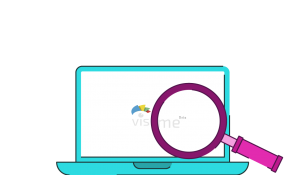
Thanks for this post.It’s a helpful quotes for enhance slides.
Glad it was useful Amit! Thank you for your feedback.
it helped me a lot… thanks!
Amazing Quotes. Really Good. These quotes help me making my presentation perfect Thanks & Regard vinita
Thanks for this post
thanks for information
Leave a Reply Cancel reply
Save my name and email in this browser for the next time I comment.
Join the BrightCarbon mailing list for monthly invites and resources
I did not think it was possible for an external team to get our message so quickly and accurately. You got our messages better than we did, and delivered presentations that were slick and really effective. Guy Shepherd Bouygues

- Speech Writing
- Delivery Techniques
- PowerPoint & Visuals
- Speaker Habits
- Speaker Resources
Speech Critiques
- Book Reviews
- Browse Articles
- ALL Articles
- Learn About Us
- About Six Minutes
- Meet Our Authors
- Write for Us
- Advertise With Us
How to Use Quotes in Your Speech: 8 Benefits and 21 Tips
In this article, we examine eight benefits of using quotations in your speech, and then discuss twenty-one tips for superpowering your speech with effective quotes.
- Speech Quotations
- Rhetorical Questions
- Triads (the Rule of Three)
- Parallelism
Benefits of Using Quotations in Your Speech
There are numerous benefits to crafting quotations into your speech, including:
- The primary reason to quote material in your speech is that it reinforces your ideas . A quotation offers a second voice echoing your claims, but is more powerful than simply repeating yourself in different words.
- Quotations usually offer a concise, memorable phrasing of an idea. (This is why the quotation gets remembered and repeated, isn’t it?)
- Using a quotation boosts your credibility because it implies that the person you are quoting agrees with the rest of your argument.
- Most people do not have the ability to spontaneous offer relevant quotes to support their statements. So, when you deliver a quotation, it demonstrates your domain knowledge and preparation .
- Quotations are one way to add variety to your logical arguments , along with facts, statistics, stories, metaphors, and other material. Audiences get bored if you offer a one-dimensional string of arguments of the same type.
- Depending on how you deliver the quotation, you can create anticipation, suspense, or drama . For example, if you begin “Microsoft founder Bill Gates once said…” followed by a pause, then your audience will surely anticipate your next words. What did he say? What did he say?
- Conversely, you might choose a quotation which adds humor to your presentation , due to the content of the quote or perhaps the person you are quoting.
- If you are delivering with visuals, you might choose to display the quotation on a slide and let your audience read it. This creates a natural and purposeful pause in your vocal delivery , allowing you to check your notes, take a sip of water, and collect your thoughts.
Tips for Using Quotations in Your Speech
Okay, you are convinced of the benefits of incorporating quotations into your speech. But how do you do it? Who should you quote? When should you give the quotation? Read on to discover numerous tips for using quotes effectively in your presentations.
Do your Research
- Make sure you get the phrasing correct. A quotation should boost your credibility, but quoting inaccurately weakens your credibility. A sloppy quotation makes you look lazy.
- Get a reliable source. Wikipedia doesn’t count. Your credibility is on the line.
- Beware quoting out-of-context. Be careful when quoting material on controversial topics. Make sure you understand the intent of the speaker, not only their words. A quotation taken out of context where you’ve garbled the meaning makes you look like you are deliberately misleading your audience.
Quote People Your Audience Knows
- Quote a well-known expert in the field. Don’t quote individuals based purely on their fame or success; base your decision on their expertise in the subject area you are talking about. Quote Aristotle on philosophy or Serena Williams on tennis — doing the opposite gets you in trouble.
- Quote a lesser-known expert in the field, but only with background context. If your desired quote comes from someone who your audience won’t immediately recognize, you’ll need to introduce the speaker and establish their credibility before delivering their quote.
- Quote an earlier speaker at your event. Suppose you are speaking at an event where an earlier speaker made some statements relevant to your message. Referring back to their words will not only impress your audience, but also capitalize on the earlier speaker’s effectiveness.
- Quote yourself (playfully). I’ve done this many times, and it always receives a positive audience response. One way I do this is to introduce a particularly important point as “Dlugan’s First Law of ( whatever topic I’m speaking on )”
Use your own words to open and close; quote in the middle.
- Open your speech with a quote (sparingly). Starting with a quote can be effective, but don’t assume just any quotation will grab your audience’s attention. I’ve watched speakers open with a quotation that wasn’t very powerful, and even irrelevant to their content. There are usually more powerful ways to grab your audience’s attention.
- Avoid closing your speech with a quote. I have heard speeches end strong with a quotation, usually when the quote refers back to the beginning. However, I would not advise it generally. Your final words should be your own. Ending with a quote is often a sign that you don’t have confidence in your own words.
- Quotations work best in the body of your speech. The best time to introduce a quote is when you need more support for one of your arguments. One particularly effective time is near the end of a section. Reinforcing your arguments with a quotation brings good closure to your argument.
Draw attention to the quote through your delivery.
- The traditional formula is okay. Most quotations are introduced simply: Albert Einstein once said “It’s not that I’m so smart, it’s just that I stay with problems longer.” This simple formula is clear, direct, and acceptable.
- Reading the quote from notes is okay. When possible, I would advise delivering the quote from memory. But sometimes, reading it can be better. If the quote is lengthy, for example, it’s better to read it to ensure you are accurate. Even a short quote can be read from notes effectively. I once saw a speaker who produced the note paper from his pocket, and was almost reverent as he read it. In this case, it could be argued that not reading it would have been disrespectful.
- Or, let your audience read the quote. If you are using visuals, you might choose to display the quotation. When you do this, do NOT read it to your audience. Let them read it. (Remember, you should never read material to your audience when they can see the words.) This technique has an added benefit: you can stylize the slide to add impact. For example, you might add a photo of the speaker, or perhaps use a font which conveys mood.
- Pause before and after. You should pause briefly before the quote (a little suspense, and to grab attention) and then a little longer after the quote (to allow the meaning of the quotation to be absorbed by your audience.) Give the quotation respect, and let its impact be felt.
- Spice up your vocal delivery. Of course, you should be varying your voice throughout your presentation. Just like other key statements in your speech, a quotation deserves a little extra vocal emphasis. Maybe louder, maybe softer. Maybe happier, maybe sadder. Let the mood of the quote guide your delivery.
- Set the context when necessary. Some quotations stand on their own, but other quotations won’t be effective unless you establish the context first. A quotation which has your audience guessing is a missed opportunity. Perhaps you need to give the historical context, or explain something about the life of the speaker. Make sure the quotation has maximum impact.
Use trustworthy sources.
- Quotation compilations keep quotes within arm’s reach. Every serious speaker should own at least one quotation compilation. ( Bartlett’s Familiar Quotations is my personal favorite, ever since I first found a copy of a previous edition on my brother’s bookshelf 30 years ago.) A well-edited compilation provides several sort indices to help you find the perfect quote faster. An added benefit is that these types of sources should be trustworthy.
- Biographies of famous people in your field are also rich sources. For example, a biography on Steve Jobs is sure to have numerous quotable lines on his business philosophy. Like quotation compilations, biographies are generally trustworthy.
- Online quotation search engines offer unparalleled breadth. Quotation websites help you find quotations using a given keyword or spoken by a given person. It’s quick and easy, but the sources cannot always be trusted. Whenever I use these sources, I seek out a second source to verify. (Be careful, many quotation websites might use the same flawed source…)
Be selective.
- Don’t use a quote that everyone knows. If your audience has heard the quote before, you will receive virtually no benefit from repeating it.
- Don’t overdo it. There’s no rule about how many quotes you should use, but their effectiveness gets diluted if you use too many. Remember that your speech should primarily be told with your words, not someone else’s. Keep just the best quotes you found in your research, and trim the others.
What do you think?
How do you like using quotations in your speeches? Please share with others by adding a comment .
Please share this...
This is one of many public speaking articles featured on Six Minutes . Subscribe to Six Minutes for free to receive future articles.
Add a Comment Cancel reply
E-Mail (hidden)
Subscribe - It's Free!
Similar articles you may like....
- 15 Tactics to Establish Ethos: Examples for Persuasive Speaking
- What is Ethos and Why is it Critical for Speakers?
- Ethos, Pathos, Logos: 3 Pillars of Public Speaking
- 10 Presentation Bad Habits My College Students – And You – Must UN-Learn (Part 2)
- How to Research Your Speech Topic
- Presentation Power: Four Ways to Persuade
Find More Articles Tagged:
16 comments.
Excellent post. Doing your research is vital. In January I blogged about some people who quoted Penn State football coach Joe Paterno after he’d gone from famous to infamous: http://joyfulpublicspeaking.blogspot.com/2012/01/preparation-is-vital-before-using.html
Yesterday I blogged about how two apparently startling statistics weren’t really that impressive: http://joyfulpublicspeaking.blogspot.com/2012/09/is-540-million-minutes-per-day-large.html
Great advice! I appreciate that you tell speakers to use quotations that we DON’T already know. Too often, speakers use tired quotations and it doesn’t add benefit to the presentation.
Andrew, I am trying something a bit different with quotes for one of my advanced Toastmaster speeches,…the speech is about the importance of the words we say as told to me by an elderly friend of mine who is a survivor of Auschwitz. There are two powerful, but simple, quotes during the speech and I’ve decided to imitate my friend’s German accent to make the quotes more meaningful and memorable. I’ve never heard anyone in my club purposely use a different accent to make quotes in their speech stand out more. I’m interested to see how this will work.
Generally, I think delivering the quote using an accent is a great idea. This makes it much more like storytelling and is one way to create a meaningful context for your audience.
A couple things to consider: 1) Practice. Make sure that adding an accent doesn’t prevent you from accurately quoting. 2) Make sure that the quote is still clear with an accent. If your audience cannot understand the words, it will be less effective.
the article is so helpful and clearly understandable.thumbs up.
Great topic to post about Andrew, You make some really good points!
Definitely agree re:using quotes not everyone knows. You see the same quotes repeated to death on the internet – and esp. twitter (“you are what you repeatedly do”, anyone?) that the audience rolls their eyes and thinks ‘you prepared this?’ when they hear one in a talk.
Thanks for the tips. I have just referenced your article in my blog post about using quotes in high-tech presentations.
Thanks Andrew – I really enjoyed this post.
It inspired me to come up with 6 more tips for using quotes: http://remotepossibilities.wordpress.com/2012/10/05/how-to-use-quotes-in-your-presentation-tips-six-minutes/
Hope you find them helpful!
Thanks for extending the discussion, Craig.
Lots of good points here. But I disagree about never using familiar quotes. In some cases, if you using a known quote to say something new or unexpected, it can be very effective, and often funny and memorable. P.S. #11 “stay” with problems longer. 🙂
Yes, if the known quote can be interpreted in a fresh way from a new perspective, then it may have value. Unfortunately, these common quotes are used predictably… and that’s boring.
Thanks for the typo alert, Shelly. It has been fixed.
Andrew: Great advice to not read the quote, but let the audience read the quote and then have the presenter comment on the quote and it’s meaning as it relates to the topic.
Enjoyed this article will be able to direct my speech students to your website for some good presentation tips
I completely disagree with most of this. It’s almost always feeble lazy technique to throw in a ‘famous’ quote into a speech. Why? Does not a speaker have original language of his/her own? Isn’t it annoying or presumptuous to try to dignify one’s own words with language appropriated from other people? Yes, using a quotation shows your ‘preparation’. It also shows that you’re unable to make a case without calling in bigger guns, and that shows weakness.
Sir, I have to give a speech. Should I add quote before my introduction or after my introduction?
Recent Tweets
@6minutes Quotes – 8 Benefits and 21 Tips for adding quotes to your #presentation. http://t.co/e9JTIVlU — Charles Greene III Nov 14th, 2012
How to Use Quotes in Your Speech: 8 Benefits and 21 Tips https://t.co/FfzMucyv4p — Lisa F Kosak (@LisaKosak) Nov 20th, 2015
Add Spice & Mystery! | How to Use Quotes in Your Speech: 8 Benefits and 21 Tips https://t.co/QPKrqjTFQl by @6minutes — @AuntieStress Nov 20th, 2015
Do you enjoy using quotes in your speeches? Here are 8 benefits and 21 tips for using quotes: https://t.co/aHMM9XDjii — @UR_Toastmasters Dec 1st, 2015
How to Use Quotes in Your Speech: 8 Benefits and 21 Tips https://t.co/PzM1XM6RSZ by @6minutes — SparklingSpeech (@SparklingSpeech) Dec 2nd, 2015
Some great advice here about how to use quotes effectively in your speeches – you can quote me on that! https://t.co/MJyhbpm6Ln — Kildare Toastmasters (@kildaretoasties) Dec 3rd, 2015
“A quotation…is more powerful than simply repeating yourself in different words.” https://t.co/PB2vyMDDh0 #presentation #publicspeaking — GoReact (@GoReact) Dec 4th, 2015
How to use quotes in your speeches – 8 tips and 21 benefits. https://t.co/kcFvG78YRt #homeschoolspeech — Diane Lockman (@ClassicaScholar) Mar 3rd, 2016
How to Use Quotes in Your Speech: 8 Benefits and 21 Tips https://t.co/ZHVmp7q8Q1 by @6minutes https://t.co/JY1VpBk8pL — @presentguild Jul 6th, 2016
Good article by #Andrew Dlugan @6minutes – 8 benefits and 21 tips on using #quotes in #presentations #DeborahTPatel https://t.co/cPokh5vii6 — @DeborahTPatel Aug 8th, 2018
3 Blog Links
Do you use quotes in your speech? Here’s how: « Presenter News — Sep 24th, 2012
Wise men say | B2B STORYTELLING — Oct 2nd, 2012
How to use quotes in your presentation – 25+ tips from Six Minutes & me | Remote Possibilities — Oct 4th, 2012
Featured Articles
- Majora Carter (TED, 2006) Energy, Passion, Speaking Rate
- Hans Rosling (TED, 2006) 6 Techniques to Present Data
- J.A. Gamache (Toastmasters, 2007) Gestures, Prop, Writing
- Steve Jobs (Stanford, 2005) Figures of speech, rule of three
- Al Gore (TED, 2006) Humor, audience interaction
- Dick Hardt (OSCON, 2005) Lessig Method of Presentation
Books We Recommend
Six Minutes Copyright © 2007-2019 All Rights Reserved.
Read our permissions policy , privacy policy , or disclosure policy .
Comments? Questions? Contact us .
PowerPoint Quotes: Effectively Harnessing Quotes in Presentations to Make an Impact with Words
Have you ever wondered why all great speakers use quotes? Quotes are versatile. They add a touch of flair to speeches, enhance the credibility of the message, stimulate the mind, establish a connection with the audience, and much more. Incorporate PowerPoint quotes into your presentations as well!
When placed strategically and thoughtfully, quotes can be invaluable for your presentation. Today, we will show you why and how to skillfully integrate the technique of “PowerPoint Quotes” into your PowerPoint presentation.
With motivation comes success
All you need is a goal, a quote, and a love for your presentation topic. It’s not just about delivering a presentation and feeling relieved when it’s over. Anyone can do that. Y ou want to leave something with your audience – not just a positive impression, but to convince, inspire, fascinate, and above all, motivate.
Whether it’s prompting your audience to purchase your product, book a service, or increase attendance for your seminars and exhibitions, words have incredible power . Once you are aware of this, you have already taken the first step towards delivering a compelling presentation.
Finding the right words
Quotes have the allure of being special. They make us admire others for their wise words, provoke thought, motivate us, become company philosophies for startups and businesses, or simply make us smile. Harness this impact for your presentation and emphasize important ideas with impactful words.
The art of PowerPoint quotes and the benefits of using them
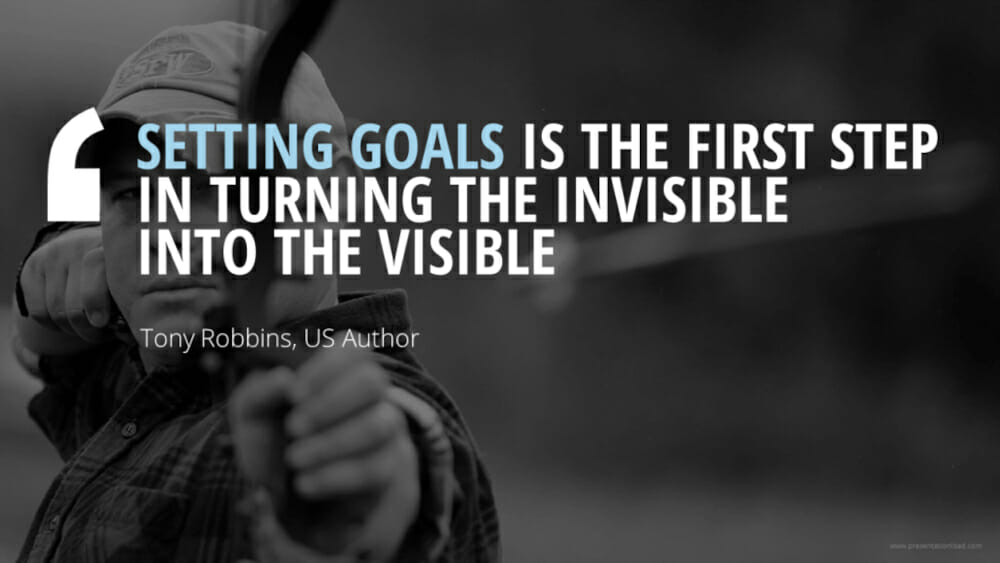
You can leverage the following advantages when using a PowerPoint quote:
- Reinforce your statements: Quotes serve as a second voice in your presentation, validating your theses and ideas. A quote can be impactful either because the author carries a certain authority or because the quote itself is highly meaningful. A seemingly simple statement from a person with an authoritative character sheds new light on the matter.
- Enhance your credibility: Be the expert in your field and demonstrate that you are always up-to-date through thorough research. Quoting other experts and acknowledging their work shows that you are extensively prepared and knowledgeable about your research field.
- Establish a personal connection with the audience: Quotes, with their unique effect, bridge the gap between the audience and the speaker, putting them on the same level.
- Stimulate the minds of the listeners: Inspirational quotes can generate new ideas to solve problems or reinvigorate old projects. Consider incorporating quotes into your brainstorming sessions as well.
- Inspiration: Regardless of what you are presenting, your goal should always be to inspire your audience and spark interest in new ideas, plans, or products. And what better way to achieve that than by emphasizing your statements with a memorable quote? It’s the perfect finishing touch to your presentation. • Add variety to your slides and speech: It’s no secret that long, complex, information-heavy presentations can be tiring. Therefore, incorporate quotes to wake up your listeners before it becomes too dry!
- Summarize: Certain quotes can serve as a summary of your theses and thoughts on a topic. Use a quote to bring your statements back to a central idea and reinforce what you have said
- Structure: Separate chapters, for example, the beginning or end of a topic
- Leave a lasting impression: Quotations help people remember your presentation because they are often precise and presented in a memorable format. (After all, that was the reason you chose to use quotes, right?)
A good quote clarifies and elaborates on an idea or thought and provides inspiration. Quotes motivate the audience to join you because the power of ideas, when elegantly and memorably expressed, can have a significant impact on listeners.
For example, Leo Widrich, co-founder of Buffer, began promoting his products by telling stories, which led to a significant increase in sales. Scientific research also confirms that stories, poems, and quotes have a unique effect on the audience . You can read more about this in the next paragraph.
Why PowerPoint quotes help you and how the brain processes them
To understand why quotes are beneficial, it helps to examine the audience’s reaction more closely. PowerPoint presentations that contain numerous and complex pieces of information activate two parts of the brain: the Broca’s area and the Wernicke’s region. These parts of the brain process language and decode the meaning of words. Therefore, in such an informative presentation, the brain undergoes a pure decoding process.
However, when we hear stories, our brains react differently and in a much more extensive manner. When this happens, not only do the language regions of our brains become active, but also the parts we use when we experience events ourselves . Leo Widrich explains that “when someone tells us about the delicious taste of certain foods, our sensory cortex is activated. When it comes to movement, our motor cortex is activated. So, a story can activate the entire brain.”
The scent of fresh coffee in the morning or the softness of the sheets on our bed are stored in our brains. Therefore, when someone tells a story, our brains want to link the information with similar experiences that are already stored there. In this process, the part of the brain called the insular cortex is activated. It helps us relate what is being told to things we have already experienced in the past, such as feelings of joy, pain, or success.
As our brains automatically make connections with stored experiences, stories, metaphors, images, and quotes can have a particularly significant effect. By using them, the brain becomes actively involved in the presentation. So, if you incorporate a memorable quote along with a relevant image into a presentation, your audience will automatically establish a connection with what is being said that goes beyond mere information absorption.
Read our article on storytelling here .
Which quotes are suitable as PowerPoint quotes
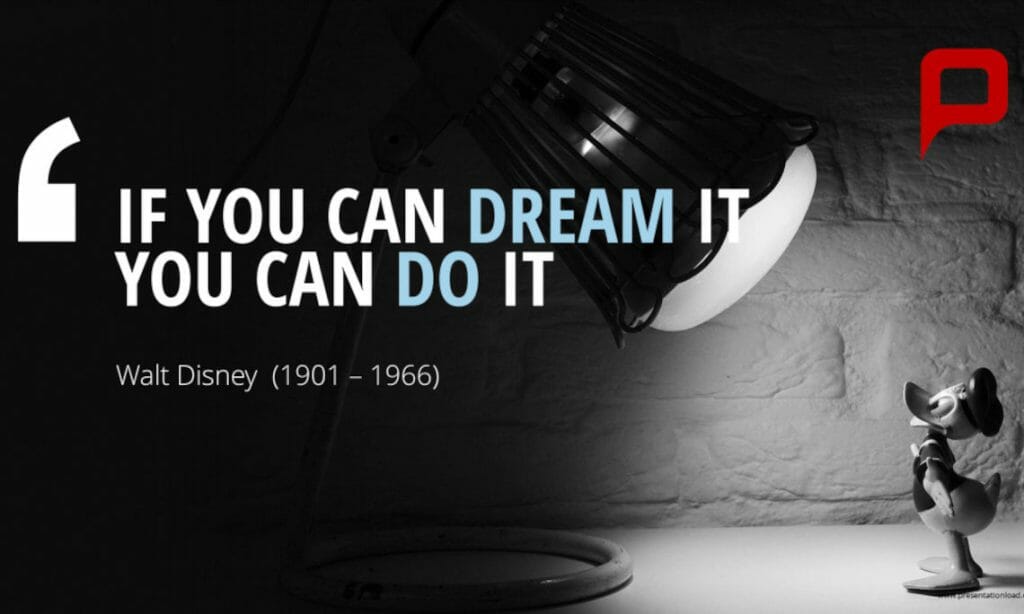
Sometimes you come across a sentence in a book that you really like, or you are inspired by quotes from famous individuals such as athletes, politicians, artists, or philosophers – it doesn’t matter where you find them, what matters is that you find thematically relevant words.
Always remember to entertain your audience to some extent. However, don’t overdo it, as t he right quote chosen at the right time can be invaluable. O ne or at most two quotes in the presentation are sufficient. Too much of a good thing always has a detrimental effect. Use quotes sparingly. Therefore, do not make a mistake and take enough time to research the quote beforehand. A carefully chosen, good quote is better than ten randomly selected PowerPoint quotes.
When is the right time for powerpoint quotes?
When to use PowerPoint quotes d epends on the context and flow of your presentation . Here are a few suggestions:
- Starting your presentation with a quote can have a powerful impact and help capture your audience’s attention right from the beginning (we all know how important the opening of a speech is). However, be cautious about the type of quotes you use and ensure they are relevant and impactful. Beginning your presentation with a PowerPoint quote is a classic approach. Ideally, choose a quote that introduces your topic and resonates with you as a speaker, making an immediate connection with your audience.
For example, you can start with the quote:
“Words may inspire, but actions create change.” Simon Sinek
- Incorporating quotes in the middle part of your presentation can be particularly useful as they can reinforce and support your arguments. Introduce quotes after discussing specific sections or topics to provide closure. Including a quote in the middle adds variety and makes your presentation more digestible.
“Don’t worry about failures, you only have to be right once.” Drew Houston
- Take a break and let your audience read the quote themselves. Use quotes strategically to your advantage, especially if they are visually presented with images or other elements. As you shouldn’t be reading directly from your slides, this gives you a moment to pause and breathe before continuing.
“Taking a break is the most underestimated productivity factor” K. Wolf
Remember to be creative and have fun while presenting your quote. However, ensure that PowerPoint quotes align with your topic . Randomly selected quotes can disrupt the flow of your presentation and confuse your audience. Spark interest and bring humor to your presentation, but always keep your main topic in mind.
Note: When to avoid PowerPoint quotes
Avoid ending your presentation with a quote . Trust your own words to provide a strong conclusion. Ending with someone else’s words can convey a sense of uncertainty and lack of confidence. While it is possible to incorporate a quote near the end of your presentation, especially if it summarizes the content or ties back to the beginning, always make sure that the final words are your own. Remember, you want to leave a lasting impression with the conclusion of your presentation.
What else you need to consider when using PowerPoint quotes
A quote represents the intellectual property of another person, and just like with images, it is essential to give credit to the author. Include the source immediately after the quote. For example:
“The secret of getting ahead is getting started.” Mark Twain
Extra tip: Quote slides from PresentationLoad
Feel free to use our professionally designed quote slides for your presentation. We offer a wide selection of quotes from various (business) areas that can help you make a convincing impact. Take a look around ► To the shop
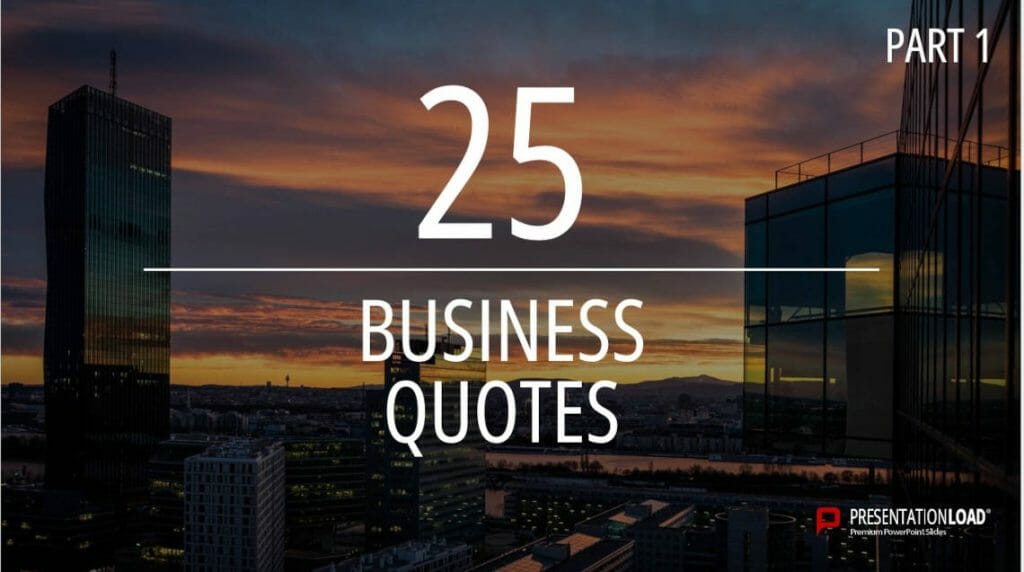
Conclusion: Use PowerPoint quotes in moderation for maximum success
Embrace the many benefits they bring to your presentations, but be mindful not to overload your slides with quotes. Take the time to carefully select and incorporate quotes into your preparation. With a fitting, impactful, and well-placed quote, you’re sure to impress your audience!
If you need help finding a PowerPoint quote or have any other PowerPoint-related questions, feel free to contact us at [email protected] . We’re here to assist you!
You are looking for professionally designed slide templates ? Then check out our shop. We have numerous slides ready for download on a wide range of (business) topics. Visit our shop today! ► Go to the shop
You may also find these articles interesting:
- Closing a Presentation: 20 Ideas for a Successful Conclusion
- Presentation Opening: 16 Ideas for a Strong Start
- Storytelling in Presentations
Share this post
- share
- save

Design Thinking: Problem Solving with a Difference

Why Corporate Mission Statements Are So Important

7 Tips & Learnings from the Apple Keynote
- Presentation Hacks
21 Brilliant Presentation Quotes To Start Your Speech
- By: Leslie Belknap
We all know the saying, you only get one chance to make a first impression . This quote continues to be repeated, even though it is borderline cliché, because first impressions can make or break relationships. This is true even if a first impression is a presentation.
If you are at a loss for how to make a lasting, positive impression during the first few seconds of your next presentation, consider telling a story, sharing a joke, or even leading with a powerful quote that relates to the message of your talk. If you want to begin with a quote, you are in luck, because below are 21 brilliant presentation quotes that are sure to start your speech off on the right foot.
1. The common question that gets asked in business is, ‘why?’ That’s a good question, but an equally valid question is, ‘why not?’. – Jeff Bezos
2. There’s lots of bad reasons to start a company. But there’s only one good, legitimate reason, and I think you know what it is: it’s to change the world. – Phil Libin
3. A business that makes nothing but money is a poor business. – Henry Ford
4. If you are not embarrassed by the first version of your product, you’ve launched too late. – Reid Hoffman
5. If everything seems under control, you’re not going fast enough. – Mario Andretti
6. A man who wants to lead the orchestra must turn his back on the crowd. – Max Lucado
7. Your work is going to fill a large part of your life, and the only way to be truly satisfied is to do what you believe is great work. And the only way to do great work is to love what you do. – Steve Jobs
8. The man who moves a mountain begins by carrying away small stones. – Confucius
9. The difference between successful people and really successful people is that really successful people say no to almost everything. – Warren Buffett
10. Don’t be satisfied with stories, how things have gone with others. Unfold your own myth. – Rumi
11. You don’t have to be a genius or a visionary or even a college graduate to be successful. You just need a framework and a dream. – Michael Dell
12. Build something 100 people love, not something 1 million people kind of like. – Brian Chesky
13. The two most important days in your life are the day you are born and the day you find out why. – Mark Twain
14. The successful warrior is the average man, with laser-like focus. – Bruce Lee
15. Try not to become a man of success, but rather try to become a man of value. – Albert Einstein
16. If something is important enough, even if the odds are against you, you should still do it. – Elon Musk
17. In the midst of movement and chaos, keep stillness inside of you. – Deepak Chopra
18. Many of life’s failures are people who did not realize how close they were to success when they gave up. – Thomas Edison
19. Fall seven times and stand up eight. – Japanese Proverb
20. I was taught the way of progress is neither swift nor easy. – Marie Curie
21. Think twice before you speak, because your words and influence will plant the seed of either success or failure in the mind of another. – Napoleon Hill
Like these quotes? You might also enjoy:
Inspirational Quotes for Presentations from Aristotle
Our Favorite Presentation Quotes
Also check out 13 Inspiring Quotes about Design :
Need help making a great impression during your next presentation? We are here to help! Contact us today to learn more about how we can help you succeed.
Question: What is your favorite quote?
Leslie Belknap
Join our newsletter today.
© 2006-2024 Ethos3 – An Award Winning Presentation Design and Training Company ALL RIGHTS RESERVED
- Terms & Conditions
- Privacy Policy
- Diversity and Inclusion
We use essential cookies to make Venngage work. By clicking “Accept All Cookies”, you agree to the storing of cookies on your device to enhance site navigation, analyze site usage, and assist in our marketing efforts.
Manage Cookies
Cookies and similar technologies collect certain information about how you’re using our website. Some of them are essential, and without them you wouldn’t be able to use Venngage. But others are optional, and you get to choose whether we use them or not.
Strictly Necessary Cookies
These cookies are always on, as they’re essential for making Venngage work, and making it safe. Without these cookies, services you’ve asked for can’t be provided.
Show cookie providers
- Google Login
Functionality Cookies
These cookies help us provide enhanced functionality and personalisation, and remember your settings. They may be set by us or by third party providers.
Performance Cookies
These cookies help us analyze how many people are using Venngage, where they come from and how they're using it. If you opt out of these cookies, we can’t get feedback to make Venngage better for you and all our users.
- Google Analytics
Targeting Cookies
These cookies are set by our advertising partners to track your activity and show you relevant Venngage ads on other sites as you browse the internet.
- Google Tag Manager
- Infographics
- Daily Infographics
- Template Lists
- Graphic Design
- Graphs and Charts
- Data Visualization
- Human Resources
- Beginner Guides
Blog Marketing
How To Start a Presentation: 15 Ways to Set the Stage
By Krystle Wong , Jul 25, 2023

The opening moments of your presentation hold immense power – it’s your opportunity to make a lasting impression and captivate your audience.
A strong presentation start acts as a beacon, cutting through the noise and instantly capturing the attention of your listeners. With so much content vying for their focus, a captivating opening ensures that your message stands out and resonates with your audience.
Whether you’re a startup business owner pitching a brilliant idea, a seasoned presenter delivering a persuasive talk or an expert sharing your experience, the start of your presentation can make all the difference. But don’t fret — I’ve got you covered with 15 electrifying ways to kickstart your presentation.
The presentation introduction examples in this article cover everything from self-introduction to how to start a group presentation, building anticipation that leaves the audience eager to delve into the depths of your topic.
Click to jump ahead:
How to start a presentation introduction
15 ways to start a presentation and captivate your audience, common mistakes to avoid in the opening of a presentation, faqs on how to start a presentation, captivate the audience from the get-go.

Presentations can be scary, I know. But even if stage fright hits, you can always fall back on a simple strategy.
Just take a deep breath, introduce yourself and briefly explain the topic of your presentation.
To grab attention at the start, try this opening line: Hello everyone. I am so glad you could join me today. I’m very excited about today’s topic. I’m [Your Name] and I’ll be talking about [Presentation Topic]. Raise your hand if you’ve ever felt overwhelmed by [Challenge related to your topic]. Many of us might have faced challenges with [Challenge related to your topic]. Today, we’ll explore some strategies that’ll help us [Solution that you’re presenting].
Regardless of your mode of presentation , crafting an engaging introduction sets the stage for a memorable presentation.
Let’s dive into some key tips for how to start a presentation speech to help you nail the art of starting with a bang:
Understand your audience
The key to an engaging introduction is to know your audience inside out and give your audience what they want. Tailor your opening to resonate with their specific interests, needs and expectations. Consider what will captivate them and how you can make your presentation relevant to their lives or work.
Use a compelling hook
Grab the audience’s attention from the get-go with a compelling hook. Whether it’s a thought-provoking question, a surprising fact or a gripping story, a powerful opening will immediately pique their curiosity and keep them invested in what you have to say.

State your purpose
Be crystal clear about your subject matter and the purpose of your presentation. In just a few sentences, communicate the main objectives and the value your audience will gain from listening to you. Let them know upfront what to expect and they’ll be more likely to stay engaged throughout.
Introduce yourself and your team
Give a self introduction about who you are such as your job title to establish credibility and rapport with the audience.
Some creative ways to introduce yourself in a presentation would be by sharing a brief and engaging personal story that connects to your topic or the theme of your presentation. This approach instantly makes you relatable and captures the audience’s attention.
Now, let’s talk about — how to introduce team members in a presentation. Before introducing each team member, briefly explain their role or contribution to the project or presentation. This gives the audience an understanding of their relevance and expertise.
Group presentations are also a breeze with the help of Venngage. Our in-editor collaboration tools allow you to edit presentations side by side in real-time. That way, you can seamlessly hare your design with the team for input and make sure everyone is on track.
Maintain enthusiasm
Enthusiasm is contagious! Keep the energy levels up throughout your introduction, conveying a positive and upbeat tone. A vibrant and welcoming atmosphere sets the stage for an exciting presentation and keeps the audience eager to hear more.
Before you think about how to present a topic, think about how to design impactful slides that can leave a lasting impression on the audience. Here are 120+ presentation ideas , design tips, and examples to help you create an awesome slide deck for your next presentation.
Captivating your audience from the get-go is the key to a successful presentation. Whether you’re a seasoned speaker or a novice taking the stage for the first time, the opening of your presentation sets the tone for the entire talk.
So, let’s get ready to dive into the 15 most creative ways to start a presentation. I promise you these presentation introduction ideas will captivate your audience, leaving them hanging on your every word.
Grab-attention immediately
Ask a thought-provoking question.
Get the audience’s wheels turning by throwing them a thought-provoking question right out of the gate. Make them ponder, wonder and engage their critical thinking muscles from the very start.
Share a surprising statistic or fact
Brace yourself for some wide eyes and dropped jaws! Open your presentation with a jaw-dropping statistic or a mind-blowing fact that’s directly related to your topic. Nothing captures attention like a good ol’ dose of shock and awe.

State a bold statement or challenge
Ready to shake things up? Kick off with a bold and daring statement that sets the stage for your presentation’s epic journey. Boldness has a way of making ears perk up and eyes widen in anticipation!
Engage with a poll or interactive activity
Turn the audience from passive listeners to active participants by kicking off with a fun poll or interactive activity. Get them on their feet, or rather — their fingertips, right from the start!
Venngage’s user-friendly drag-and-drop editor allows you to easily transform your slides into an interactive presentation . Create clickable buttons or navigation elements within your presentation to guide your audience to different sections or external resources.
Enhance engagement by incorporating videos or audio clips directly into your presentation. Venngage supports video and audio embedding, which can add depth to your content.

Begin with an opening phrase that captures attention
Use opening phrases that can help you create a strong connection with your audience and make them eager to hear more about what you have to say. Remember to be confident, enthusiastic and authentic in your delivery to maximize the impact of your presentation.
Here are some effective presentation starting words and phrases that can help you grab your audience’s attention and set the stage for a captivating presentation:
- “Imagine…”
- “Picture this…”
- “Did you know that…”
- “Have you ever wondered…”
- “In this presentation, we’ll explore…”
- “Let’s dive right in and discover…”
- “I’m excited to share with you…”
- “I have a confession to make…”
- “I want to start by telling you a story…”
- “Before we begin, let’s consider…”
- “Have you ever faced the challenge of…”
- “We all know that…”
- “This is a topic close to my heart because…”
- “Over the next [minutes/hours], we’ll cover…”
- “I invite you to journey with me through…”
Build connection and credibility
Begin with a personal connection .
Share a real-life experience or a special connection to the topic at hand. This simple act of opening up creates an instant bond with the audience, turning them into your biggest cheerleaders.
Having the team share their personal experiences is also a good group presentation introduction approach. Team members can share their own stories that are related to the topic to create an emotional connection with your audience.

Tell a relevant story
Start your presentation with a riveting story that hooks your audience and relates to your main message. Stories have a magical way of captivating hearts and minds. Organize your slides in a clear and sequential manner and use visuals that complement your narrative and evoke emotions to engage the audience.
With Venngage, you have access to a vast library of high-quality and captivating stock photography, offering thousands of options to enrich your presentations. The best part? It’s entirely free! Elevate your visual storytelling with stunning images that complement your content, captivate your audience and add a professional touch to your presentation.

Use a powerful quote
Sometimes, all you need is some wise words to work wonders. Begin with a powerful quote from a legendary figure that perfectly fits your presentation’s theme — a dose of inspiration sets the stage for an epic journey.
Build anticipation
Provide a brief outline.
Here’s a good introduction for presentation example if you’re giving a speech at a conference. For longer presentations or conferences with multiple speakers especially, providing an outline helps the audience stay focused on the key takeaways. That way, you can better manage your time and ensure that you cover all the key points without rushing or running out of time.
Pose a problem and offer a solution
A great idea on how to start a business presentation is to start by presenting a problem and offering a well-thought-out solution. By addressing their pain points and showcasing your solution, you’ll capture their interest and set the stage for a compelling and successful presentation.
Back up your solution with data, research, or case studies that demonstrate its effectiveness. This can also be a good reporting introduction example that adds credibility to your proposal.
Preparing a pitch deck can be a daunting task but fret not. This guide on the 30+ best pitch deck tips and examples has everything you need to bring on new business partners and win new client contracts. Alternatively, you can also get started by customizing one of our professional pitch deck templates for free.

Incite curiosity in the audience
Utilize visuals or props.
Capture your audience’s gaze by whipping out captivating visuals or props that add an exciting touch to your subject. A well-placed prop or a stunning visual can make your presentation pop like a fireworks show!
That said, you maybe wondering — how can I make my presentation more attractive. A well-designed presentation background instantly captures the audience’s attention and creates a positive first impression. Here are 15 presentation background examples to keep the audience awake to help you get inspired.

Use humor or wit
Sprinkle some humor and wit to spice things up. Cracking a clever joke or throwing in a witty remark can break the ice and create a positively charged atmosphere. If you’re cracking your head on how to start a group presentation, humor is a great way to start a presentation speech.
Get your team members involved in the fun to create a collaborative and enjoyable experience for everyone. Laughter is the perfect way to break the ice and set a positive tone for your presentation!

Invoke emotion
Get those heartstrings tugging! Start with a heartfelt story or example that stirs up emotions and connects with your audience on a personal level. Emotion is the secret sauce to a memorable presentation.
Aside from getting creative with your introduction, a well-crafted and creative presentation can boost your confidence as a presenter. Browse our catalog of creative presentation templates and get started right away!
Use a dramatic pause
A great group presentation example is to start with a powerful moment of silence, like a magician about to reveal their greatest trick. After introducing your team, allow a brief moment of silence. Hold the pause for a few seconds, making it feel deliberate and purposeful. This builds anticipation and curiosity among the audience.
Pique their interest
Share a fun fact or anecdote.
Time for a little fun and games! Kick-off with a lighthearted or fascinating fact that’ll make the audience go, “Wow, really? Tell me more!” A sprinkle of amusement sets the stage for an entertaining ride.
While an introduction for a presentation sets the tone for your speech, a good slide complements your spoken words, helping the audience better understand and remember your message. Check out these 12 best presentation software for 2023 that can aid your next presentation.

The opening moments of a presentation can make or break your entire talk. It’s your chance to grab your audience’s attention, set the tone, and lay the foundation for a successful presentation. However, there are some common pitfalls that speakers often fall into when starting their presentations.
Starting with Apologies
It might be tempting to start with a preemptive apology, especially if you’re feeling nervous or unsure about your presentation. However, beginning with unnecessary apologies or self-deprecating remarks sets a negative tone right from the start. Instead of exuding confidence and credibility, you’re unintentionally undermining yourself and your message.
Reading from Slides
One of the most common blunders in the opening of a PowerPoint presentation is reading directly from your slides or script. While it’s crucial to have a well-structured outline, reciting word-for-word can lead to disengagement and boredom among your audience. Maintain eye contact and connect with your listeners as you speak. Your slides should complement your words, not replace them.

Overwhelming with Information
In the excitement to impress, some presenters bombard their audience with too much information right at the beginning.
Instead of overloading the audience with a sea of data, statistics or technical details that can quickly lead to confusion and disinterest, visualize your data with the help of Venngage. Choose an infographic template that best suits the type of data you want to visualize. Venngage offers a variety of pre-designed templates for charts, graphs, infographics and more.

Ignoring the Audience
It’s easy to get caught up in the content and forget about the people in front of you. Don’t overlook the importance of acknowledging the audience and building a connection with them. Greet them warmly, make eye contact and maintain body language to show genuine interest in their presence. Engage the audience early on by asking a show of hands question or encourage audience participation.
Lack of Clarity
Your audience should know exactly what to expect from your presentation. Starting with a vague or unclear opening leaves them guessing about the purpose and direction of your talk. Clearly communicate the topic and objectives of your presentation right from the beginning. This sets the stage for a focused and coherent message that resonates with your audience.
Simplicity makes it easier for the audience to understand and retain the information presented. Check out our gallery of simple presentation templates to keep your opening concise and relevant.

Skipping the Hook
The opening of your presentation is the perfect opportunity to hook your audience’s attention and keep them engaged. However, some presenters overlook this crucial aspect and dive straight into the content without any intrigue. Craft an attention-grabbing hook that sparks curiosity, poses a thought-provoking question or shares an interesting fact. A compelling opening is like the key that unlocks your audience’s receptivity to the rest of your presentation.
Now that you’ve got the gist of how to introduce a presentation, further brush up your speech with these tips on how to make a persuasive presentation and how to improve your presentation skills to create an engaging presentation .

How can I overcome nervousness at the beginning of a presentation?
To overcome nervousness at the beginning of a presentation, take deep breaths, practice beforehand, and focus on connecting with your audience rather than worrying about yourself.
How long should the opening of a presentation be?
The opening of a presentation should typically be brief, lasting around 1 to 3 minutes, to grab the audience’s attention and set the tone for the rest of the talk.
Should I memorize my presentation’s opening lines?
While it’s helpful to know your opening lines, it’s better to understand the key points and flow naturally to maintain authenticity and flexibility during the presentation.
Should I use slides during the opening of my presentation?
Using slides sparingly during the opening can enhance the message, but avoid overwhelming the audience with too much information early on.
How do I transition smoothly from the opening to the main content of my presentation?
Transition smoothly from the opening to the main content by providing a clear and concise outline of what’s to come, signaling the shift and maintaining a logical flow between topics.
Just as a captivating opening draws your audience in, creating a well-crafted presentation closing has the power to leave a lasting impression. Wrap up in style with these 10 ways to end a presentation .
Presenting virtually? Check out these tips on how to ace your next online presentation .
Captivating your audience from the very beginning is crucial for a successful presentation. The first few moments of your talk can set the tone and determine whether your audience remains engaged throughout or loses interest.
Start with a compelling opening that grabs their attention. You can use a thought-provoking question, a surprising statistic or a powerful quote to pique their curiosity. Alternatively, storytelling can be a potent tool to draw them into your narrative. It’s essential to establish a personal connection early on, whether by sharing a relatable experience or expressing empathy towards their needs and interests.
Lastly, be mindful of your body language and vocal delivery. A confident and engaging speaker can captivate an audience, so make eye contact, use appropriate gestures and vary your tone to convey passion and sincerity.
In conclusion, captivating your audience from the very beginning requires thoughtful preparation, engaging content and a confident delivery. With Venngage’s customizable templates, you can adapt your presentation to suit the preferences and interests of your specific audience, ensuring maximum engagement. Go on and get started today!
PHILADELPHIA, MAY 9-10 PUBLIC SPEAKING CLASS IS ALMOST FULL! RESERVE YOUR SPOT NOW

- Public Speaking Classes
- Corporate Presentation Training
- Online Public Speaking Course
- Northeast Region
- Midwest Region
- Southeast Region
- Central Region
- Western Region
- Presentation Skills
- 101 Public Speaking Tips
- Fear of Public Speaking
7 Dynamic Ways to Start a Presentation [With Examples]

Of course, we’ve all been there as a speaker. First, we design a powerful presentation. Then, we nervously walk out onto a stage or into the front of the room. The audience stares with skepticism written all over their faces. This stoic crowd has no patience for speakers who waste their time. And their demeanor is showing that fact right now. In a timid voice, we start with a simple, “Good morning.” We get no response from the audience — no warm welcome at all. As a result, our nervousness increases dramatically.
The good news is that your speech doesn’t have to start this way. Your first words will create first impressions.
So, in this session, I’m going to give you the best way to start a successful presentation so you can win over the audience members. Below are a few of my favorite ways to start a speech that will help you capture the attention of your audience and get even the most stoic crowd to want more from you.
Here is the list of effective presentation openers.
7 Dynamic Ways to Start Your Next Presentation.
- Give Your Presentation Summary and Conclusion First.
- Start the Presentation with a Compelling Story.
- Use a Startling Statistic to Start a Presentation.
- A Funny or Motivational Quote or One-Liner.
- Start with an Opinion Asking Question.
- Make a Powerful or Shocking Statement to Start a Speech.
- Arouse Curiosity with a Hook.
- A Bonus Way to Start a Presentation Is to Add Showmanship.
How to Start a Presentation and Help Your Audience Remember Your Content.
(1) give a summary and conclusion at the beginning of a presentation..
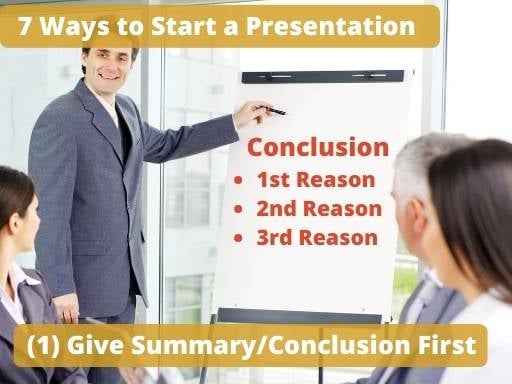
As a speaker, you have a lot going against you. The biggest challenge is that most of the people who are in your audience would really rather be somewhere else. So starting with the conclusion gives them a reason to tune in and pay attention to the content.
TV shows and movies do this a lot. The first scene in Titanic is 90-year-old Rose wheeling onto the salvage ship. Immediately, she asked the Captain to see her painting. “Wasn’t I a dish?”
We all know the story of Titanic, but by starting 70 years into the future, we already know that somehow, Rose was going to survive the tragedy. We pay attention because we want to see how she did it.
You probably also recall Netflix series that show a quick introduction and then a flashback to an earlier time.
You can create the same effect in your presentation introduction by making your title a conclusion that you want the audience to draw. Then, lay out each main point that will help them come to that conclusion.
For instance, “My topic today is Five Ways to Get Your Executives to Increase Your Department Budget, and the items we will cover are…” Of course, this technique works best when your title is a result that your audience really wants.
This is an easy way to start a presentation. You can use a single PowerPoint presentation slide as a visual aid to capture the audience’s attention right away! (FYI, you can also use this technique at the end of a presentation.)
More details about this are in Start with a Great Title .
(2) Start the Presentation with a Compelling Story
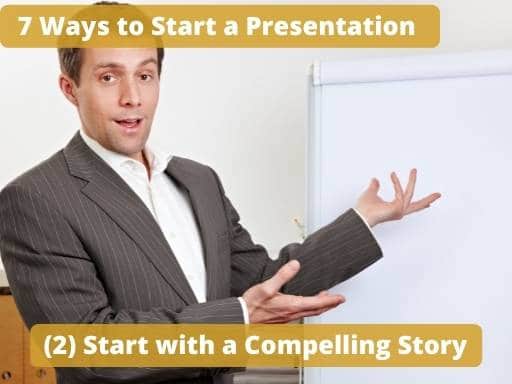
I taught a private presentation class for Mitsubishi once. And I could tell walking into the room that this was going to be a tough crowd. The culture of the predominately Japanese company is fairly quiet and conservative. Most often, when I introduce myself to class members, people are warm and friendly. Since I’m a guest in their office, most try to make me feel at home.
By the way, the Mitsubishi organizer did this here as well. However, as the participants came into the room, each walked in without saying a word. Each sat down, opened their laptops, and quietly began typing on their keyboards.
I did my best to try to get them to open up. But very few of them were laughing at my jokes or smiling at me as I asked them questions. (Tough crowd.)
So, when I started the class, I knew I needed something that would help the group relate to me. I decided to go into a fairly detailed version of an experience where I totally bombed a speech. I added a lot of self-deprecating humor to the story. Afterward, the mood in the room lightened quite a bit. It was an easy way to get the audience to feel more at ease and become more relatable to them.
Stories are easy additions to any speech. For instance, if you are giving a project report, you can start with a memorable event that occurred on the project since the last meeting. Or, if you are giving a financial report where profit is up, just give a great example of something that caused profit to increase.
(3) Or You Could Use a Startling Statistic to Start a Presentation.
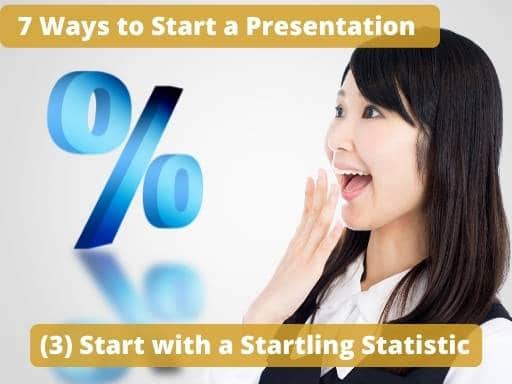
By doing a little research, you can often find a good (and or startling) statistic that can capture attention quickly. You can also create a good introduction by phrasing the statistic as a provocative statement.
For instance, let’s say you are giving a financial presentation where revenue for your company was up 2.5% last quarter. You might look up the statistics for your industry as a whole in the same quarter. Then, you can start your speech with that data. “The electronics industry as a whole was up 3.4% last quarter. However, our company underperformed the industry with only a 2.5% increase in revenue.”
The easiest way to find statistics about your topic is to just do a Google search [Your Topic} followed by the word “statistic”.
Here Are a Few Examples of Using Google to Get Shocking Statistics.
I’ll give some examples. I just did a Google search for “Popular Ted Talks” and came up with an article about the Top 25 Most Shared Ted Talk videos . I just pasted the names of the talks into Google with the word “statistic” added and this is what I came up with.
- Does School Kill Creativity? According to the Adobe® State of Create global benchmark study , 8 in 10 people feel that unlocking creativity is critical to economic growth and more than half of those surveyed feel that creativity is being stifled by their education systems.
- Your Body Language May Shape Who You Are – We receive 82% of information from what we see, 11% from what we hear, and only 7% by all the other senses combined. ( The Body Language Info-graphic .)
- How Great Leaders Inspire Action – 84% of organizations anticipate a shortfall in leaders within the next five years. ( 13 Shocking Leadership Development Statistics .)
So, it is really easy to create compelling statistics to get your audience to think differently about your topic just as you begin to speak.
Bonus Tip: Combine More than One of these Intros for Even More Impact.
You can combine the last two tips for even more impact. Place a statistic along with a story of how you found the statistic at the beginning of your presentation. This is a great way to start your presentation. “I remember watching Jerry Seinfeld do a stand-up bit. He mentioned that the fear of public speaking was the number one fear in America. Then he looked down the list and saw that the fear of death was number five. So, you are five times more likely to rather be in the casket than up giving the eulogy at a funeral.”
The key to each of these first tips is that they increase the retention of information for your audience.
For instance, using the Summary technique, you give your audience an introduction with your presentation topic and key points. Then as you go through each point, they hear each one again. Finally, you summarize the points one more time at the end of your presentation. The audience is now more likely to remember your important points. because of this subtle repetition.
A good story will also increase retention. Stories have a way of creating visual images in the mind of the audience that is more memorable than just facts alone. A startling statistic gets the audience to think, “Is that really true?” so they pay attention more.
Quick Presentation Starters to Capture Attention
(4) a funny or motivational quote or one-liner..
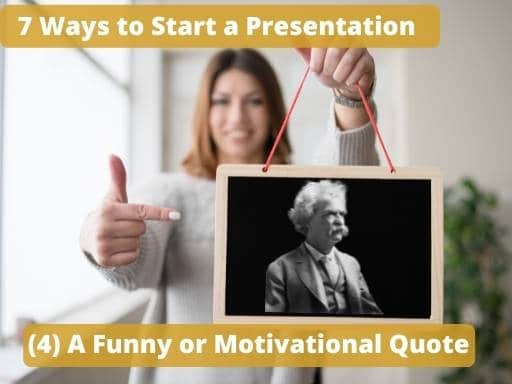
“There are two types of speakers: Those who get nervous and those who are liars.” — Mark Twain
A powerful quote is an effective way to make a positive first impression. It also adds a little humor. You can find quotes like this for your presentations as well. Just like with statistics, you can Google your topic with the word “quotes” to get ideas.
- Does School Kill Creativity? – “Creativity is the greatest expression of liberty.” — Bryant H. McGill
- Your Body Language May Shape Who You Are. – “Language is a more recent technology. Your body language, your eyes, your energy will come through to your audience before you even start speaking.” — Peter Guber
- How Great Leaders Inspire Action. – “A leader is the one, who knows the way, goes the way and show the way” — John Maxwell
Bonus Tip: Reference a quote, and then add your own take to the quote.
Walt Disney once said, “If you can dream it, you can do it.” But have you ever thought to realize that every single invention ever created by man was once just an idea born from someone’s need?
(5) Start with an Opinion Asking Question.
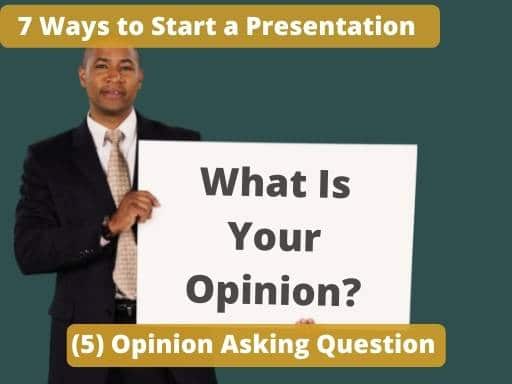
“In a perfect world, if your team was able to present their ideas to your customers more effectively, what would they be doing that they are not doing now?”
This technique is more challenging for a presenter. You have to be able to take whatever your audience gives you and design a killer presentation on the fly. However, if you have done good research before the meeting, you shouldn’t be surprised by the answers you get.
Keep in mind that only the best presenters use this technique. So, when you add open-ended questions to your speech, you will increase your stature as a speaker as well.
By the way, the question should be open-ended, meaning that the audience is giving you their opinions. Rhetorical questions and show of hands questions can backfire. Your audience may think you are trying to manipulate them. So, the important thing to remember is to ask a question that asks for the opinion of the audience members. That way, as they answer, everyone can be correct..
(6) Make a Powerful or Shocking Statement to Start a Speech.
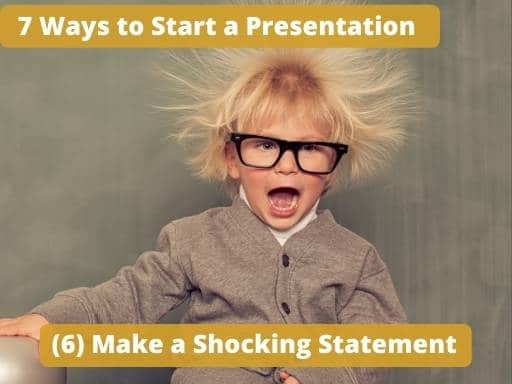
I will then follow this statement with a list of different tips that people try that don’t work really well. (Things like picturing your audience naked.)
The funny thing is that many of the people in the room will question the truthfulness of the statement the first time I say it. It is a bold claim. They don’t confront me, though. However, when I look around the room, I can see the distrust on their faces.
However, as I begin to list the crazy tips one by one, they begin to realize the truthfulness of the statement. Internally, the checklist sounds like this…
- To reduce nervousness, you should pretend your audience is naked. (Man, he’s right. I tried that. It doesn’t work.)
- You should memorize your speech word-for-word. Actually, if you lose your place when reciting the speech, you just get more nervous. (That one is true too.)
- You should practice in front of a mirror or record yourself speaking. Actually, you are your own worst critic. You will nitpick every little thing that you do wrong. (Yup, I’ve done that one too. Wow, maybe he’s right. Those things don’t work at all.)
Another shocking statement I use is to foreshadow a future behavior in the speech. When I lead team activities, I often have them play a game to divide into teams. So, I might start the presentation with, “In less than 15 minutes, some of you chivalrous men who opened a door for a young lady when she came into the room will actually be chicken-winging that woman to take something from her.” Of course, when something like that actually happens, everyone erupts in laughter.
(7) Arouse Curiosity with a Hook.
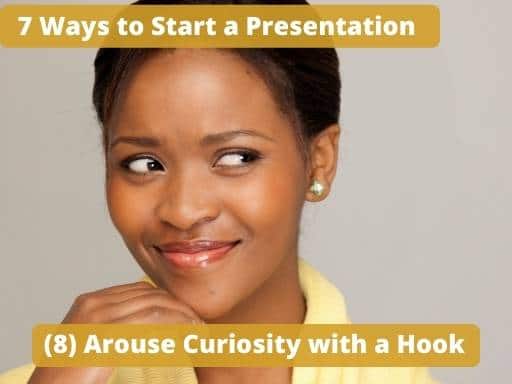
Talk radio, television news, and reality TV shows do this brilliantly.
I remember years ago watching season one of Survivor. The season winner was an eccentric guy named Richard Hatch, who was a good fisherman, so he fed the group. However, he also did things to keep the other contestants a little off their game. At the start of one of the episodes, Richard was walking along the beach buck-naked with his bottom blurred out by the producers.
I remember doing a double-take when the image came on the screen. (There are some things that you just can’t unsee.) I didn’t particularly ever want to see Hatch’s bare bum ever again. However, I had an eager want to find how the heck this happened.
Talk radio guys do this by saying, “At the bottom of the hour, we’re going to…” The technique is like a cliffhanger. Everyone wants to know how the story will end. Will Ross marry Emily, or will Rachel stop the wedding? Will Jon Snow die of his stab wounds? Ken Jennings has won 74 times in a row on Jeopardy. When will he get beaten? What is going to happen now that DEA agent Hank realizes his brother-in-law broke bad? And finally, who shot J.R.?
How to Easily Add a Hook into the Start of Your Presentation.
This is a fun technique to use when you start a presentation. And there are many different ways to do this, depending on the purpose of your presentation.
For instance, you could tell your compelling story, as I suggested earlier. However, don’t tell the ending. Stop right as you get to the climax. Then tell the ending in your conclusion. (More details about this in How to End a Speech .)
Or, the hook can be a cliffhanger or foreshadowing of something later in the presentation. “As we did this research, we uncovered a single habit that, once we change it, will generate an extra quarter of a million dollars for our company. And I will share that secret with you in my final point.”
I actually do this on my podcast as well. I might start the episode by saying something like, “In the last ten minutes of this episode, I’m going to share with you my best, overall, foolproof presentation opener.”
(Which, by the way, is right now…)
A Bonus Way to Start a Presentation Is to Add Showmanship. (Bonus… Not a Foolproof Way.)

For instance, one time, just after July 4th, my kids had some leftover fireworks. I also had some decorative mailing tubes left over from a failed marketing campaign.
The next morning, I was to speak at a business breakfast. I got to the hotel meeting room before anyone else and filled a trash can with water. Then, I left the can under the presentation table at the front of the room. I stuck one of the sparklers into the top of the mailing tube and waited until my time to speak. The emcee called my name, and I waited at the back of the room. She called my name one more time, and I waited just a bit longer. When she called my name the third time, I lit the sparkler and went rushing to the front of the room.
Of course, the visual aid looked like I was holding a stick of cartoon dynamite. I pulled the trash can from under the table and threw the prop into the can where it sizzled and smoked. The whole audience was looking around like, “What the heck?” I paused and then said, “Do you want to put some sizzle into your presentations?”
Okay, it was cheesy. It was over the top. But it got the whole audience laughing. Everyone in the room remembered who I was and what I did for a living.
A few less over-the-top ways of adding showmanship into your presentation might be…
- Use Boards Instead of Slides . Everyone expects a slideshow, but if you have a compelling board or poster that is in the front of the room when you start, you can create some curiosity about your topic.
- You Could Also Get the Audience to Participate in a Demonstration . I had a saleperson from the Riddell helmet company tell us about a football helmet face-mask that could detach with a simple pencil-like tool. He had a couple of men try to pull the face-mask off the helmet and when they failed, he used the tool to remove the mask with one hand. It was a vivid demonstration.
- Or Just Add a Funny Video . When I teach leadership classes, I often play segments from old Saturday Night Live skits that have the characters doing the exact opposite of what I’m teaching. For instance, I might start a session about avoiding criticism in the workplace with an episode of “Debbie Downer”.
Whatever method that you choose to start your presentation make sure to spend time on developing your content. You don’t want to spend a ton of time creating the perfect opener and then lose the audience with a lackluster presentation afterward.
If You Are Designing a Presentation and Need Help, Reach Out to Us!

Podcasts , presentation skills
View More Posts By Category: Free Public Speaking Tips | leadership tips | Online Courses | Past Fearless Presentations ® Classes | Podcasts | presentation skills | Uncategorized
404 Not found

How to Start a Presentation: 5 Templates and 90 Example Phrases
By Status.net Editorial Team on February 27, 2024 — 11 minutes to read
Starting a presentation effectively means capturing your audience’s attention from the very beginning. It’s important because it sets the tone for the entire presentation and establishes your credibility as a speaker.
Effective Openers: 5 Templates
Your presentation’s beginning sets the stage for everything that follows. So, it’s important to capture your audience’s attention right from the start. Here are some tried-and-true techniques to do just that.
1. Storytelling Approach
When you start with a story, you tap into the natural human love for narratives. It can be a personal experience, a historical event, or a fictional tale that ties back to your main point.
Example Introduction Template 1:
“Let me tell you a story about…”
Example : “Let me tell you a story about how a small idea in a garage blossomed into the global brand we know today.”
2. Quotation Strategy
Using a relevant quote can lend authority and thematic flavor to your presentation. Choose a quote that is provocative, enlightening, or humorous to resonate with your audience.
Example Introduction Template 2:
“As [Famous Person] once said…”
Example : “As Steve Jobs once said, ‘Innovation distinguishes between a leader and a follower.'”
3. Questioning Technique
Engage your audience directly by opening with a thoughtful question. This encourages them to think and become active participants.
Example Introduction Template 3:
“Have you ever wondered…”
Example : “Have you ever wondered what it would take to reduce your carbon footprint to zero?”
4. Statistical Hook
Kick off with a startling statistic that presents a fresh perspective or underscores the importance of your topic.
Example Introduction Template 4:
“Did you know that…”
Example : “Did you know that 90% of the world’s data was generated in the last two years alone?”
5. Anecdotal Method
Share a brief, relatable incident that highlights the human aspect of your topic. It paves the way for empathy and connection.
Example Introduction Template 5:
“I want to share a quick anecdote…”
Example : “I want to share a quick anecdote about a time I experienced the customer service that went above and beyond what anyone would expect.”
How to Start a Powerpoint Presentation: 45 Example Phrases
Starting a PowerPoint presentation effectively can captivate your audience and set the tone for your message. The opening phrases you choose are important in establishing rapport and commanding attention. Whether you’re presenting to colleagues, at a conference, or in an academic setting, these phrases will help you begin with confidence and poise:
- 1. “Good morning/afternoon/evening, everyone. Thank you for joining me today.”
- 2. “Welcome, and thank you for being here. Let’s dive into our topic.”
- 3. “I’m excited to have the opportunity to present to you all about…”
- 4. “Thank you all for coming. Today, we’re going to explore…”
- 5. “Let’s begin by looking at the most important question: Why are we here today?”
- 6. “I appreciate your time today, and I promise it will be well spent as we discuss…”
- 7. “Before we get started, I want to express my gratitude for your presence here today.”
- 8. “It’s a pleasure to see so many familiar faces as we gather to talk about…”
- 9. “I’m thrilled to kick off today’s presentation on a topic that I am passionate about—…”
- 10. “Welcome to our session. I’m confident you’ll find the next few minutes informative as we cover…”
- 11. “Let’s embark on a journey through our discussion on…”
- 12. “I’m delighted to have the chance to share my insights on…”
- 13. “Thank you for the opportunity to present to such an esteemed audience on…”
- 14. “Let’s set the stage for an engaging discussion about…”
- 15. “As we begin, I’d like you to consider this:…”
- 16. “Today marks an important discussion on a subject that affects us all:…”
- 17. “Good day, and welcome to what promises to be an enlightening presentation on…”
- 18. “Hello and welcome! We’re here to delve into something truly exciting today…”
- 19. “I’m honored to present to you this comprehensive look into…”
- 20. “Without further ado, let’s get started on a journey through…”
- 21. “Thank you for carving time out of your day to join me for this presentation on…”
- 22. “It’s wonderful to see such an engaged audience ready to tackle the topic of…”
- 23. “I invite you to join me as we unpack the complexities of…”
- 24. “Today’s presentation will take us through some groundbreaking ideas about…”
- 25. “Welcome aboard! Prepare to set sail into the vast sea of knowledge on…”
- 26. “I’d like to extend a warm welcome to everyone as we focus our attention on…”
- 27. “Let’s ignite our curiosity as we begin to explore…”
- 28. “Thank you for your interest and attention as we dive into the heart of…”
- 29. “As we look ahead to the next hour, we’ll uncover the secrets of…”
- 30. “I’m eager to share with you some fascinating insights on…”
- 31. “Welcome to what I believe will be a transformative discussion on…”
- 32. “This morning/afternoon, we’ll be venturing into the world of…”
- 33. “Thank you for joining me on this exploration of…”
- 34. “I’m delighted by the turnout today as we embark on this exploration of…”
- 35. “Together, let’s navigate the intricacies of…”
- 36. “I’m looking forward to engaging with you all on the subject of…”
- 37. “Let’s kick things off with a critical look at…”
- 38. “Thank you for your presence today as we shine a light on…”
- 39. “Welcome to a comprehensive overview of…”
- 40. “It’s a privilege to discuss with you the impact of…”
- 41. “I’m glad you could join us for what promises to be a thought-provoking presentation on…”
- 42. “Today, we’re going to break down the concept of…”
- 43. “As we get started, let’s consider the significance of our topic:…”
- 44. “I’m thrilled to lead you through today’s discussion, which centers around…”
- 45. “Let’s launch into our session with an eye-opening look at…”
Starting a Presentation: 45 Examples
Connecting with the audience.
When starting a presentation, making a genuine connection with your audience sets the stage for a successful exchange of ideas. Examples:
- “I promise, by the end of this presentation, you’ll be as enthusiastic about this as I am because…”
- “The moment I learned about this, I knew it would be a game-changer and I’m thrilled to present it to you…”
- “There’s something special about this topic that I find incredibly invigorating, and I hope you will too…”
- “I get a rush every time I work on this, and I hope to transmit that energy to you today…”
- “I’m thrilled to discuss this breakthrough that could revolutionize…”
- “This project has been a labor of love, and I’m eager to walk you through…”
- “When I first encountered this challenge, I was captivated by the possibilities it presented…”
- “I can’t wait to dive into the details of this innovative approach with you today…”
- “It’s genuinely exhilarating to be at the edge of what’s possible in…”
- “My fascination with [topic] drove me to explore it further, and I’m excited to share…”
- “Nothing excites me more than talking about the future of…”
- “Seeing your faces, I know we’re going to have a lively discussion about…”
- “The potential here is incredible, and I’m looking forward to discussing it with you…”
- “Let’s embark on this journey together and explore why this is such a pivotal moment for…”
- “Your engagement in this discussion is going to make this even more exciting because…”
Building Credibility
You present with credibility when you establish your expertise and experience on the subject matter. Here’s what you can say to accomplish that:
- “With a decade of experience in this field, I’ve come to understand the intricacies of…”
- “Having led multiple successful projects, I’m excited to share my insights on…”
- “Over the years, working closely with industry experts, I’ve gleaned…”
- “I hold a degree in [your field], which has equipped me with a foundation for…”
- “I’m a certified professional in [your certification], which means I bring a certain level of expertise…”
- “Having published research on this topic, my perspective is grounded in…”
- “I’ve been a keynote speaker at several conferences, discussing…”
- “Throughout my career, I’ve contributed to groundbreaking work in…”
- “My experience as a [your previous role] has given me a unique outlook on…”
- “Endorsed by [an authority in your field], I’m here to share what we’ve achieved…”
- “The program I developed was recognized by [award], highlighting its impact in…”
- “I’ve trained professionals nationwide on this subject and witnessed…”
- “Collaborating with renowned teams, we’ve tackled challenges like…”
- “I’ve been at the forefront of this industry, navigating through…”
- “As a panelist, I’ve debated this topic with some of the brightest minds in…”
Projecting Confidence
- “I stand before you today with a deep understanding of…”
- “You can rely on the information I’m about to share, backed by thorough research and analysis…”
- “Rest assured, the strategies we’ll discuss have been tested and proven effective in…”
- “I’m certain you’ll find the data I’ll present both compelling and relevant because…”
- “I’m fully confident in the recommendations I’m providing today due to…”
- “The results speak for themselves, and I’m here to outline them clearly for you…”
- “I invite you to consider the evidence I’ll present; it’s both robust and persuasive…”
- “You’re in good hands today; I’ve navigated these waters many times and have the insights to prove it…”
- “I assure you, the journey we’ll take during this presentation will be enlightening because…”
- “Your success is important to me, which is why I’ve prepared diligently for our time together…”
- “Let’s look at the facts; they’ll show you why this approach is solid and dependable…”
- “Today, I present to you a clear path forward, grounded in solid experience and knowledge…”
- “I’m confident that what we’ll uncover today will not only inform but also inspire you because…”
- “You’ll leave here equipped with practical, proven solutions that you can trust because…”
- “The solution I’m proposing has been embraced industry-wide, and for good reason…”
Organizational Preview
Starting your presentation with a clear organizational preview can effectively guide your audience through the content. This section helps you prepare to communicate the roadmap of your presentation.
Outlining the Main Points
You should begin by briefly listing the main points you’ll cover. This lets your audience know what to expect and helps them follow along. For example, if you’re presenting on healthy eating, you might say, “Today, I’ll cover the benefits of healthy eating, essential nutrients in your diet, and simple strategies for making healthier choices.”
Setting the Tone
Your introduction sets the tone for the entire presentation. A way to do this is through a relevant story or anecdote that engages the audience. Suppose you’re talking about innovation; you might start with, “When I was a child, I was fascinated by how simple Legos could build complex structures, which is much like the innovation process.”
Explaining the Structure
Explain the structure of your presentation so that your audience can anticipate how you’ll transition from one section to the next. For instance, if your presentation includes an interactive portion, you might say, “I’ll begin with a 15-minute overview, followed by a hands-on demonstration, and we’ll wrap up with a Q&A session, where you can ask any questions.”
Practice and Preparation
Before you step onto the stage, it’s important that your preparation includes not just content research, but also rigorous practice and strategy for dealing with nerves. This approach ensures you present with confidence and clarity.
Rehearsing the Opening
Practicing your introduction aloud gives you the opportunity to refine your opening remarks. You might start by greeting the audience and sharing an interesting quote or a surprising statistic related to your topic. For example, if your presentation is about the importance of renewable energy, you could begin with a recent statistic about the growth in solar energy adoption. Record yourself and listen to the playback, focusing on your tone, pace, and clarity.
Memorizing Key Points
While you don’t need to memorize your entire presentation word for word, you should know the key points by heart. This includes main arguments, data, and any conclusions you’ll be drawing. You can use techniques such as mnemonics or the method of loci, which means associating each key point with a specific location in your mind, to help remember these details. Having them at your fingertips will make you feel more prepared and confident.
Managing Presentation Jitters
Feeling nervous before a presentation is natural, but you can manage these jitters with a few techniques. Practice deep breathing exercises or mindful meditation to calm your mind before going on stage. You can also perform a mock presentation to a group of friends or colleagues to simulate the experience and receive feedback. This will not only help you get used to speaking in front of others but also in adjusting your material based on their reactions.
Engagement Strategies
Starting a presentation on the right foot often depends on how engaged your audience is. Using certain strategies, you can grab their attention early and maintain their interest throughout your talk:
1. Encouraging Audience Participation
Opening your presentation with a question to your audience is a great way to encourage participation. This invites them to think actively about the subject matter. For instance, you might ask, “By a show of hands, how many of you have experienced…?” Additionally, integrating interactive elements like quick polls or requesting volunteers for a demonstration can make the experience more dynamic and memorable.
Using direct questions throughout your presentation ensures the audience stays alert, as they might be called upon to share their views. For example, after covering a key point, you might engage your audience with, “Does anyone have an experience to share related to this?”
2. Utilizing Pacing and Pauses
Mastering the pace of your speech helps keep your presentation lively. Quickening the pace when discussing exciting developments or slowing down when explaining complex ideas can help maintain interest. For example, when introducing a new concept, slow your pace to allow the audience to absorb the information.
Pauses are equally powerful. A well-timed pause after a key point gives the audience a moment to ponder the significance of what you’ve just said. It might feel like this: “The results of this study were groundbreaking. (pause) They completely shifted our understanding of…”. Pauses also give you a moment to collect your thoughts, adding to your overall composure and control of the room.
How should one introduce their group during a presentation?
You might say something like, “Let me introduce my amazing team: Alex, our researcher, Jamie, our designer, and Sam, the developer. Together, we’ve spent the last few months creating something truly special for you.”
- Job Knowledge Performance Review Phrases (Examples)
- 40th Birthday Sayings and Wishes: Heartfelt Sample Phrases
- 70 Example Phrases: Key Marketing Skills for Your Resume
- A Perfect Letter of Recommendation [8 Templates]
- 100 Performance Review Phrases for Job Knowledge, Judgment, Listening Skills
- Cover Letter vs. Letter of Interest vs. Letter of Intent
How to start a presentation with a quote [VIDEO]
Starting a presentation has got to be one of the most stressful parts of giving a presentation. You’re worried about what you’re going to say, especially if English isn’t your first language, and whether you’ll give a good impression. That’s why I think this week’s presentation tip about starting a presentation with a quote is really valuable.
A quote to start your presentation can quickly get the entire audience onto the same page. That is, your audience can be aligned to your presentation in a very short time when using a quote.
So when do you introduce yourself in your presentation if you’re using a quote? Well, you can do it before or after you show the quote, but it depends on the situation. If you’ve been introduced, then there’s no need to give a self-introduction. If you do not get introduced, you may want to wait until after you’ve talked about the quote to introduce yourself. Why?
I think the quote will get the audience focused on the topic and on you, so if you then tell them who you are, the audience will already be happily paying attention.
Here’s the video:
10 Comments
Loved this video. You guys have helped me so much this year with my presentations.Thank you.
Thank you guys we donne a very good work that is helping me a lot!
Maria Helena
Thanks Karen! Great to hear from you and so happy we’ve been able to help. Anything in particular that’s been especially helpful?
Thanks Maria Helena! It’s great to hear from you again! Hope things are going well 🙂
I would like to get the ebook “10 Presentation Expression you can’t live Without”. I submission would not go through. My email address is writtenb above.
Thanks for letting us know. We had no idea there was a problem with the signup box. I’m going to send you the ebook directly.
All the best.
Hi Really cool webpage. Thank you
Thank you for taking the time to visit and comment! 🙂
Great advice…excellent material. Thank you very much for sharing this.
Hi Joel! Thank YOU! Hope your music composition work is going well.
All the best,
Trackbacks/Pingbacks
- How to Start a Presentation Using an Attention Grabbing Question or Statement - [...] How to start a presentation with a quote [VIDEO] [...]
Submit a Comment
You must be logged in to post a comment.
This site uses Akismet to reduce spam. Learn how your comment data is processed .
Recent Posts
- What Are You Going to Talk About if You Have a Short Presentation? [VIDEO]
- A Tip to Increase Your Confidence [VIDEO]
- What’s Your 2020 Goal? [VIDEO]
- How to Prepare a Presentation Without a Script [VIDEO]
- How to End a Group Presentation [VIDEO]
- How to Improve School Group Presentations [VIDEO]
- How to Improve Your Presentation Skills With Your Hands [VIDEO]

Using Quotes to Influence Your Audience During a Presentation
April 26, 2023 / Blog

Quotes convey wisdom, inspiration, and credibility in just a few words. They can set the tone, evoke emotions , and reinforce your message.
Need a Presentation Designed? Click Here To View Our Amazing Portfolio
In this blog, we will explore using quotes to influence your audience during a presentation.
The Power of Quotes
Quotes can captivate and influence your audience in various ways. They can elevate your presentation to a whole new level when used strategically.
Here are some key ways in which quotes hold immense power:
Setting the Tone
Quotes can help you set the right tone for your presentation. For instance, an inspirational quote can create a positive and uplifting atmosphere, while a humorous quote can add levity and create a relaxed environment.
The tone you set at the beginning of your presentation can greatly impact your audience’s receptiveness to your message, and quotes can be a powerful tool in achieving that.
Eliciting Emotions
Quotes can evoke emotions in your audience, making your presentation more memorable and impactful.
Whether through a touching story, a heartfelt testimonial, or a powerful statement, quotes can tug at the heartstrings of your audience, helping them connect with your message on a deeper level. Emotionally charged quotes can make your presentation more relatable, engaging, and compelling.
Adding Credibility
Quotes from influential figures or reputable sources can add credibility and authority to your presentation.
By referencing experts, industry leaders, or renowned individuals, you can strengthen your arguments and lend more weight to your message. Quotes can act as evidence or proof to support your claims, making your presentation more convincing.
Concise Communication
Quotes are often concise and impactful, conveying a powerful message in just a few words.
Attention spans are becoming shorter and quotes are effective tools to communicate key ideas succinctly. They can help you convey complex concepts or ideas in a memorable and easily digestible manner, keeping your audience engaged and attentive.
Memorable Impact
A well-chosen quote can leave a lasting impact on your audience.
When you use a quote that resonates with your audience, it becomes memorable, and your audience is more likely to remember and recall your message long after the presentation. Quotes can help you make a lasting impression and ensure a memorable and impactful presentation.

Best Practices for Using Quotes in Your Presentation
While quotes can be a powerful tool in your presentation, it’s important to use them effectively and appropriately.
Here are some best practices to keep in mind when incorporating quotes into your presentation:
Know Your Audience
Consider your audience’s demographics, preferences, and context when selecting quotes. Choose relevant quotes that resonate with your specific audience. Avoid ones that may be offensive, controversial, or irrelevant to your audience, as they may detract from your message.
Use Reliable Sources
Ensure that the quotes you use are from reputable and reliable sources. Moreover, attribute the quote to the original author or speaker, and provide proper citations if needed. Avoid using quotes from anonymous or unknown sources, as they may lack credibility.
Keep it Concise
Choose quotes that are concise and impactful. Avoid lengthy ones that may dilute your message or lose your audience’s attention. Instead, opt for ones that can be easily understood and remembered, and that align with the overall flow of your presentation.
Contextualize the Quote
Provide context when using a quote to help your audience understand its relevance to your presentation. Explain how the quote supports your message or relates to the topic. Avoid using quotes out of context, as they may confuse or mislead your audience.

Practice Delivery
Practice delivering your quotes with proper tone, emphasis, and timing. Use appropriate gestures, facial expressions, and vocal inflections to enhance the impact of the quotes. Avoid rushing through them or reading them monotonously, as they may lose their intended effect.
Use Variety
Incorporate a variety of quotes in your presentation, including inspirational, motivational, humorous, and thought-provoking quotes. Mix up the type of quotes you use to keep your audience engaged and add depth and diversity to your presentation.
Be Authentic
Choose quotes that resonate with your style and voice. Avoid using ones that feel forced or insincere, as they may come across as inauthentic. Rather, use ones that genuinely reflect your beliefs and values to connect with your audience on a deeper level.
Practice Proper Attribution
Always give credit to the original author or speaker of the quote. Avoid taking credit for someone else’s words or ideas. Use proper attribution methods, including the author’s name, title, and source, to acknowledge and honor their work.
Using quotes strategically and effectively in your presentations can be a game-changer. By following best practices and incorporating powerful quotes into your presentation, you can connect with your audience more and leave a lasting impact that influences and inspires.
Popular Posts
Save your deck: methods to recover an unsaved powerpoint file.

Twitter: Lessons from Social Media

Oscar Speech Sounds A Lot Like…..

Olympians Can Teach Presenters a Thing or Two

Overcoming a Public Speaking Disaster: A Lesson from Michael Bay

The Similarities Between Presentations and Advertisments : Super Bowl Edition
7 Creative Ways to Start Any Presentation (With Examples!)
I like building and growing simple yet powerful products for the world and the worldwide web.
Published Date : December 4, 2020
Reading Time :
Creating an effective presentation is challenging and needs a lot of effort to become engaging with your audience. Many questions are indeed rounding up your head.
Like how to start a PowerPoint presentation and a class set-up presentation, it helps people, such as entrepreneurs, organize and disseminate their ideas flawlessly.
It clarifies intentions, concepts, and other feasible topics specifically. They may differ from execution, events, and for whom the presentation.
With that, the bottom line and the question is how to do it. How do you start a Board Meeting <p data-sourcepos="3:1-3:200">A formal gathering of a company's board of directors, where they discuss strategic matters, review financial performance, make key decisions, and oversee the organization's governance.</p><br /><h2 data-sourcepos="5:1-5:21"><strong>Key Participants:</strong></h2> <ul data-sourcepos="7:1-11:0"> <li data-sourcepos="7:1-7:102"><strong>Board members:</strong> Elected or appointed individuals responsible for guiding the company's direction.</li> <li data-sourcepos="8:1-8:94"><strong>Executives:</strong> Company leaders like the CEO, CFO, and COO, who provide updates and reports.</li> <li data-sourcepos="9:1-9:88"><strong>Secretary:</strong> Oversees logistics, records minutes, and ensures compliance with rules.</li> <li data-sourcepos="10:1-11:0"><strong>Legal counsel:</strong> Offers guidance on legal matters and ensures adherence to regulations.</li> </ul> <h2 data-sourcepos="12:1-12:12"><strong>Purpose:</strong></h2> <ul data-sourcepos="14:1-19:0"> <li data-sourcepos="14:1-14:78"><strong>Strategic planning:</strong> Setting the company's long-term direction and goals.</li> <li data-sourcepos="15:1-15:81"><strong>Financial oversight:</strong> Reviewing financial reports, budgets, and investments.</li> <li data-sourcepos="16:1-16:86"><strong>Risk management:</strong> Identifying and mitigating potential risks to the organization.</li> <li data-sourcepos="17:1-17:76"><strong>Executive evaluation:</strong> Assessing the performance of company leadership.</li> <li data-sourcepos="18:1-19:0"><strong>Decision-making:</strong> Approving key initiatives, investments, and policies.</li> </ul> <h2 data-sourcepos="20:1-20:11"><strong>Format:</strong></h2> <ul data-sourcepos="22:1-25:0"> <li data-sourcepos="22:1-22:43">Varies based on company size and culture.</li> <li data-sourcepos="23:1-23:91">Typically includes presentations, discussions, voting on proposals, and Q&A sessions.</li> <li data-sourcepos="24:1-25:0">It may be formal with strict agendas or more informal with brainstorming sessions.</li> </ul> <h2 data-sourcepos="26:1-26:26"><strong>Public Speaking Roles:</strong></h2> <ul data-sourcepos="28:1-30:0"> <li data-sourcepos="28:1-28:125"><strong>CEO and other executives:</strong> Act as a <strong>public speaker</strong>, presenting reports, answering questions, and defending proposals.</li> <li data-sourcepos="29:1-30:0"><strong>Board members:</strong> May participate in discussions, ask questions, and occasionally propose or speak in favor of motions.</li> </ul> <h2 data-sourcepos="31:1-31:39"><strong>Addressing Public Speaking Anxiety:</strong></h2> <ul data-sourcepos="33:1-36:0"> <li data-sourcepos="33:1-33:87">Many executives and board members face <strong>public speaking anxiety</strong> in these meetings.</li> <li data-sourcepos="34:1-34:93">Preparation, practicing presentations, and visualization techniques can help manage nerves.</li> <li data-sourcepos="35:1-36:0">Some companies hire <strong>public speaking coaches</strong> to offer personalized guidance and improve communication skills.</li> </ul> <h2 data-sourcepos="37:1-37:248"><strong>Remember:</strong></h2> <p data-sourcepos="37:1-37:248">Effective board meetings require clear communication, active participation, and informed decision-making. By understanding the format, roles, and potential challenges, participants can contribute to a productive and impactful session.</p> " href="https://orai.com/glossary/board-meeting/" data-gt-translate-attributes="[{"attribute":"data-cmtooltip", "format":"html"}]" tabindex="0" role="link">board meeting presentation, or how do you start a presentation introduction in class?
Many students are also struggling with how to start a case study presentation, and young entrepreneurs or start-ups are struggling with how to start a business presentation.
To ease the tension and upgrade your Confidence <p data-sourcepos="3:1-3:305">In the context of <strong>public speaking</strong>, <strong>confidence</strong> refers to the belief in one's ability to communicate effectively and deliver one's message with clarity and impact. It encompasses various elements, including self-belief, composure, and the ability to manage one's <strong>fear of public speaking</strong>.</p><br /><h2 data-sourcepos="5:1-5:16"><strong>Key Aspects:</strong></h2> <ul data-sourcepos="7:1-12:0"> <li data-sourcepos="7:1-7:108"><strong>Self-belief:</strong> A strong conviction in your knowledge, skills, and ability to connect with your audience.</li> <li data-sourcepos="8:1-8:95"><strong>Composure:</strong> Maintaining calmness and poise under pressure, even in challenging situations.</li> <li data-sourcepos="9:1-9:100"><strong>Assertiveness:</strong> Expressing your ideas clearly and concisely, avoiding hesitation or self-doubt.</li> <li data-sourcepos="10:1-10:104"><strong>Positive self-talk:</strong> Countering negative thoughts with affirmations and focusing on your strengths.</li> <li data-sourcepos="11:1-12:0"><strong>Strong body language:</strong> Using gestures, posture, and eye contact that project confidence and professionalism.</li> </ul> <h2 data-sourcepos="13:1-13:27"><strong>Benefits of Confidence:</strong></h2> <ul data-sourcepos="15:1-19:0"> <li data-sourcepos="15:1-15:99"><strong>Reduced anxiety:</strong> Feeling confident helps manage <strong>fear of public speaking</strong> and stage fright.</li> <li data-sourcepos="16:1-16:133"><strong>Engaging delivery:</strong> Confident speakers project their voices, hold eye contact, and connect with their audience more effectively.</li> <li data-sourcepos="17:1-17:137"><strong>Increased persuasiveness:</strong> A confident presentation inspires belief and motivates your audience to listen and remember your message.</li> <li data-sourcepos="18:1-19:0"><strong>Greater impact:</strong> Confidently delivered speeches leave a lasting impression and achieve desired outcomes.</li> </ul> <h2 data-sourcepos="20:1-20:15"><strong>Challenges:</strong></h2> <ul data-sourcepos="22:1-26:0"> <li data-sourcepos="22:1-22:112">Overcoming <strong>fear of public speaking</strong>: Many people experience some level of anxiety when speaking publicly.</li> <li data-sourcepos="23:1-23:101"><strong>Imposter syndrome:</strong> Doubting your abilities and qualifications, even when objectively qualified.</li> <li data-sourcepos="24:1-24:92"><strong>Negative self-talk:</strong> Internalized criticism and limiting beliefs can hamper confidence.</li> <li data-sourcepos="25:1-26:0"><strong>Past negative experiences:</strong> Unsuccessful presentations or negative feedback can erode confidence.</li> </ul> <h2 data-sourcepos="27:1-27:24"><strong>Building Confidence:</strong></h2> <ul data-sourcepos="29:1-36:0"> <li data-sourcepos="29:1-29:102"><strong>Practice and preparation:</strong> Thoroughly rehearse your speech to feel comfortable with the material.</li> <li data-sourcepos="30:1-30:101"><strong>Visualization:</strong> Imagine yourself delivering a successful presentation with confidence and poise.</li> <li data-sourcepos="31:1-31:100"><strong>Positive self-talk:</strong> Actively replace negative thoughts with affirmations about your abilities.</li> <li data-sourcepos="32:1-32:106"><strong>Seek feedback:</strong> Ask trusted individuals for constructive criticism and use it to improve your skills.</li> <li data-sourcepos="33:1-33:157">Consider a <strong>speaking coach</strong>: Working with a coach can provide personalized guidance and support to address specific challenges and confidence barriers.</li> <li data-sourcepos="34:1-34:114"><strong>Start small:</strong> Gradually increase the size and complexity of your speaking engagements as you gain experience.</li> <li data-sourcepos="35:1-36:0"><strong>Focus on progress:</strong> Celebrate small successes and acknowledge your improvement over time.</li> </ul> <h2 data-sourcepos="37:1-37:282"><strong>Remember:</strong></h2> <p data-sourcepos="37:1-37:282"><strong>Confidence</strong> in public speaking is a journey, not a destination. By actively practicing, embracing feedback, and focusing on your strengths, you can overcome <strong>fear of public speaking</strong> and develop the <strong>confidence</strong> to deliver impactful and memorable presentations.</p> " href="https://orai.com/glossary/confidence/" data-gt-translate-attributes="[{"attribute":"data-cmtooltip", "format":"html"}]" tabindex="0" role="link">confidence , furthermore those people above, I will share some tips, steps, and how to start a presentation example.
Why Presentation is Important in Persuading
Presentations break communication barriers. Across this, it brings mutual understanding to the audience.
In winning your stances and goals, having and knowing how to start a presentation is a must. It helps you more to give an idea of what your topic could be through moving pictures and graphics in reality.
The role of presentation in persuading can be categorized into many factors. First, it helps your audience to feel more comfortable with your spiels.
Second, you have the chance to tell your options, choices, summary, and the result of your case study, etc., within your presentation. Especially can be stoop on how to start a business presentation.
Lastly, knowing how to deliver and how to start a presentation in persuading your listener includes support for your audience’s decision. Through it, the concept of persuasion becomes more reliable with tangible materials.
It is evident in thesis defenses and academic proposals. To start a case study presentation, you must present facts, stats, related studies, and other materials.
And to achieve that in a well-presented way, you need to think and come up with a composition associated with your topic to make it reliable and credible.
Different Ways to Start a Presentation
Difficulties on how to start a case study presentation and the things you need to behold within your PowerPoint presentation would be easy after sharing with you this advice.
As for direction and advice, take a look at this list to start a presentation generally.
1. Start With a Strong Claim
The beginning is always the hard part of a presentation. But like a bottle of water, after it gets opened, the water inside can flow smoothly to your gulp.
Meaning after spitting out your first words, everything should follow accordingly to your presentation. That’s why it is the most crucial when you are learning how to start a presentation.
Try to use the iconic lines of a famous philosopher —striking advice of a hotshot entrepreneur for your business proposal presentation.
Through this, you can have a good impression on your listener. Shook them and contradict their ideas; indeed, you can have an intense or beneficial presentation.
2. Know Your Prospect
Besides technicalities and visuals, knowing first the current state, perspective, wants, and needs of your prospect or audience is vital.
Before the presentation, you can send them a pre-assessment or survey consisting of what they want to see and learn and things to keep them interested, or you need to get their attention and interest.
3. Assist the Flow With Visuals
Showing your audience a good spiel in presenting your developing ideas and concepts through pictures that can’t be put quickly in language can break communication drawbacks.
Apart from describing your idea in a presentation, you are also giving quick ways to dice abstract ideas.
4. Moving Pictures
Pictures and videos are great instruments for nurturing your ideas and your audience counterparts.
The power of moving pictures is evident as the film business and the movie industry is booming and depicting fictional stories into reality.
5. Break People’s Expectation
To break the set expectations of your audience for you, always stick to your premise. Whether on business, academics, proposals, and other topical presentations.
Call an action to smash misconceptions about your particular presentation.
6. Spill Surprising Stories
Bring stories and the characters in life. Create conflict and suspense to highlight your goal’s presentation.
It also helps you to organize your presentation’s information to be catchy and relatable. Touching stories can affect audience decision-making.
7. Know When to Pause
Don’t present vague ideas, premises, and concepts. Stop bombarding your audience.
After a round of applause or before speaking, take a three-second pause. Observe your audience’s facial expressions.
With that, you can focus on your tone. It is also an indication that you want to give your audience a short rest.
Orai helps you perfect your Speech <p data-sourcepos="3:1-3:271">A form of communication involving spoken language, it is used to express ideas, share information, tell stories, persuade, or entertain. Public speaking is a powerful tool used in diverse contexts, ranging from casual conversations to formal presentations.</p><br /><h2 data-sourcepos="5:1-5:27"><strong>Components of a Speech:</strong></h2> <ul data-sourcepos="7:1-10:0"> <li data-sourcepos="7:1-7:73"><strong>Content:</strong> The information, message, or story conveyed through words.</li> <li data-sourcepos="8:1-8:106"><strong>Delivery:</strong> The vocal and physical presentation, including clarity, volume, gestures, and eye contact.</li> <li data-sourcepos="9:1-10:0"><strong>Structure:</strong> The organization of the content, typically following an introduction, body, and conclusion.</li> </ul> <h2 data-sourcepos="11:1-11:21"><strong>Speech in Action:</strong></h2> <ul data-sourcepos="13:1-17:0"> <li data-sourcepos="13:1-13:88"><strong>Informing:</strong> Sharing knowledge and facts, educating an audience on a specific topic.</li> <li data-sourcepos="14:1-14:119"><strong>Persuading:</strong> Advocating for a particular viewpoint, using arguments and evidence to influence thoughts or actions.</li> <li data-sourcepos="15:1-15:93"><strong>Motivating:</strong> Inspiring and energizing an audience, fostering action and positive change.</li> <li data-sourcepos="16:1-17:0"><strong>Entertaining:</strong> Engaging and delighting an audience through humor, storytelling, or creative language.</li> </ul> <h2 data-sourcepos="18:1-18:32"><strong>Public Speaking and Anxiety:</strong></h2> <p data-sourcepos="20:1-20:227">Many people experience <strong>public speaking anxiety</strong>, a fear of speaking in front of an audience. While it's common, effective preparation, practice, and breathing techniques can significantly reduce anxiety and improve delivery.</p><br /><h2 data-sourcepos="22:1-22:32"><strong>Different Types of Speeches:</strong></h2> <ul data-sourcepos="24:1-28:0"> <li data-sourcepos="24:1-24:81"><strong>Informative speech:</strong> Focuses on conveying information clearly and concisely.</li> <li data-sourcepos="25:1-25:102"><strong>Persuasive speech:</strong> Aims to convince the audience to adopt a particular viewpoint or take action.</li> <li data-sourcepos="26:1-26:99"><strong>Motivational speech:</strong> Inspires and energizes the audience, building enthusiasm and commitment.</li> <li data-sourcepos="27:1-28:0"><strong>Entertaining speech:</strong> Aim to amuse and delight the audience, often using humor, storytelling, or anecdotes.</li> </ul> <h2 data-sourcepos="29:1-29:33"><strong>Crafting a Compelling Speech:</strong></h2> <ul data-sourcepos="31:1-35:0"> <li data-sourcepos="31:1-31:106"><strong>Know your audience:</strong> Tailor your content and delivery to their interests, needs, and prior knowledge.</li> <li data-sourcepos="32:1-32:107"><strong>Have a clear message:</strong> Identify the main point you want to convey and structure your speech around it.</li> <li data-sourcepos="33:1-33:111"><strong>Engage your audience:</strong> Use varied vocal techniques, storytelling, and visual aids to keep them interested.</li> <li data-sourcepos="34:1-35:0"><strong>Practice, practice, practice:</strong> Rehearse your speech out loud to refine your delivery and build confidence.</li> </ul> <h2 data-sourcepos="36:1-36:13"><strong>Remember:</strong></h2> <p data-sourcepos="38:1-38:281">Speech is a powerful tool for communication, connection, and influence. By understanding its elements, addressing potential anxieties, and tailoring your delivery to different contexts, you can harness the power of speech to achieve your intended goals and captivate your audience.</p> " href="https://orai.com/glossary/speech/" data-gt-translate-attributes="[{"attribute":"data-cmtooltip", "format":"html"}]" tabindex="0" role="link">speech with feedback on your tone, tempo, Confidence <p data-sourcepos="3:1-3:305">In the context of <strong>public speaking</strong>, <strong>confidence</strong> refers to the belief in one's ability to communicate effectively and deliver one's message with clarity and impact. It encompasses various elements, including self-belief, composure, and the ability to manage one's <strong>fear of public speaking</strong>.</p><br /><h2 data-sourcepos="5:1-5:16"><strong>Key Aspects:</strong></h2> <ul data-sourcepos="7:1-12:0"> <li data-sourcepos="7:1-7:108"><strong>Self-belief:</strong> A strong conviction in your knowledge, skills, and ability to connect with your audience.</li> <li data-sourcepos="8:1-8:95"><strong>Composure:</strong> Maintaining calmness and poise under pressure, even in challenging situations.</li> <li data-sourcepos="9:1-9:100"><strong>Assertiveness:</strong> Expressing your ideas clearly and concisely, avoiding hesitation or self-doubt.</li> <li data-sourcepos="10:1-10:104"><strong>Positive self-talk:</strong> Countering negative thoughts with affirmations and focusing on your strengths.</li> <li data-sourcepos="11:1-12:0"><strong>Strong body language:</strong> Using gestures, posture, and eye contact that project confidence and professionalism.</li> </ul> <h2 data-sourcepos="13:1-13:27"><strong>Benefits of Confidence:</strong></h2> <ul data-sourcepos="15:1-19:0"> <li data-sourcepos="15:1-15:99"><strong>Reduced anxiety:</strong> Feeling confident helps manage <strong>fear of public speaking</strong> and stage fright.</li> <li data-sourcepos="16:1-16:133"><strong>Engaging delivery:</strong> Confident speakers project their voices, hold eye contact, and connect with their audience more effectively.</li> <li data-sourcepos="17:1-17:137"><strong>Increased persuasiveness:</strong> A confident presentation inspires belief and motivates your audience to listen and remember your message.</li> <li data-sourcepos="18:1-19:0"><strong>Greater impact:</strong> Confidently delivered speeches leave a lasting impression and achieve desired outcomes.</li> </ul> <h2 data-sourcepos="20:1-20:15"><strong>Challenges:</strong></h2> <ul data-sourcepos="22:1-26:0"> <li data-sourcepos="22:1-22:112">Overcoming <strong>fear of public speaking</strong>: Many people experience some level of anxiety when speaking publicly.</li> <li data-sourcepos="23:1-23:101"><strong>Imposter syndrome:</strong> Doubting your abilities and qualifications, even when objectively qualified.</li> <li data-sourcepos="24:1-24:92"><strong>Negative self-talk:</strong> Internalized criticism and limiting beliefs can hamper confidence.</li> <li data-sourcepos="25:1-26:0"><strong>Past negative experiences:</strong> Unsuccessful presentations or negative feedback can erode confidence.</li> </ul> <h2 data-sourcepos="27:1-27:24"><strong>Building Confidence:</strong></h2> <ul data-sourcepos="29:1-36:0"> <li data-sourcepos="29:1-29:102"><strong>Practice and preparation:</strong> Thoroughly rehearse your speech to feel comfortable with the material.</li> <li data-sourcepos="30:1-30:101"><strong>Visualization:</strong> Imagine yourself delivering a successful presentation with confidence and poise.</li> <li data-sourcepos="31:1-31:100"><strong>Positive self-talk:</strong> Actively replace negative thoughts with affirmations about your abilities.</li> <li data-sourcepos="32:1-32:106"><strong>Seek feedback:</strong> Ask trusted individuals for constructive criticism and use it to improve your skills.</li> <li data-sourcepos="33:1-33:157">Consider a <strong>speaking coach</strong>: Working with a coach can provide personalized guidance and support to address specific challenges and confidence barriers.</li> <li data-sourcepos="34:1-34:114"><strong>Start small:</strong> Gradually increase the size and complexity of your speaking engagements as you gain experience.</li> <li data-sourcepos="35:1-36:0"><strong>Focus on progress:</strong> Celebrate small successes and acknowledge your improvement over time.</li> </ul> <h2 data-sourcepos="37:1-37:282"><strong>Remember:</strong></h2> <p data-sourcepos="37:1-37:282"><strong>Confidence</strong> in public speaking is a journey, not a destination. By actively practicing, embracing feedback, and focusing on your strengths, you can overcome <strong>fear of public speaking</strong> and develop the <strong>confidence</strong> to deliver impactful and memorable presentations.</p> " href="https://orai.com/glossary/confidence/" data-gt-translate-attributes="[{"attribute":"data-cmtooltip", "format":"html"}]" tabindex="0" role="link">confidence , and Conciseness <p data-sourcepos="3:1-3:326">In the realm of <strong>public speaking</strong>, <strong>conciseness</strong> refers to the ability to express your message clearly and effectively using the fewest possible words. It's about conveying your ideas precisely, avoiding unnecessary details and rambling while maintaining your message's essence and impact.</p><br /><h2 data-sourcepos="5:1-5:33"><strong>Benefits for Public Speakers:</strong></h2> <ul data-sourcepos="7:1-11:0"> <li data-sourcepos="7:1-7:137"><strong>Engaged audience:</strong> A concise speech keeps your audience focused and prevents them from losing interest due to excessive information.</li> <li data-sourcepos="8:1-8:117"><strong>Increased clarity:</strong> By removing unnecessary clutter, your core message becomes clearer and easier to understand.</li> <li data-sourcepos="9:1-9:137"><strong>Enhanced credibility:</strong> Concise communication projects professionalism and efficiency, making you appear more confident and prepared.</li> <li data-sourcepos="10:1-11:0"><strong>Reduced anxiety:</strong> Knowing you have a clear and concise message can help manage <strong>public speaking anxiety</strong> by minimizing the pressure to fill time.</li> </ul> <h2 data-sourcepos="12:1-12:35"><strong>Challenges for Public Speakers:</strong></h2> <ul data-sourcepos="14:1-17:0"> <li data-sourcepos="14:1-14:126"><strong>Striking a balance:</strong> Knowing where to draw the line between conciseness and omitting important information can be tricky.</li> <li data-sourcepos="15:1-15:115"><strong>Avoiding oversimplification:</strong> Complex topics may require elaboration to ensure clarity and understanding.</li> <li data-sourcepos="16:1-17:0"><strong>Overcoming natural tendencies:</strong> Some speakers naturally use more words than others, requiring a conscious effort to be concise.</li> </ul> <h2 data-sourcepos="18:1-18:41"><strong>Strategies for Achieving Conciseness:</strong></h2> <ul data-sourcepos="20:1-25:0"> <li data-sourcepos="20:1-20:92"><strong>Identify your core message:</strong> What is your audience's main point to remember?</li> <li data-sourcepos="21:1-21:128"><strong>Prioritize and eliminate:</strong> Analyze your content and remove any information not directly supporting your core message.</li> <li data-sourcepos="22:1-22:133"><strong>Use strong verbs and active voice:</strong> This makes your sentences more impactful and avoids passive constructions that can be wordy.</li> <li data-sourcepos="23:1-23:109"><strong>Simplify your language:</strong> Avoid jargon and technical terms unless they are essential and clearly defined.</li> <li data-sourcepos="24:1-25:0"><strong>Practice and refine:</strong> Rehearse your speech aloud and identify areas where you can tighten your wording or eliminate redundancies.</li> </ul> <h2 data-sourcepos="26:1-26:20"><strong>Additional Tips:</strong></h2> <ul data-sourcepos="28:1-31:0"> <li data-sourcepos="28:1-28:93"><strong>Use storytelling:</strong> Engaging narratives can convey complex ideas concisely and memorably.</li> <li data-sourcepos="29:1-29:110"><strong>Focus on the visuals:</strong> Powerful visuals can support your message without extensive explanation.</li> <li data-sourcepos="30:1-31:0"><strong>Embrace silence:</strong> Pausing deliberately can emphasize key points and give your audience time to absorb your message.</li> </ul> <h2 data-sourcepos="32:1-32:404"><strong>Remember:</strong></h2> <p data-sourcepos="32:1-32:404"><strong>Conciseness</strong> is a powerful tool for <strong>public speakers</strong>. By eliminating unnecessary words and focusing on your core message, you can create a more engaging, impactful, and memorable presentation for your audience. This can also help manage <strong>public speaking anxiety</strong> by reducing the pressure to fill time and enabling you to focus on delivering your message with clarity and confidence.</p> " href="https://orai.com/glossary/conciseness/" data-gt-translate-attributes="[{"attribute":"data-cmtooltip", "format":"html"}]" tabindex="0" role="link">conciseness .
Things to Avoid on Presentation
Introducing your name along with your topic is not acceptable and is not a killer intro. To nail a presentation, be careful and prevent unnecessary elements.
Here is the list of recommended things you should avoid on how to start a presentation.
1. Cliché Sentences
Do you believe that the flow and relevancy of your presentation depend on your introduction?
If you do believe, avoid cruddy beginnings, initials, and phrases. Instead of stating, “What will your presentation be about,” give them an idea of why they need it and why it is worth sharing.
2. Plain Visuals
Stop using standard PowerPoint templates, discarded pictures, and non-HD videos. For engaging your audience, mastering your spiels is not enough to convince your listeners.
The balanced presentation consists of a good Speech <p data-sourcepos="3:1-3:271">A form of communication involving spoken language, it is used to express ideas, share information, tell stories, persuade, or entertain. Public speaking is a powerful tool used in diverse contexts, ranging from casual conversations to formal presentations.</p><br /><h2 data-sourcepos="5:1-5:27"><strong>Components of a Speech:</strong></h2> <ul data-sourcepos="7:1-10:0"> <li data-sourcepos="7:1-7:73"><strong>Content:</strong> The information, message, or story conveyed through words.</li> <li data-sourcepos="8:1-8:106"><strong>Delivery:</strong> The vocal and physical presentation, including clarity, volume, gestures, and eye contact.</li> <li data-sourcepos="9:1-10:0"><strong>Structure:</strong> The organization of the content, typically following an introduction, body, and conclusion.</li> </ul> <h2 data-sourcepos="11:1-11:21"><strong>Speech in Action:</strong></h2> <ul data-sourcepos="13:1-17:0"> <li data-sourcepos="13:1-13:88"><strong>Informing:</strong> Sharing knowledge and facts, educating an audience on a specific topic.</li> <li data-sourcepos="14:1-14:119"><strong>Persuading:</strong> Advocating for a particular viewpoint, using arguments and evidence to influence thoughts or actions.</li> <li data-sourcepos="15:1-15:93"><strong>Motivating:</strong> Inspiring and energizing an audience, fostering action and positive change.</li> <li data-sourcepos="16:1-17:0"><strong>Entertaining:</strong> Engaging and delighting an audience through humor, storytelling, or creative language.</li> </ul> <h2 data-sourcepos="18:1-18:32"><strong>Public Speaking and Anxiety:</strong></h2> <p data-sourcepos="20:1-20:227">Many people experience <strong>public speaking anxiety</strong>, a fear of speaking in front of an audience. While it's common, effective preparation, practice, and breathing techniques can significantly reduce anxiety and improve delivery.</p><br /><h2 data-sourcepos="22:1-22:32"><strong>Different Types of Speeches:</strong></h2> <ul data-sourcepos="24:1-28:0"> <li data-sourcepos="24:1-24:81"><strong>Informative speech:</strong> Focuses on conveying information clearly and concisely.</li> <li data-sourcepos="25:1-25:102"><strong>Persuasive speech:</strong> Aims to convince the audience to adopt a particular viewpoint or take action.</li> <li data-sourcepos="26:1-26:99"><strong>Motivational speech:</strong> Inspires and energizes the audience, building enthusiasm and commitment.</li> <li data-sourcepos="27:1-28:0"><strong>Entertaining speech:</strong> Aim to amuse and delight the audience, often using humor, storytelling, or anecdotes.</li> </ul> <h2 data-sourcepos="29:1-29:33"><strong>Crafting a Compelling Speech:</strong></h2> <ul data-sourcepos="31:1-35:0"> <li data-sourcepos="31:1-31:106"><strong>Know your audience:</strong> Tailor your content and delivery to their interests, needs, and prior knowledge.</li> <li data-sourcepos="32:1-32:107"><strong>Have a clear message:</strong> Identify the main point you want to convey and structure your speech around it.</li> <li data-sourcepos="33:1-33:111"><strong>Engage your audience:</strong> Use varied vocal techniques, storytelling, and visual aids to keep them interested.</li> <li data-sourcepos="34:1-35:0"><strong>Practice, practice, practice:</strong> Rehearse your speech out loud to refine your delivery and build confidence.</li> </ul> <h2 data-sourcepos="36:1-36:13"><strong>Remember:</strong></h2> <p data-sourcepos="38:1-38:281">Speech is a powerful tool for communication, connection, and influence. By understanding its elements, addressing potential anxieties, and tailoring your delivery to different contexts, you can harness the power of speech to achieve your intended goals and captivate your audience.</p> " href="https://orai.com/glossary/speech/" data-gt-translate-attributes="[{"attribute":"data-cmtooltip", "format":"html"}]" tabindex="0" role="link">speech , spiels, and an enticing display. Instead of using plain visuals, use simple but complex graphics.
3. Lame Transitions
It is not all about effects or glitching transition effects but about how you transmit your spiels. Always open your arguments with a bang and end them using striking remarks.
4. Unstable Stats and Facts
Don’t use outdated data, studies, and facts. Don’t go to less up-to-date data websites.
Treat the facts and stats as vitamins for your presentation, as it helps your exhibition look reliable and robust.
5. Colorless Templates
Pick templates that fit your topic and theme—download innovative templates and slides. Analyze your presentation structure.
Make sure to go for a font that suits perfectly to the presentation. Go for roadmaps, unique mats, and decks.
Check out this video for more tips on how to avoid presentation pitfalls:
Steps to Enhance Your Visual Presentation
To sort things specifically on how to start a presentation. Here are the steps and tips on how to start a PowerPoint presentation.
Step 1: Get a Color Palette
“Colors speak louder than texts.”
Aside from shapes, figures, and moving objects, picking the right color palette for your presentation can beautify the board’s ambiance if that’s the case.
Logos and company icons have their color combination to mark and emphasize their brand to all consumers. It may also apply to presentations.
If you want to be considered or remembered, start by choosing the right color palette.
Step 2: Create a Theme
The theme supports the flow of your topic; it is the backbone of your presentation. Not considering this element can’t make your topic vague and not intact.
Step 3: Add Hyperlinks
Going back to how to start a presentation, comparing specific ideas is a waste of time. Using hyperlinks, you can offer your audience a “video game” theme.
Step 4: Play Short Video or Create GIFS
Before or after spiels about a particular slide, play a short video as an icebreaker. It helps you to feed your audience with a large amount of information in a shorter period.
Step 5: Practice the Presentation with Spiels in Every Portion
Practice helps you to attain presentation skills. You can interact with your audience, disseminate the messages clearly, and analyze your listeners’ mindset.
You can also improve the flow of run-throughs. These will support you to polish and enhance persuasive skills.
Practice your perfect Speech <p data-sourcepos="3:1-3:271">A form of communication involving spoken language, it is used to express ideas, share information, tell stories, persuade, or entertain. Public speaking is a powerful tool used in diverse contexts, ranging from casual conversations to formal presentations.</p><br /><h2 data-sourcepos="5:1-5:27"><strong>Components of a Speech:</strong></h2> <ul data-sourcepos="7:1-10:0"> <li data-sourcepos="7:1-7:73"><strong>Content:</strong> The information, message, or story conveyed through words.</li> <li data-sourcepos="8:1-8:106"><strong>Delivery:</strong> The vocal and physical presentation, including clarity, volume, gestures, and eye contact.</li> <li data-sourcepos="9:1-10:0"><strong>Structure:</strong> The organization of the content, typically following an introduction, body, and conclusion.</li> </ul> <h2 data-sourcepos="11:1-11:21"><strong>Speech in Action:</strong></h2> <ul data-sourcepos="13:1-17:0"> <li data-sourcepos="13:1-13:88"><strong>Informing:</strong> Sharing knowledge and facts, educating an audience on a specific topic.</li> <li data-sourcepos="14:1-14:119"><strong>Persuading:</strong> Advocating for a particular viewpoint, using arguments and evidence to influence thoughts or actions.</li> <li data-sourcepos="15:1-15:93"><strong>Motivating:</strong> Inspiring and energizing an audience, fostering action and positive change.</li> <li data-sourcepos="16:1-17:0"><strong>Entertaining:</strong> Engaging and delighting an audience through humor, storytelling, or creative language.</li> </ul> <h2 data-sourcepos="18:1-18:32"><strong>Public Speaking and Anxiety:</strong></h2> <p data-sourcepos="20:1-20:227">Many people experience <strong>public speaking anxiety</strong>, a fear of speaking in front of an audience. While it's common, effective preparation, practice, and breathing techniques can significantly reduce anxiety and improve delivery.</p><br /><h2 data-sourcepos="22:1-22:32"><strong>Different Types of Speeches:</strong></h2> <ul data-sourcepos="24:1-28:0"> <li data-sourcepos="24:1-24:81"><strong>Informative speech:</strong> Focuses on conveying information clearly and concisely.</li> <li data-sourcepos="25:1-25:102"><strong>Persuasive speech:</strong> Aims to convince the audience to adopt a particular viewpoint or take action.</li> <li data-sourcepos="26:1-26:99"><strong>Motivational speech:</strong> Inspires and energizes the audience, building enthusiasm and commitment.</li> <li data-sourcepos="27:1-28:0"><strong>Entertaining speech:</strong> Aim to amuse and delight the audience, often using humor, storytelling, or anecdotes.</li> </ul> <h2 data-sourcepos="29:1-29:33"><strong>Crafting a Compelling Speech:</strong></h2> <ul data-sourcepos="31:1-35:0"> <li data-sourcepos="31:1-31:106"><strong>Know your audience:</strong> Tailor your content and delivery to their interests, needs, and prior knowledge.</li> <li data-sourcepos="32:1-32:107"><strong>Have a clear message:</strong> Identify the main point you want to convey and structure your speech around it.</li> <li data-sourcepos="33:1-33:111"><strong>Engage your audience:</strong> Use varied vocal techniques, storytelling, and visual aids to keep them interested.</li> <li data-sourcepos="34:1-35:0"><strong>Practice, practice, practice:</strong> Rehearse your speech out loud to refine your delivery and build confidence.</li> </ul> <h2 data-sourcepos="36:1-36:13"><strong>Remember:</strong></h2> <p data-sourcepos="38:1-38:281">Speech is a powerful tool for communication, connection, and influence. By understanding its elements, addressing potential anxieties, and tailoring your delivery to different contexts, you can harness the power of speech to achieve your intended goals and captivate your audience.</p> " href="https://orai.com/glossary/speech/" data-gt-translate-attributes="[{"attribute":"data-cmtooltip", "format":"html"}]" tabindex="0" role="link">speech with Orai
Presentation Checklist
Besides sharing the tips and steps on how to start a presentation, let me give you a sample presentation checklist to support and organize your presentation.
This checklist may vary in every presentation. You can create and set your reminders.
Vital Points of a Presentation
To use your time wisely , try this outline on creating a presentation, such as how to start a Board Meeting <p data-sourcepos="3:1-3:200">A formal gathering of a company's board of directors, where they discuss strategic matters, review financial performance, make key decisions, and oversee the organization's governance.</p><br /><h2 data-sourcepos="5:1-5:21"><strong>Key Participants:</strong></h2> <ul data-sourcepos="7:1-11:0"> <li data-sourcepos="7:1-7:102"><strong>Board members:</strong> Elected or appointed individuals responsible for guiding the company's direction.</li> <li data-sourcepos="8:1-8:94"><strong>Executives:</strong> Company leaders like the CEO, CFO, and COO, who provide updates and reports.</li> <li data-sourcepos="9:1-9:88"><strong>Secretary:</strong> Oversees logistics, records minutes, and ensures compliance with rules.</li> <li data-sourcepos="10:1-11:0"><strong>Legal counsel:</strong> Offers guidance on legal matters and ensures adherence to regulations.</li> </ul> <h2 data-sourcepos="12:1-12:12"><strong>Purpose:</strong></h2> <ul data-sourcepos="14:1-19:0"> <li data-sourcepos="14:1-14:78"><strong>Strategic planning:</strong> Setting the company's long-term direction and goals.</li> <li data-sourcepos="15:1-15:81"><strong>Financial oversight:</strong> Reviewing financial reports, budgets, and investments.</li> <li data-sourcepos="16:1-16:86"><strong>Risk management:</strong> Identifying and mitigating potential risks to the organization.</li> <li data-sourcepos="17:1-17:76"><strong>Executive evaluation:</strong> Assessing the performance of company leadership.</li> <li data-sourcepos="18:1-19:0"><strong>Decision-making:</strong> Approving key initiatives, investments, and policies.</li> </ul> <h2 data-sourcepos="20:1-20:11"><strong>Format:</strong></h2> <ul data-sourcepos="22:1-25:0"> <li data-sourcepos="22:1-22:43">Varies based on company size and culture.</li> <li data-sourcepos="23:1-23:91">Typically includes presentations, discussions, voting on proposals, and Q&A sessions.</li> <li data-sourcepos="24:1-25:0">It may be formal with strict agendas or more informal with brainstorming sessions.</li> </ul> <h2 data-sourcepos="26:1-26:26"><strong>Public Speaking Roles:</strong></h2> <ul data-sourcepos="28:1-30:0"> <li data-sourcepos="28:1-28:125"><strong>CEO and other executives:</strong> Act as a <strong>public speaker</strong>, presenting reports, answering questions, and defending proposals.</li> <li data-sourcepos="29:1-30:0"><strong>Board members:</strong> May participate in discussions, ask questions, and occasionally propose or speak in favor of motions.</li> </ul> <h2 data-sourcepos="31:1-31:39"><strong>Addressing Public Speaking Anxiety:</strong></h2> <ul data-sourcepos="33:1-36:0"> <li data-sourcepos="33:1-33:87">Many executives and board members face <strong>public speaking anxiety</strong> in these meetings.</li> <li data-sourcepos="34:1-34:93">Preparation, practicing presentations, and visualization techniques can help manage nerves.</li> <li data-sourcepos="35:1-36:0">Some companies hire <strong>public speaking coaches</strong> to offer personalized guidance and improve communication skills.</li> </ul> <h2 data-sourcepos="37:1-37:248"><strong>Remember:</strong></h2> <p data-sourcepos="37:1-37:248">Effective board meetings require clear communication, active participation, and informed decision-making. By understanding the format, roles, and potential challenges, participants can contribute to a productive and impactful session.</p> " href="https://orai.com/glossary/board-meeting/" data-gt-translate-attributes="[{"attribute":"data-cmtooltip", "format":"html"}]" tabindex="0" role="link">board meeting presentation and more.
This table only serves as a sample outline. It may also vary depending on your topic and forte.
How to Start Business Presentation and Other Samples
For all entrepreneurs, this portion is for you. To gratify your needs and to enlighten you on how to start a business presentation. Here are the basics.
- Create a Plan
Always start with a concrete plan to strengthen the body of your presentation. With that, your listeners can’t easily stab your presentation.
- Pick The Right Deck
If you are discussing in a formal setting, pick a deck with gray colors, choose dominant colors, and then combine.
- Tell Stories and Laugh
To balance the whole presentation, put some icebreakers and funny idioms about your topic. Make sure it is sensible.
- Add Verbal Cues and Signpost
It helps your audience to get intact through the presentation. Try to use signal transitions, such as words or phrases that would give interconnections.
- Collect Images and Charts
Of course, images and charts are vital. Make sure to use HD photos and reliable maps from data websites.
- Initiate Audience Interaction
After the presentation, evaluate it by asking your listeners if they have any questions.
Questions like these must be considered and answered in your presentation.
- How would you design your material?
- How factual is it?
- What is the target deadline? Show your timeline.
Watch this live Speech <p data-sourcepos="3:1-3:271">A form of communication involving spoken language, it is used to express ideas, share information, tell stories, persuade, or entertain. Public speaking is a powerful tool used in diverse contexts, ranging from casual conversations to formal presentations.</p><br /><h2 data-sourcepos="5:1-5:27"><strong>Components of a Speech:</strong></h2> <ul data-sourcepos="7:1-10:0"> <li data-sourcepos="7:1-7:73"><strong>Content:</strong> The information, message, or story conveyed through words.</li> <li data-sourcepos="8:1-8:106"><strong>Delivery:</strong> The vocal and physical presentation, including clarity, volume, gestures, and eye contact.</li> <li data-sourcepos="9:1-10:0"><strong>Structure:</strong> The organization of the content, typically following an introduction, body, and conclusion.</li> </ul> <h2 data-sourcepos="11:1-11:21"><strong>Speech in Action:</strong></h2> <ul data-sourcepos="13:1-17:0"> <li data-sourcepos="13:1-13:88"><strong>Informing:</strong> Sharing knowledge and facts, educating an audience on a specific topic.</li> <li data-sourcepos="14:1-14:119"><strong>Persuading:</strong> Advocating for a particular viewpoint, using arguments and evidence to influence thoughts or actions.</li> <li data-sourcepos="15:1-15:93"><strong>Motivating:</strong> Inspiring and energizing an audience, fostering action and positive change.</li> <li data-sourcepos="16:1-17:0"><strong>Entertaining:</strong> Engaging and delighting an audience through humor, storytelling, or creative language.</li> </ul> <h2 data-sourcepos="18:1-18:32"><strong>Public Speaking and Anxiety:</strong></h2> <p data-sourcepos="20:1-20:227">Many people experience <strong>public speaking anxiety</strong>, a fear of speaking in front of an audience. While it's common, effective preparation, practice, and breathing techniques can significantly reduce anxiety and improve delivery.</p><br /><h2 data-sourcepos="22:1-22:32"><strong>Different Types of Speeches:</strong></h2> <ul data-sourcepos="24:1-28:0"> <li data-sourcepos="24:1-24:81"><strong>Informative speech:</strong> Focuses on conveying information clearly and concisely.</li> <li data-sourcepos="25:1-25:102"><strong>Persuasive speech:</strong> Aims to convince the audience to adopt a particular viewpoint or take action.</li> <li data-sourcepos="26:1-26:99"><strong>Motivational speech:</strong> Inspires and energizes the audience, building enthusiasm and commitment.</li> <li data-sourcepos="27:1-28:0"><strong>Entertaining speech:</strong> Aim to amuse and delight the audience, often using humor, storytelling, or anecdotes.</li> </ul> <h2 data-sourcepos="29:1-29:33"><strong>Crafting a Compelling Speech:</strong></h2> <ul data-sourcepos="31:1-35:0"> <li data-sourcepos="31:1-31:106"><strong>Know your audience:</strong> Tailor your content and delivery to their interests, needs, and prior knowledge.</li> <li data-sourcepos="32:1-32:107"><strong>Have a clear message:</strong> Identify the main point you want to convey and structure your speech around it.</li> <li data-sourcepos="33:1-33:111"><strong>Engage your audience:</strong> Use varied vocal techniques, storytelling, and visual aids to keep them interested.</li> <li data-sourcepos="34:1-35:0"><strong>Practice, practice, practice:</strong> Rehearse your speech out loud to refine your delivery and build confidence.</li> </ul> <h2 data-sourcepos="36:1-36:13"><strong>Remember:</strong></h2> <p data-sourcepos="38:1-38:281">Speech is a powerful tool for communication, connection, and influence. By understanding its elements, addressing potential anxieties, and tailoring your delivery to different contexts, you can harness the power of speech to achieve your intended goals and captivate your audience.</p> " href="https://orai.com/glossary/speech/" data-gt-translate-attributes="[{"attribute":"data-cmtooltip", "format":"html"}]" tabindex="0" role="link">speech or business seminar to get different hooks and other strategies to impress your listeners with your business presentation:
3 Essential Parts on How to Start a Board Meeting Presentation
As your supervisor and other executives watch you presenting, stand tall and present like a boss through these points.
- Create the Structure of Your Presentation
It organizes the presentation and connects the main points to sub-points. With that, you can have minimal effort but impactful results.
- Build Big Introduction
Try to begin asking the “why’s,” furthermore, enlighten them of “hows.” How to conduct, how to execute, and how to surpass their limits.
Stop introducing your presentation with your name. Always start to implore your audience with no cliché intro.
- Develop Your Data and Tell Crucial Parts
You can be ideological, symbolic, and rhetorical, and these things are not yet easy to comprehend without visuals. That’s why it is essential to develop and expand your data to make it understandable.
Suppose you want to have a good impression when presenting a business proposal to your bosses and other hotshots. Watch this video on striking tips and techniques for a presentation:
Vital Aspects of How to Start a Case Study Presentation
Case study presentations are more technical, unlike the other displays. It should be specific, tangible, credible, and substantial.
Also, here are the vital points to follow.
- Show the Possible Results. Collect the possible outcomes or predicted results. With that, you can jump to “how” you will carry the topic into different methods and production.
- Prepare Back-Up Studies. Always have a backup; there are some unexpected circumstances, emergencies, and other possible matters that may ruin your original presentation. It is wise to prepare around three to six backup studies you can easily refer to.
- Connect to Your Prospect’s Situation. Research on their state, status, and other related ideas. It will help your case study to get a thumbs up.
- Focus on Deals. Keep in mind that you have a target deal. Always connect your study to the current agreement and profitable offers.
How to Start a Presentation Introduction in Class
Facing new students is challenging, right? If you want to get a good impression from your class in different situations, take a look at these tips.
- Present Yourself With Manners
Tell them briefly who you are and why you are there in front of them while showing the right conduct and manners.
- Cite Your Objectives and Its Relevance
The material or your material must be the center of any presentation. Discuss its factuality and how tangible it is. Along with these, tell stories that may catch their interest and attention throughout the presentation.
- Leave Interesting Statement
End it with a bang! Make them think and stare at you. You can also give them riddles and some metaphorical set of words as an ending remark .
Indeed, you will gain their participation, plus you are helping your listeners to think critically.
Become a pro presenter. Download Orai and start practicing
How to Make an Unforgettable Start-Up Presentation
To give more emphasis on how to start a business presentation and to help young entrepreneurs. I’ll share with you this detailed outline. I hope you tuck this with you.
1. Set Goals For Your Business Presentation
Always set the stage with objectives. Since you are presenting to get clients and investment, it would help if you cleared how long it takes your business proposal.
2. Start With Provoking Questions or Stories
Never underestimate the power of storytelling. Initiate your presentation with real-life stories.
Stating provoking questions can grab attention, positive or negative, is a good result. It helps you to get your listener’s ears and eyes.
3. Show Alarming Statistics, Graphics as a Clue
This recommendation is similar to a word game, the “4-pics, One Word,” demonstrating the idea or topic with photos will be more immersing.
Visuals are one of the key points to expand a presentation. They are depicting patterns, diagrams, and trends. Lend quick analysis and predictions.
By using graphics, you can easily sustain the interest of your listeners and attract more viewers.
4. Know Your Material
Master your presentation and fill loops. And on your topic. Study the weak points and establish more of the strengths of the presentation.
With that, you can derive the information smoothly. Take note of this. It is also vital on how to start a Board Meeting <p data-sourcepos="3:1-3:200">A formal gathering of a company's board of directors, where they discuss strategic matters, review financial performance, make key decisions, and oversee the organization's governance.</p><br /><h2 data-sourcepos="5:1-5:21"><strong>Key Participants:</strong></h2> <ul data-sourcepos="7:1-11:0"> <li data-sourcepos="7:1-7:102"><strong>Board members:</strong> Elected or appointed individuals responsible for guiding the company's direction.</li> <li data-sourcepos="8:1-8:94"><strong>Executives:</strong> Company leaders like the CEO, CFO, and COO, who provide updates and reports.</li> <li data-sourcepos="9:1-9:88"><strong>Secretary:</strong> Oversees logistics, records minutes, and ensures compliance with rules.</li> <li data-sourcepos="10:1-11:0"><strong>Legal counsel:</strong> Offers guidance on legal matters and ensures adherence to regulations.</li> </ul> <h2 data-sourcepos="12:1-12:12"><strong>Purpose:</strong></h2> <ul data-sourcepos="14:1-19:0"> <li data-sourcepos="14:1-14:78"><strong>Strategic planning:</strong> Setting the company's long-term direction and goals.</li> <li data-sourcepos="15:1-15:81"><strong>Financial oversight:</strong> Reviewing financial reports, budgets, and investments.</li> <li data-sourcepos="16:1-16:86"><strong>Risk management:</strong> Identifying and mitigating potential risks to the organization.</li> <li data-sourcepos="17:1-17:76"><strong>Executive evaluation:</strong> Assessing the performance of company leadership.</li> <li data-sourcepos="18:1-19:0"><strong>Decision-making:</strong> Approving key initiatives, investments, and policies.</li> </ul> <h2 data-sourcepos="20:1-20:11"><strong>Format:</strong></h2> <ul data-sourcepos="22:1-25:0"> <li data-sourcepos="22:1-22:43">Varies based on company size and culture.</li> <li data-sourcepos="23:1-23:91">Typically includes presentations, discussions, voting on proposals, and Q&A sessions.</li> <li data-sourcepos="24:1-25:0">It may be formal with strict agendas or more informal with brainstorming sessions.</li> </ul> <h2 data-sourcepos="26:1-26:26"><strong>Public Speaking Roles:</strong></h2> <ul data-sourcepos="28:1-30:0"> <li data-sourcepos="28:1-28:125"><strong>CEO and other executives:</strong> Act as a <strong>public speaker</strong>, presenting reports, answering questions, and defending proposals.</li> <li data-sourcepos="29:1-30:0"><strong>Board members:</strong> May participate in discussions, ask questions, and occasionally propose or speak in favor of motions.</li> </ul> <h2 data-sourcepos="31:1-31:39"><strong>Addressing Public Speaking Anxiety:</strong></h2> <ul data-sourcepos="33:1-36:0"> <li data-sourcepos="33:1-33:87">Many executives and board members face <strong>public speaking anxiety</strong> in these meetings.</li> <li data-sourcepos="34:1-34:93">Preparation, practicing presentations, and visualization techniques can help manage nerves.</li> <li data-sourcepos="35:1-36:0">Some companies hire <strong>public speaking coaches</strong> to offer personalized guidance and improve communication skills.</li> </ul> <h2 data-sourcepos="37:1-37:248"><strong>Remember:</strong></h2> <p data-sourcepos="37:1-37:248">Effective board meetings require clear communication, active participation, and informed decision-making. By understanding the format, roles, and potential challenges, participants can contribute to a productive and impactful session.</p> " href="https://orai.com/glossary/board-meeting/" data-gt-translate-attributes="[{"attribute":"data-cmtooltip", "format":"html"}]" tabindex="0" role="link">board meeting presentation.
5. Add Business-Related Stories and Humor
Put the top 10 successful corporations, traders, companies, and other information that may help you present your goal. Flash the motto of some famous entrepreneurs. Analyze or contradict it to gain more attention.
Try to spiel some business jokes as an icebreaker. Any possible facts about business that you can use — catch it!
6. Hold Your Audience With Visuals
Play videos like a Public Service Announcement (PSA), but make sure it is connected to your topic.
Learn how to start a business presentation that has movement and action for society. With that, your listeners may think your presentation is worth investing in.
7. Relax and Have an Early Set-Up
Stay calm and don’t even think about drawbacks or shortcomings, especially the night before the presentation.
Make sure to pamper your body. Create also a plan B for unexpected circumstances.
8. Calculate Your Time and Sort it Into Parts
In your run-through, always set a timer. It gives you a heads up if you may look rushing or too slow in explaining each slide.
Being not responsible for other people’s time is a turn-off, especially in business, where time is essential in the industry.
To present other samples wisely. Let me share some videos to rock and how to start a presentation:
What are some examples of great presentation structures and delivery techniques?
Successful presentations like “How Google Works” and “Start with Why” prove the power of Clarity <p data-sourcepos="3:1-3:269">In <strong>public speaking</strong>, <strong>clarity</strong> refers to the quality of your message being readily understood and interpreted by your audience. It encompasses both the content and delivery of your speech, ensuring your message resonates and leaves a lasting impact.</p><br /><h2 data-sourcepos="5:1-5:16"><strong>Key Aspects:</strong></h2> <ul data-sourcepos="7:1-13:0"> <li data-sourcepos="7:1-7:133"><strong>Conciseness:</strong> Avoid unnecessary details, digressions, or excessive complexity. Focus on delivering the core message efficiently.</li> <li data-sourcepos="8:1-8:149"><strong>Simple language:</strong> Choose words and phrases your audience understands readily, avoiding jargon or technical terms unless you define them clearly.</li> <li data-sourcepos="9:1-9:145"><strong>Logical structure:</strong> Organize your thoughts and ideas logically, using transitions and signposts to guide your audience through your message.</li> <li data-sourcepos="10:1-10:136"><strong>Effective visuals:</strong> If using visuals, ensure they are clear, contribute to your message, and don't distract from your spoken words.</li> <li data-sourcepos="11:1-11:144"><strong>Confident delivery:</strong> Speak clearly and articulately, avoiding mumbling or rushing your words. Maintain good eye contact with your audience.</li> <li data-sourcepos="12:1-13:0"><strong>Active voice:</strong> Emphasize active voice for better flow and avoid passive constructions that can be less engaging.</li> </ul> <h2 data-sourcepos="14:1-14:24"><strong>Benefits of Clarity:</strong></h2> <ul data-sourcepos="16:1-20:0"> <li data-sourcepos="16:1-16:123"><strong>Enhanced audience engagement:</strong> A clear message keeps your audience interested and helps them grasp your points easily.</li> <li data-sourcepos="17:1-17:123"><strong>Increased credibility:</strong> Clear communication projects professionalism and expertise, building trust with your audience.</li> <li data-sourcepos="18:1-18:111"><strong>Improved persuasiveness:</strong> A well-understood message is more likely to resonate and win over your audience.</li> <li data-sourcepos="19:1-20:0"><strong>Reduced confusion:</strong> Eliminating ambiguity minimizes misinterpretations and ensures your message arrives as intended.</li> </ul> <h2 data-sourcepos="21:1-21:15"><strong>Challenges:</strong></h2> <ul data-sourcepos="23:1-27:0"> <li data-sourcepos="23:1-23:129"><strong>Condensing complex information:</strong> Simplifying complex topics without sacrificing crucial details requires skill and practice.</li> <li data-sourcepos="24:1-24:128"><strong>Understanding your audience:</strong> Tailoring your language and structure to resonate with a diverse audience can be challenging.</li> <li data-sourcepos="25:1-25:85"><strong>Managing nerves:</strong> Nerves can impact your delivery, making it unclear or rushed.</li> <li data-sourcepos="26:1-27:0"><strong>Avoiding jargon:</strong> Breaking technical habits and simplifying language requires constant awareness.</li> </ul> <h2 data-sourcepos="28:1-28:22"><strong>Improving Clarity:</strong></h2> <ul data-sourcepos="30:1-35:0"> <li data-sourcepos="30:1-30:117"><strong>Practice and rehearse:</strong> The more you rehearse your speech, the more natural and clear your delivery will become.</li> <li data-sourcepos="31:1-31:107"><strong>Seek feedback:</strong> Share your draft speech with others and ask for feedback on clarity and comprehension.</li> <li data-sourcepos="32:1-32:161"><strong>Consider a public speaking coach:</strong> A coach can provide personalized guidance on structuring your message, simplifying language, and improving your delivery.</li> <li data-sourcepos="33:1-33:128"><strong>Join a public speaking group:</strong> Practicing in a supportive environment can help you gain confidence and refine your clarity.</li> <li data-sourcepos="34:1-35:0"><strong>Listen to effective speakers:</strong> Analyze how clear and impactful others achieve communication.</li> </ul> <h2 data-sourcepos="36:1-36:250"><strong>Remember:</strong></h2> <p data-sourcepos="36:1-36:250"><strong>Clarity</strong> is a cornerstone of impactful <strong>public speaking</strong>. By honing your message, focusing on delivery, and actively seeking feedback, you can ensure your audience receives your message clearly and leaves a lasting impression.</p> " href="https://orai.com/glossary/clarity/" data-gt-translate-attributes="[{"attribute":"data-cmtooltip", "format":"html"}]" tabindex="0" role="link">clarity and simplicity. Both Schmidt and Sinek captivate audiences with straightforward messages enhanced by visuals (slides or whiteboard) that support, not overpower, their narratives. The lesson: ditch complexity, focus on your core message, and deliver it with a conviction for maximum impact.
How can group presentations be structured effectively?
Effective group presentations require thorough rehearsal, clean transitions, and speaker handovers. Recap your section, introduce the next speaker, and gesture towards them to link sections and keep the audience engaged.
How can physical movement enhance the delivery of my presentation?
Ditch the podium! Move around the stage to grab attention, connect with listeners, and emphasize key points. Strategic shifts in location signal transitions, while your energy and passion come alive through purposeful movement. Make your presentation dynamic and memorable – get moving!
How can I structure a presentation using the remaining method approach?
To master the “remaining method,” Briefly introduce the controversy, dive deep with your side (logos & pathos!), acknowledge and dissect opposing solutions, and then unveil your “remaining solution” as the superior answer. Wrap up with a strong summary and a call to action. Guide your audience, earn trust, and win them over!
What are the key elements involved in storytelling for presentations?
Ditch the dry facts! Captivate your audience with stories. Use classic structures like the hero’s journey or jump into the action with “in media res.” Craft your narrative with a clear plot, relatable characters, and a consistent tone. Tie it all back to your key points for maximum impact. Storytelling makes presentations memorable, engaging, and impactful – go forth and win hearts (and minds)!
How can I structure my presentation using the problem-solution method?
Hook them, hit them, fix them! Problem-solution presentations start with a clear pain point, delve deep with causes and impacts (think logic and emotions!), and then unveil your solution as the hero and its amazing benefits. Finish with a call to action – tell them what to do next! Simple, powerful, persuasive.
What are some common presentation structures beyond the typical format described in the passage?
Forget the slides; show and tell! Demo presentations explain the “what” and “why” of your product, then dazzle with a live showcase. Highlight problem-solving and potential uses to keep them hooked. Leave them curious and wanting more with a glimpse of what your product can truly do. It’s all about interactive understanding and engagement!
What is the purpose of the Q&A session at the end of a presentation?
Q&A isn’t just an add-on! It’s a chance to clear confusion, recap key points, and answer burning questions. Wrapping up the discussion, offering deeper dives, and inviting audience participation – it’s the perfect way to seal the deal and connect with your listeners.
What should be included in the main body of a presentation?
Ditch the tangents and deliver on your promises! The main body is where you unpack your points. Organize it clearly, hit each topic with evidence and examples, summarize as you go, and link your ideas. Keep it focused, relevant, and audience-friendly – take notes, stay on track, and make your impact!
How should the introduction of a presentation be structured?
Hook, roadmap, and expectations – that’s your intro! Briefly introduce the topic, explain why it matters and what you’ll cover, and tell the audience how long they’re in for and if they can participate. Set the stage, guide them through, and make them feel comfortable – then dive in!
Why is structuring a presentation important?
Get organized, and get remembered! Structure keeps your audience engaged and learning while boosting your Confidence <p data-sourcepos="3:1-3:305">In the context of <strong>public speaking</strong>, <strong>confidence</strong> refers to the belief in one's ability to communicate effectively and deliver one's message with clarity and impact. It encompasses various elements, including self-belief, composure, and the ability to manage one's <strong>fear of public speaking</strong>.</p><br /><h2 data-sourcepos="5:1-5:16"><strong>Key Aspects:</strong></h2> <ul data-sourcepos="7:1-12:0"> <li data-sourcepos="7:1-7:108"><strong>Self-belief:</strong> A strong conviction in your knowledge, skills, and ability to connect with your audience.</li> <li data-sourcepos="8:1-8:95"><strong>Composure:</strong> Maintaining calmness and poise under pressure, even in challenging situations.</li> <li data-sourcepos="9:1-9:100"><strong>Assertiveness:</strong> Expressing your ideas clearly and concisely, avoiding hesitation or self-doubt.</li> <li data-sourcepos="10:1-10:104"><strong>Positive self-talk:</strong> Countering negative thoughts with affirmations and focusing on your strengths.</li> <li data-sourcepos="11:1-12:0"><strong>Strong body language:</strong> Using gestures, posture, and eye contact that project confidence and professionalism.</li> </ul> <h2 data-sourcepos="13:1-13:27"><strong>Benefits of Confidence:</strong></h2> <ul data-sourcepos="15:1-19:0"> <li data-sourcepos="15:1-15:99"><strong>Reduced anxiety:</strong> Feeling confident helps manage <strong>fear of public speaking</strong> and stage fright.</li> <li data-sourcepos="16:1-16:133"><strong>Engaging delivery:</strong> Confident speakers project their voices, hold eye contact, and connect with their audience more effectively.</li> <li data-sourcepos="17:1-17:137"><strong>Increased persuasiveness:</strong> A confident presentation inspires belief and motivates your audience to listen and remember your message.</li> <li data-sourcepos="18:1-19:0"><strong>Greater impact:</strong> Confidently delivered speeches leave a lasting impression and achieve desired outcomes.</li> </ul> <h2 data-sourcepos="20:1-20:15"><strong>Challenges:</strong></h2> <ul data-sourcepos="22:1-26:0"> <li data-sourcepos="22:1-22:112">Overcoming <strong>fear of public speaking</strong>: Many people experience some level of anxiety when speaking publicly.</li> <li data-sourcepos="23:1-23:101"><strong>Imposter syndrome:</strong> Doubting your abilities and qualifications, even when objectively qualified.</li> <li data-sourcepos="24:1-24:92"><strong>Negative self-talk:</strong> Internalized criticism and limiting beliefs can hamper confidence.</li> <li data-sourcepos="25:1-26:0"><strong>Past negative experiences:</strong> Unsuccessful presentations or negative feedback can erode confidence.</li> </ul> <h2 data-sourcepos="27:1-27:24"><strong>Building Confidence:</strong></h2> <ul data-sourcepos="29:1-36:0"> <li data-sourcepos="29:1-29:102"><strong>Practice and preparation:</strong> Thoroughly rehearse your speech to feel comfortable with the material.</li> <li data-sourcepos="30:1-30:101"><strong>Visualization:</strong> Imagine yourself delivering a successful presentation with confidence and poise.</li> <li data-sourcepos="31:1-31:100"><strong>Positive self-talk:</strong> Actively replace negative thoughts with affirmations about your abilities.</li> <li data-sourcepos="32:1-32:106"><strong>Seek feedback:</strong> Ask trusted individuals for constructive criticism and use it to improve your skills.</li> <li data-sourcepos="33:1-33:157">Consider a <strong>speaking coach</strong>: Working with a coach can provide personalized guidance and support to address specific challenges and confidence barriers.</li> <li data-sourcepos="34:1-34:114"><strong>Start small:</strong> Gradually increase the size and complexity of your speaking engagements as you gain experience.</li> <li data-sourcepos="35:1-36:0"><strong>Focus on progress:</strong> Celebrate small successes and acknowledge your improvement over time.</li> </ul> <h2 data-sourcepos="37:1-37:282"><strong>Remember:</strong></h2> <p data-sourcepos="37:1-37:282"><strong>Confidence</strong> in public speaking is a journey, not a destination. By actively practicing, embracing feedback, and focusing on your strengths, you can overcome <strong>fear of public speaking</strong> and develop the <strong>confidence</strong> to deliver impactful and memorable presentations.</p> " href="https://orai.com/glossary/confidence/" data-gt-translate-attributes="[{"attribute":"data-cmtooltip", "format":"html"}]" tabindex="0" role="link">confidence and delivery. It’s a win-win for both the speaker and the listener!
Conclusion:
To be an effective speaker or presenter, you must master how to start a presentation. Learn the basics and dynamics.
Earn persuasive skills and grasp how to start a PowerPoint presentation with the steps and tips above to disseminate the information in a free-lingual way effectively.
I hope you find this helpful; you are free to use these tips for any goals.
You can try Orai , an AI-powered Speech Coach <p data-sourcepos="3:1-3:411">A <strong>speech coach</strong> is a trained professional who provides personalized guidance and support to individuals seeking to improve their <strong>public speaking</strong> skills. Whether you aim to <strong>master public speaking</strong> for professional presentations, overcome stage fright, or simply hone your everyday communication, a <strong>speech coach</strong> can tailor their expertise to meet your needs and goals.</p><br /><h2 data-sourcepos="5:1-5:32"><strong>What Does a Speech Coach Do?</strong></h2> <ul data-sourcepos="7:1-13:0"> <li data-sourcepos="7:1-7:124"><strong>Conduct assessments:</strong> Analyze your strengths, weaknesses, and communication style through evaluations and observations.</li> <li data-sourcepos="8:1-8:149"><strong>Develop personalized plans:</strong> Create a customized roadmap with exercises, techniques, and feedback to address your specific areas of improvement.</li> <li data-sourcepos="9:1-9:167"><strong>Offer expert instruction:</strong> We will guide you through various aspects of public speaking, including vocal control, body language, content delivery, and overcoming anxiety.</li> <li data-sourcepos="10:1-10:168"><strong>Provide practice opportunities:</strong> Facilitate mock presentations, simulations, and role-playing scenarios to refine your skills in a safe and supportive environment.</li> <li data-sourcepos="11:1-11:114"><strong>Offer constructive feedback:</strong> Identify areas for improvement and suggest strategies for achieving your goals.</li> <li data-sourcepos="12:1-13:0"><strong>Boost confidence and motivation:</strong> Encourage and support you throughout your journey, empowering you to become a confident and impactful communicator.</li> </ul> <h2 data-sourcepos="14:1-14:40"><strong>Who Can Benefit from a Speech Coach?</strong></h2> <ul data-sourcepos="16:1-20:0"> <li data-sourcepos="16:1-16:174"><strong>Professionals:</strong> Refining public speaking skills can benefit executives, entrepreneurs, salespeople, leaders, and anyone who presents in professional settings.</li> <li data-sourcepos="17:1-17:160"><strong>Students:</strong> Teachers, public speakers, debaters, and students wanting to excel in presentations or classroom settings can gain valuable skills with a coach.</li> <li data-sourcepos="18:1-18:176"><strong>Individuals who fear public speaking:</strong> Coaching can help those who experience anxiety or nervousness when speaking in public develop strategies and gain confidence.</li> <li data-sourcepos="19:1-20:0"><strong>Anyone seeking to improve communication:</strong> A coach can provide guidance to individuals seeking to enhance their communication skills for personal or professional development.</li> </ul> <h2 data-sourcepos="21:1-21:28"><strong>Types of Speech Coaches:</strong></h2> <ul data-sourcepos="23:1-26:0"> <li data-sourcepos="23:1-23:110"><strong>Private coaches:</strong> Work one-on-one with individuals to provide highly personalized attention and feedback.</li> <li data-sourcepos="24:1-24:130"><strong>Group coaches:</strong> Offer workshops or classes in group settings, often at a lower cost but with less individualized attention.</li> <li data-sourcepos="25:1-26:0"><strong>Specialization coaches:</strong> Some coaches specialize in executive communication, storytelling, or presentation design.</li> </ul> <h2 data-sourcepos="27:1-27:35"><strong>Finding the Right Speech Coach:</strong></h2> <ul data-sourcepos="29:1-33:0"> <li data-sourcepos="29:1-29:91"><strong>Identify your goals:</strong> What areas do you want to improve? What are your specific needs?</li> <li data-sourcepos="30:1-30:109"><strong>Research credentials and experience:</strong> Look for qualified coaches with relevant experience and expertise.</li> <li data-sourcepos="31:1-31:122"><strong>Consider availability and budget:</strong> Set a budget and explore options that fit your schedule and financial constraints.</li> <li data-sourcepos="32:1-33:0"><strong>Schedule consultations:</strong> Talk to potential coaches to assess their personality, approach, and compatibility with your needs.</li> </ul> <h2 data-sourcepos="34:1-34:418"><strong>Remember:</strong></h2> <p data-sourcepos="34:1-34:418">Investing in a <strong>speech coach</strong> can be a transformative experience, enhancing your communication skills, boosting your confidence, and empowering you to achieve your communication goals. Whether you're a seasoned professional or just starting your journey, consider exploring the potential of working with a <strong>speech coach</strong> to unlock your full potential as a communicator and <strong>master public speaking</strong>.</p> " href="https://orai.com/glossary/speech-coach/" data-gt-translate-attributes="[{"attribute":"data-cmtooltip", "format":"html"}]" tabindex="0" role="link">speech coach that perfectly suits your budget! They provide instant feedback on you to help with your public speaking needs. Start your free trial with Orai today!
You might also like
How many words is a 5-minute speech, good attention getters for speeches with 10+ examples, quick links.
- Presentation Topics
Useful Links
- Start free trial
- The art of public speaking
- improve public speaking
- mastering public speaking
- public speaking coach
- professional speaking
- public speaking classes - Courses
- public speaking anxiety
- © Orai 2023
Automated page speed optimizations for fast site performance

- SUGGESTED TOPICS
- The Magazine
- Newsletters
- Managing Yourself
- Managing Teams
- Work-life Balance
- The Big Idea
- Data & Visuals
- Reading Lists
- Case Selections
- HBR Learning
- Topic Feeds
- Account Settings
- Email Preferences
How to Make a “Good” Presentation “Great”
- Guy Kawasaki

Remember: Less is more.
A strong presentation is so much more than information pasted onto a series of slides with fancy backgrounds. Whether you’re pitching an idea, reporting market research, or sharing something else, a great presentation can give you a competitive advantage, and be a powerful tool when aiming to persuade, educate, or inspire others. Here are some unique elements that make a presentation stand out.
- Fonts: Sans Serif fonts such as Helvetica or Arial are preferred for their clean lines, which make them easy to digest at various sizes and distances. Limit the number of font styles to two: one for headings and another for body text, to avoid visual confusion or distractions.
- Colors: Colors can evoke emotions and highlight critical points, but their overuse can lead to a cluttered and confusing presentation. A limited palette of two to three main colors, complemented by a simple background, can help you draw attention to key elements without overwhelming the audience.
- Pictures: Pictures can communicate complex ideas quickly and memorably but choosing the right images is key. Images or pictures should be big (perhaps 20-25% of the page), bold, and have a clear purpose that complements the slide’s text.
- Layout: Don’t overcrowd your slides with too much information. When in doubt, adhere to the principle of simplicity, and aim for a clean and uncluttered layout with plenty of white space around text and images. Think phrases and bullets, not sentences.
As an intern or early career professional, chances are that you’ll be tasked with making or giving a presentation in the near future. Whether you’re pitching an idea, reporting market research, or sharing something else, a great presentation can give you a competitive advantage, and be a powerful tool when aiming to persuade, educate, or inspire others.
- Guy Kawasaki is the chief evangelist at Canva and was the former chief evangelist at Apple. Guy is the author of 16 books including Think Remarkable : 9 Paths to Transform Your Life and Make a Difference.
Partner Center
15 of the Most Inspiring Quotes about Construction

Even as the industry continues to evolve, the things that drew us to construction in the first place remain the same.
As you start your day, awaken your mind with positive thoughts and a healthy dose of inspiration from these quotes on the power, beauty, and impact of construction on the world.
McKenzie Gregory
Construction trends, tips, and news – delivered straight to your inbox, you might like....

Demystifying Autodesk Technology: Unlocking Efficiency for Factory Planning and Factory Design

From Proposal to Presentation: A Guide to Speaking at AU 2024

Have You Tried It? Clash Management

IMAGES
VIDEO
COMMENTS
50 Powerful Quotes To Start Your Presentation: 1) "The secret of getting ahead is getting started.". - Mark Twain. 2) "Yesterday's home runs don't win today's games.". - Babe Ruth. 3) "If you can't explain it simply, you don't understand it well enough.". - Albert Einstein. 4) "If you're too comfortable, it's ...
29. "One day you must stop dreaming, take the plans out of the drawer and somehow start". Amyr Klink. Klink encourages us to materialize any ideas or dreams we may have and not spend days only daydreaming about them. 30. "The greatest discovery of all time is that a person can change, simply by changing his attitude".
Powerful quotes for starting & ending presentations. Best cites and sayings for your speech in the categories: funny, business, motivational, life. Including great PowerPoint quote templates to download.
Kick off with a bold, intriguing statement that makes the audience sit up and take notice. It should be directly related to the benefits of your product or service. For example, "We're not just changing the game-we're redefining it." This kind of opening sets a confident tone for the rest of your presentation.
1 Make a provocative statement. "I want to discuss with you this afternoon why you're going to fail to have a great career." One surefire way to get your audience's attention is to make a provocative statement that creates interest and a keen desire to know more about what you have to say. The presentation above, for example, does just that by ...
Design quotes for presentations. "Good design begins with honesty, asks tough questions, comes from collaboration and from trusting your intuition.". "The urge for good design is the same as the urge to go on living. The assumption is that somewhere, hidden, is a better way of doing things.".
Pause before and after. You should pause briefly before the quote (a little suspense, and to grab attention) and then a little longer after the quote (to allow the meaning of the quotation to be absorbed by your audience.) Give the quotation respect, and let its impact be felt. Spice up your vocal delivery.
Beginning your presentation with a PowerPoint quote is a classic approach. Ideally, choose a quote that introduces your topic and resonates with you as a speaker, making an immediate connection with your audience. For example, you can start with the quote: "Words may inspire, but actions create change.". Simon Sinek.
There are several ways to achieve this. The choice will depend on your topic, the circumstances, and your presentation style. The techniques below guide us on how to start a presentation strong. 1. Make a Bold Claim. Everyone knows the "I Have a Dream" speech of Martin Luther King, Jr.
The man who moves a mountain begins by carrying away small stones. - Confucius. 9. The difference between successful people and really successful people is that really successful people say no to almost everything. - Warren Buffett. 10. Don't be satisfied with stories, how things have gone with others.
Use humor or wit. Sprinkle some humor and wit to spice things up. Cracking a clever joke or throwing in a witty remark can break the ice and create a positively charged atmosphere. If you're cracking your head on how to start a group presentation, humor is a great way to start a presentation speech.
Here is the list of effective presentation openers. 7 Dynamic Ways to Start Your Next Presentation. Give Your Presentation Summary and Conclusion First. Start the Presentation with a Compelling Story. Use a Startling Statistic to Start a Presentation. A Funny or Motivational Quote or One-Liner. Start with an Opinion Asking Question.
Let's take a closer look at the most popular presentation hooks. 1. Tell a story. Telling a compelling story is a good way to start a presentation. Research shows that brain is hardwired for storytelling. Have you ever noticed how kids begin attentively listening to their parents after the words: "Once upon a time.".
Top 10 quotes for your next business presentation. Joseph Roux said that "A fine quotation is a diamond in the hand of a man of wit and a pebble in the hand of a fool". We agree with him, as a right quote can set the tone for your business presentation and lead you to success. So, here we have a bunch of diamonds for you.
Use the photo of the author as the slide background and apply a color overlay, then add the quote on top. Use a split layout design and put the quote and the photo of the author side by side. Create three columns and use one for the actual quote. Use the second column for the photo of the author.
Here, we compiled a list of 50 quotes so you can use to buoyancy your next presentation. The opening line of your presentation needs be a catchy one. It must attract the eyes and elars in the audience. Having the same old way to start ... 50 Power Quotes To Start Your Present: 1) " The secret of geting ahead be getting started." - Check Twain
19. "I'm honored to present to you this comprehensive look into…". 20. "Without further ado, let's get started on a journey through…". 21. "Thank you for carving time out of your day to join me for this presentation on…". 22. "It's wonderful to see such an engaged audience ready to tackle the topic of…". 23.
A quote to start your presentation can quickly get the entire audience onto the same page. That is, your audience can be aligned to your presentation in a very short time when using a quote. So when do you introduce yourself in your presentation if you're using a quote? Well, you can do it before or after you show the quote, but it depends on ...
Quotes can evoke emotions in your audience, making your presentation more memorable and impactful. Whether through a touching story, a heartfelt testimonial, or a powerful statement, quotes can tug at the heartstrings of your audience, helping them connect with your message on a deeper level. Emotionally charged quotes can make your ...
Different Ways to Start a Presentation. Difficulties on how to start a case study presentation and the things you need to behold within your PowerPoint presentation would be easy after sharing with you this advice. As for direction and advice, take a look at this list to start a presentation generally. 1. Start With a Strong Claim
In this video I'm going to show you how easy and effective it can be to start a presentation with a quote.This is very useful when trying to find a new way t...
1. Tell your audience who you are. Start your presentation by introducing yourself. Along with sharing your name, give your audience some information about your background. Choose details that are relevant to your presentation and help establish you as an expert in your chosen topic. Example: "Good morning.
When in doubt, adhere to the principle of simplicity, and aim for a clean and uncluttered layout with plenty of white space around text and images. Think phrases and bullets, not sentences. As an ...
The "conductor" will also manage time and wrap up the Q&A. Pay attention even when you aren't answering. Consider yourself in the spotlight even when you aren't speaking. Look at the ...
First impressions matter, so create a concise and attractive document that is easy to follow. Ensure the pricing breakdown is clear, and that everything seems to line up. If a quote immediately ...
1. " We shape our buildings; thereafter, they shape us .". - Winston Churchill. 2. "Building is about getting around the obstacles that are presented to you.". - Jeremy Renner. 3. " You can dream, create, design, and build the most wonderful place in the world. But it requires people to make the dream a reality .".
When you cite a direct quote in MLA, the parenthetical format is (author's last name page number) or (Smith 7). The narrative format includes the author's name in the sentence, with the page number after the quote in parentheses. There is no punctuation within a set of parentheses. As in APA style, the final punctuation is placed after the ...